Using Water Resources
This manual is excerpted
from the Village Technology Handbook.
Published
by VITA, Volunteers in Technical Assistance
[sup.c] VITA, Inc. 1977
Second printing, 1978
Introduction
USING WATER
RESOURCES is an excerpt from VITA's widely known VILLAGE
TECHNOLOGY HANDBOOK.
It has been issued as a separate volume to meet
the large, worldwide demand for information on developing
and maintaining
water supplies. This
manual provides material which is technically
competent and is presented so that it can be used easily by
audiences
having different levels of skill.
VITA's information
is prepared for the purpose of aiding development
processes in the Third World.
However, VITA realizes that materials
contained here and in other VITA publications are useful to
people everywhere.
Therefore, VITA's Publication Service is pleased to offer
the
worldwide appropriate/alternative technology community the
technologies
developed, designed, and adapted by VITA Volunteers.
The material
contained in this volume has been used widely.
For example,
by:
*
Volunteer representatives of many nations --
the United States,
Switzerland,
Japan, and so on -- working in development activities
around the
world.
*
Local community groups in the States and
village organizations
throughout the
developing and developed world.
*
Development organizations seeking
information upon which to base
and/or implement
projects.
*
Do-it-yourselfers wanting guidelines for
water resources development.
VITA's aim is to
provide these publications at prices which ensure the
information is available to as many people as possible.
In the text,
dimensions are given in metric units, with English units
in parentheses. In
the illustrations, only metric units are given.
Reference
materials, along with information on where they can be obtained.
are listed at the end of specific entries.
The Village Technology Handbook
The VILLAGE
TECHNOLOGY HANDBOOK was
begun in 1962 by VITA Volunteers who were
looking for a means of keeping the
world's villages in touch with each other.
VITA people felt that technologies developed
and found useful in one village
should be made available to other communities.
Thus, the first VILLAGE TECHNOLOGY
HANDBOOK was published in 1963 to
bring together information on a number
of topics directly related to village
development.
The first edition
of the VILLAGE TECHNOLOGY
HANDBOOK was published in two
volumes. In 1970,
the material was
edited, rechecked for accuracy by VITA
specialists, and republished in one
volume.
Bibliographic material was
added to guide readers to other sources
of information, particularly on those
subjects not covered in detail in the
Handbook. A further,
but limited, revision
of the material was printed in
January 1975.
The VILLAGE
TECHNOLOGY HANDBOOK contains
information from many sources; yet
all of the entries describe techniques
and devices which can be made and used
in villages.
In addition to the
material on water
resources, which has been excerpted for
this volume, the complete Handbook contains
information in the following areas:
* Health and
Sanitation
* Agriculture
* Food Processing
and Preservation
* Construction
* Home Improvement
* Crafts and Village
Industry
Table of Contents
Developing Water Sources
Getting ground water from wells and springs
Tubewells
Dry bucket well drilling
Driving wells
Dug wells
Water Lifting and Transport
Water transport
Water lifting
Pumps
Water Storage and Water Power
Spring development
Cisterns
Selecting a damsite
Reciprocating wire power transmission
Water Purification
Boiler for drinking water
Chlorination for polluted water and superchlorination
of wells, spring
encasements
and cisterns
Water purification plant
Sand filter
SYMBOLS AND ABBREVIATIONS
USED IN THIS BOOK
@ . . . . at
" . . . . inch
' . . . . foot
C . . . . degrees Celsius (Centigrade)
cc . . . cubic
centimeter
cm . . . centimeter
cm/sec . centimeters
per second
d or dia. diameter
F . . . . degrees Fahrenheit
gm . . . gram
gpm . . . gallons per minute
HP . . . horsepower
kg . . . kilogram
km . . . kilometer
l . . . . liter
l pm. . . liters per minute
l/sec . . liters per second
m . . . . meter
ml . . . milliliters
mm . . . millimeters
m/m . . . meters per minute
m/sec . . meters per second
ppm . . . parts per million
R . . . . radius
About VITA
VITA . . .
is a private, non-profit development
organization based in the United
States. Since 1960
VITA has supplied
information and assistance, primarily
by mail, to people seeking help with
technical problems in more than 100
developing countries.
Providing its
services in response to requests from
individuals and groups working to improve
homes, farms, communities, businesses,
and lives, VITA helps select
and implement technologies appropriate
to the situation.
VITA's technical
services are provided
by a worldwide corps of 4500
skilled Volunteer experts and a central
staff of twenty.
VITA consultants
can help design a
bridge using local materials; collaborate
on a windmill plan for pumping
water or generating electricity; devise
an agricultural implement; develop a
method for reconstituting powdered
milk for a school lunch program; find
out why a pump being tested is not
working; evaluate a small leathercraft
business,
Over the years VITA
has gained worldwide
recognition for developing technologies
responsive to specific cultural
and technical contexts.
Areas of particular
interest to VITA
are:
-- agriculture and animal husbandry
-- alternative energy systems (wind,
solar, bio-gas,
etc.)
-- water and sanitation
-- food processing
-- small-scale industries
-- equipment design
-- project feasibility and evaluation
-- low-cost housing and construction
-- crafts production and marketing
VITA currently
publishes about 50
appropriate technology manuals, many
available in French and Spanish as
well as English.
These manuals deal
with such specific topics as windmills,
solar cookers, water wheels,
rabbit raising.
In addition, a
number of VITA
Technical Bulletins are available.
These are plans and case studies
which present ideas and alternatives
to encourage further experimentation
and testing and provide access to
some of the best from VITA Volunteers
and others. Complete
lists of publications
and technical bulletins
are available upon request.
VITA News is a
quarterly newsletter
which provides an important communications
link among far-flung organizations
involved in technology transfer
and adaptation. The
News contains
reviews of new books, technical abstracts,
updates on worldwide activities,
notices of new organizations.
VITA is a dynamic,
flexible organization
with an extremely cost-effective
program for meeting development
needs. Funding comes
from a variety of public and private
sources. As a
non-profit
organization, VITA relies on individual,
business and foundation
support to ensure the continuation of
its activities.
Contributions in any
amount from people anywhere in the'
world are sincerely appreciated.
For further information, write to
VITA, 3706 Rhode Island Avenue,
Mount Rainier, Maryland 20822 USA.
Water Resources
uwrx1.gif (437x393)
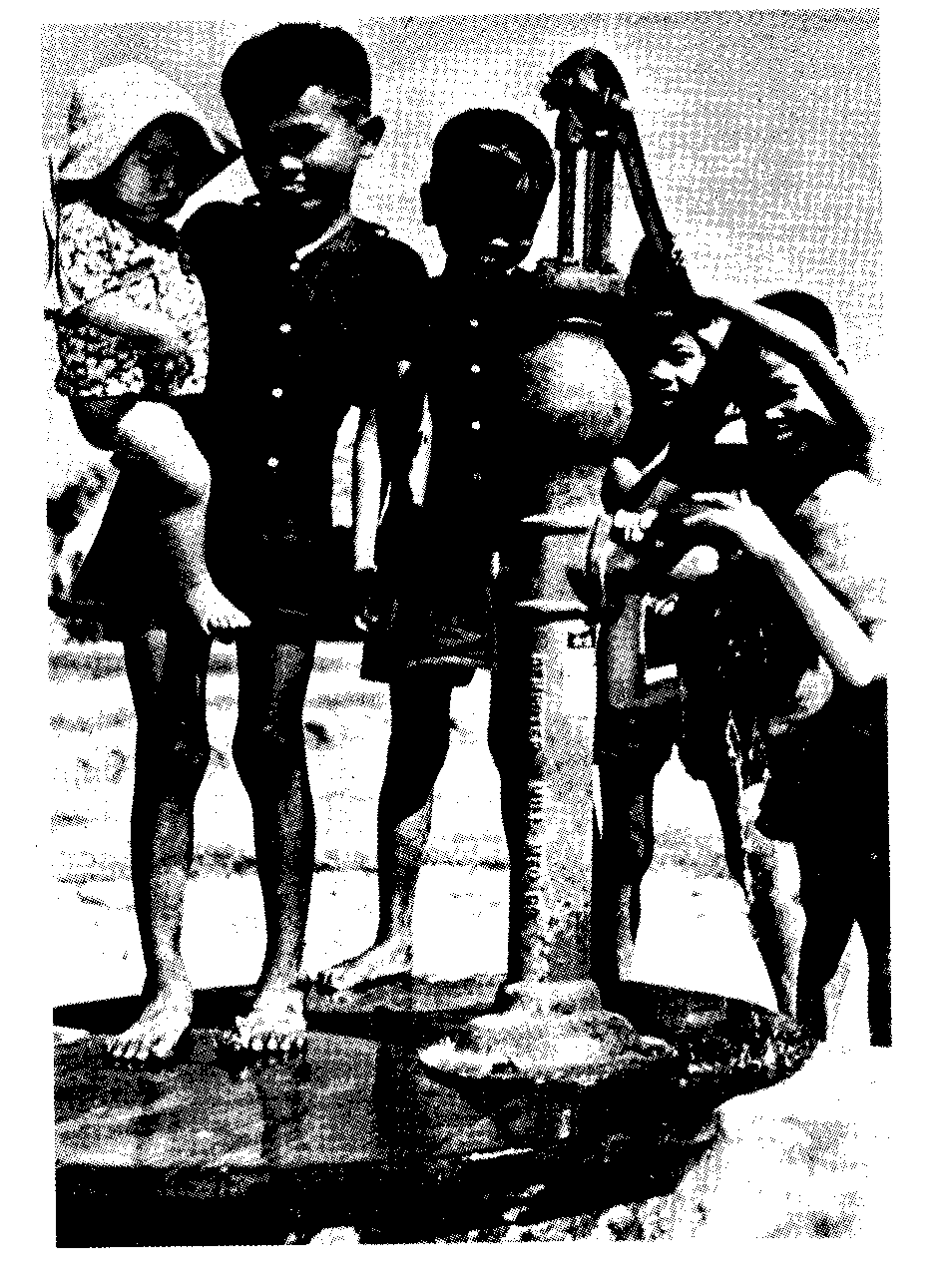
Developing Water Sources
There are three
main sources of water
for small water-supply systems:
ground
water, surface water and rainwater.
The
entries which follow describe the methods
of getting water from these three sources:
1. Getting Ground
Water from Wells and
Springs.
2. Building Small
Dams to Collect Surface
Water.
3. Collecting
Rainwater in Cisterns.
The choice of the
source of water depends
on local circumstances.
A study
of the local area should be made to determine
which source is best for providing
water which is (1) safe and wholesome,
(2) easily available and (3) sufficient
in quantity.
Once the water is made available, it
must be brought from where it is to where
it is needed and steps must be taken to
be sure that it is pure.
These subjects
are covered in sections on:
Water Lifting
Water Transport
Water Purification
An added section on
Map Making gives
guidelines which will be helpful in irrigation
and drainage projects.
* * * * *
GETTING GROUND WATER FROM WELLS AND SPRINGS
This section
explains ground water and
then describes a variety of methods of
collecting ground water:
1. Tubewells
a.
Well Casing and Platforms
b.
Hand-Operated Drilling Equipment
c.
Driving Wells
2. Dug Wells
3. Spring
Development
Ground Water
Ground water is
subsurface water which
fills small openings (pores) of loose
sediments (such as sand and gravel) or
rocks. For example,
if we took a clear
glass bowl, filled it with sand, and then
poured in some water, we would notice
the water "disappear" into the sand (see
Figure 1). However,
if we looked through
uwr1x3.gif (486x486)
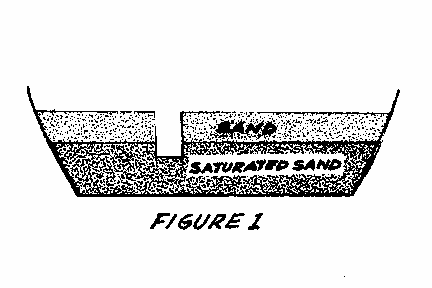
the side of the bowl, we would see water
in the sand, but below the top of the
sand. The sand
containing the water is
said to be saturated.
The top of the
saturated sand is called the water table,
it is the level of the water in the sand.
The water beneath
the water table is
true ground water available (by pumping)
for human use. There
is water in the soil
above the water table, but it does not
flow into a well and is not available for
usage by pumping.
If we inserted a
straw into the saturated
sand in the bowl in Figure 1 and
sucked on the straw, we would obtain some
water (initially, we would get some sand
too). If we sucked
long enough, the water
table or water level would drop toward
the bottom of the bowl.
This is exactly
what happens when water is pumped from a
well drilled below the water table.
The two basic
factors in the occurrence
of ground water are:
(1) the presence
of water, and (2) a medium to "house"
the water. In
nature, water is primarily
provided by precipitation (rain and
snow), and secondarily, by surface water
features (rivers and lakes).
The medium
is porous rock or loose sediments.
The most abundant
ground-water reservoir
occurs in the loose sands and gravels
in river valleys.
Here the water table
roughly parallels the land surface, that
is, the depth to the water table is generally
constant.
Disregarding any drastic
changes in climate, natural ground-water
conditions are fairly uniform or balanced.
In Figure 2, the water poured into the
uwr2x4.gif (486x486)
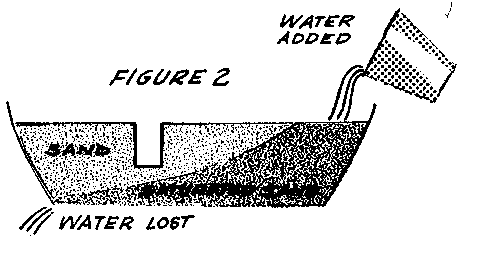
bowl (analogous to precipitation) is balanced
by the water discharging out of the
bowl at the lower elevation (analogous to
discharge into a stream).
This movement
of ground water is slow, generally centimeters
or inches per day.
When the water
table intersects the
land surface, springs or swamps are
formed (see Figure 3).
During a particularly
uwr3x5.gif (540x540)
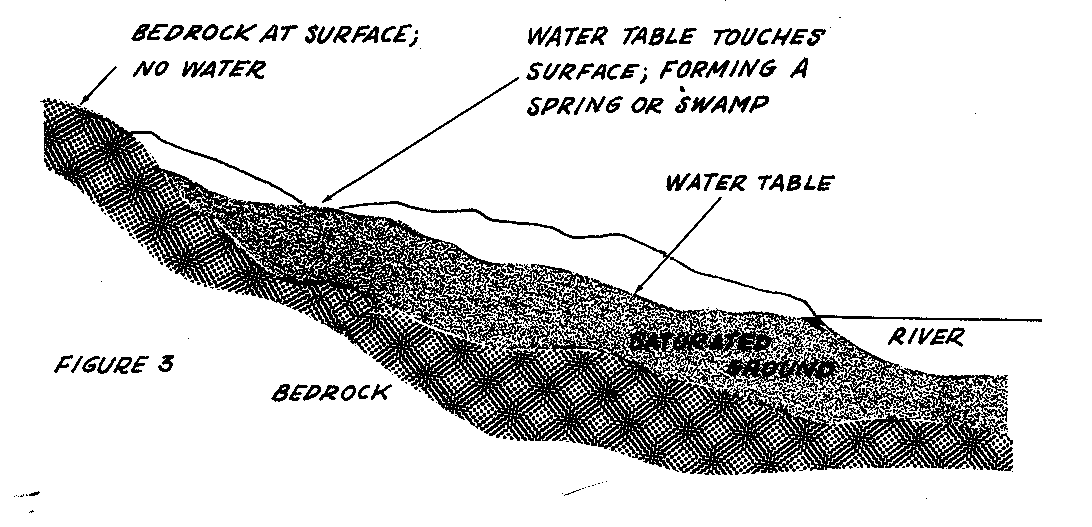
wet season, the water table will
come much closer to the land surface than
it normally does and many new springs or
swampy areas will appear.
On the other
hand, during a particularly dry season,
the water table will be lower than normal
and many springs will "dry up."
Many
shallow wells may also "go dry."
Flow of Water to Wells
A newly dug well
fills with water a
meter or so (a few feet) deep, but after
some hard pumping it becomes dry.
Has
the well failed? Was it dug in the wrong
place? More likely you are witnessing
the phenomenon of drawdown, an effect
every pumped well as on the water table,
(see Figure 4).
uwr4x5.gif (486x486)
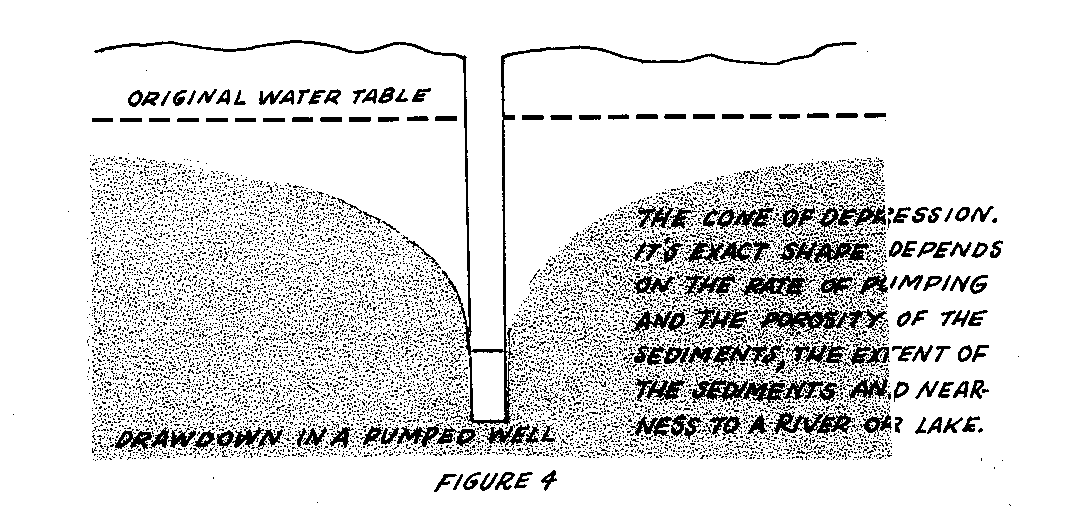
Because water flows
through sediments
slowly, almost any well can be pumped dry
temporarily if it is pumped hard enough.
Any pumping will lower the water level
to some degree, in the manner shown in
Figure 4. A serious
problem arises only
when the drawdown due to normal use lowers
the water table below the level of the
well.
After the well has
been dug about a
meter (several feet) below the water
table, it should be pumped at about the
rate it will be used to see if the flow
into the well is adequate.
If it is not
sufficient, there may be ways to improve
it. Digging the well
deeper or wider will
not only cut across more of the water-bearing
layer to allow more flow into the
well, but it will also enable the well to
store a greater quantity of water which
may seep in overnight.
If the well is
still not adequate and can be dug no
deeper, it can be widened further, perhaps
lengthened in one direction, or
more wells can be dug.
If it is possible
to do so safely, another method is
to dig horizontal tunnels out from the
bottom of the well.
The goal of all
these methods is to intersect more of
the water-bearing layers, so that the
well will produce more water without
lowering the water table to the bottom
of the well.
Where to Dig a Well
Four important
factors to consider in
choosing a well site are:
1. Nearness to
Surface Water
2. Topography
3. Sediment Type
4. Nearness to Pollutants
1. Nearness to
Surface Water
If there is any
surface water nearby,
such as a lake or a river, locate the
well as near it as possible.
It is likely
to act as a source of water and keep
the water table from being lowered as
much as without it.
This does not always
work well, however, as lakes and
slow-moving bodies of water generally
have silt and slime on the bottom, which
prevent water from entering the ground
quickly.
There may not seem
to be much point to
digging a well near a river, but the filtering
action of the soil will result in
water that is cleaner and more free of
bacteria. It may
also be cooler than
surface water. If
the river level fluctuates
during the year, a well will give
cleaner water (than stream water) during
the flood season, although ground water
often gets dirty during and after a flood;
a well will also give more reliable water
during the dry season, when the water
level may drop below the bed of the river.
This method of water supply is used by
some cities: a large
well is sunk next
to a lake or river and horizontal tunnels
are dug to increase the flow.
Wells near the
ocean, and especially
those on islands, may have not only the
problem of drawdown but that of salt
water encroachment.
The underground
boundary between fresh and salt water
generally slopes inland:
Because salt
water is heavier than fresh water, it
flows in under it.
If a well near the
shore is used heavily, salt water may
come into the well as shown in Figure 5.
uwr5x6.gif (437x437)
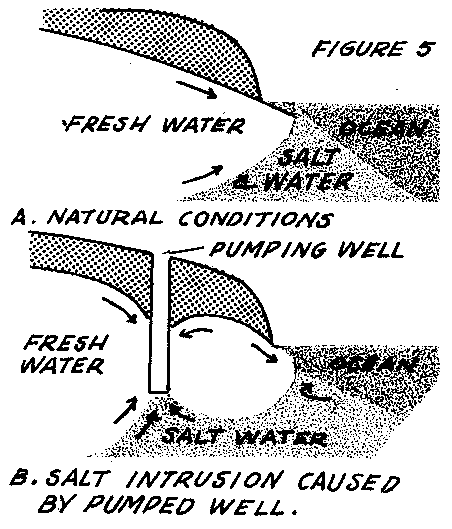
This should not occur in wells from which
only a moderate amount of water is drawn.
2. Topography
Ground water, being
liquid, gathers in
low areas.
Therefore, the lowest ground
is generally the best place to drill or
dig. If your area is
flat or steadily
sloping, and there is no surface water,
one place is as good as another to start
drilling or digging.
If the land is
hilly, valley bottoms are the best places
to look for water.
You may know of a
hilly area with a
spring on the side of a hill.
Such a
spring could be the result of water moving
through a layer of porous rock or a
fracture zone in otherwise impervious
rock. Good water
sources can result
from such features.
If you can see
layers of rock sticking out of the hillside,
you may be able to guess where a
water-bearing layer can be found by digging
down from higher on the hill.
This
is because most layers continue over
short distances.
3. Sediment Type
Ground water occurs
in porous or fractured
rocks of sediments.
Gravel, sand
and sandstone are more porous than clay,
unfractured shale and granite or "hard
rock."
Figure 6 shows in a
general way the relationship
uwr6x8.gif (600x600)
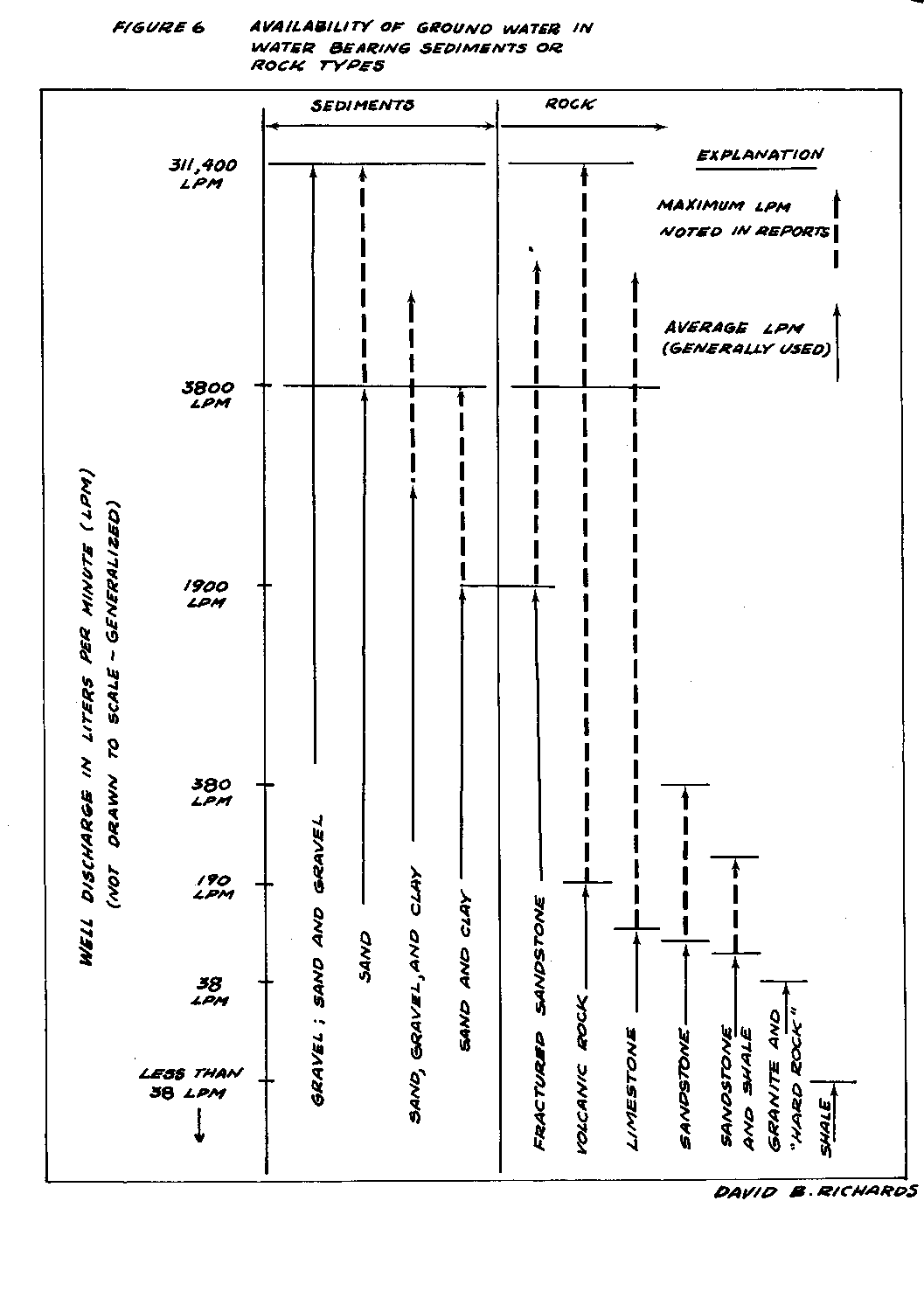
between the availability of
ground water (expressed by typical well
discharges) and geologic material (sediments
and various rock types).
For
planning the well discharge necessary
for irrigating crops, a good rule of
thumb for semi-arid climates -- 37.5cm
(15") of precipitation a year -- is a
1500 to 1900 liters (400 to 500 U.S.
gallons) per minute well which will irrigate
about 65 hectares (160 acres) for
about 6 months. From
Figure 6, we see
that wells in sediments are generally
more than adequate.
However, enough
ground water can be obtained from rock,
if necessary, by drilling a number of
wells. Deeper water
is generally of
better quality. Water
from shallow wells
is generally harder than water from rock
aquifers; this may be important for hospitals
and some industries.
Sand and gravel are
normally porous and
clay is not, but sand and gravel can contain
different amounts of silt and clay
which will reduce their ability to carry
water. The only way
to find the yield
of a sediment is to dig a well and pump
it.
In digging a well,
be guided by the results
of nearby wells, the effects of
seasonal fluctuations on nearby wells,
and keep an eye on the sediments in your
well as it is dug.
In many cases you
will find that the sediments are in
layers, some porous and some not.
You
may be able to predict where you will
hit water by comparing the layering in
your well with that of nearby wells.
Figures 7, 8 and 9
illustrate several
uwrx10.gif (600x600)

sediment situations and give guidelines
on how deep to dig wells.
4. Nearness to
Pollutants
If pollution is in
the ground water, it
moves with it.
Therefore, a well should
always be uphill and 15 to 30 meters (50
to 100 feet) away from a latrine, barnyard,
or other source of pollution.
If
the area is flat, remember that the flow
of ground water will be downward, like a
river, toward any nearby body of surface
water. Locate a well
in the upstream
direction from pollution sources.
The deeper the
water table, the less
chance of pollution because the pollutants
must travel some distance downward before
entering ground water.
The water is purified
as it flows through the soil.
Extra water added
to the pollutants
will increase their flow into and through
the soil, although it will also help dilute
them. Pollution of
ground water is
more likely during the rainy than the
dry season, especially if a source of
pollution such as a latrine pit is allowed
to fill with water.
See also
"Introduction to Sanitary Latrines,"
p. 147. Similarly, a
well that is
heavily used will increase the flow of
ground water toward it, perhaps even reversing
the normal direction of ground
water movement. The
amount of drawdown
is a guide to how heavily the well is
being used.
Polluted surface
water must be kept
out of the well pit.
This is done by
casing and sealing the well.
Well Casing and Seal
The purpose of
casing and sealing wells
is to prevent contaminated surface water
from entering the well or nearby ground
Water. As water will
undoubtedly be
spilled from any pump, the top of the well
must be sealed with a concrete slab to let
the water flow away rather than re-enter
the well directly.
It is also helpful to
build up the pump area with dirt to form
a slight hill which will help drain away
spilled water and rain water.
Figure 6. Availability of ground water
uwr6x8.gif (600x600)

from various sediments and rock types.
Aquifers (water-bearing sediments) of Sand
and Gravel.
Generally yield 11,400 1pm
(3000 gpm) (but
they may yield less depending
on pump, well
construction and
well development.
Aquifers of Sand, Gravel, and Clay (Intermixed
or
Interbedded). Generally yield
between 1900 1pm
(500 gpm) and 3800 1pm
(1000 gpm), but can
yield more--between
3800 1 pm (1000
gpm) and 11,400 1pm (3000
gpm)--depending on
the percentage of the
constituents.
Aquifers of Sand and Clay. Generally yield
about 1900 1pm (500
gpm) but may yield as
much as 3800 1pm
(1000 gpm).
Aquifers of Fractured Sandstone. Generally
yield about 1900
1pm (500 gpm) but may
yield more than
3800 1pm (1000 gpm) depending
on the thickness of
the sandstone
and the degree and
extent of fracturing
(may also yield
less than 1900 1 pm (500
gpm) if thin and poorly fractured or
interbedded
with clay or
shale).
Aquifers of Limestone. Generally yield between
38 1pm (10 gpm) and
190 1pm (50 gpm)
but have been known
to yield more than 3800
1pm (1000 gpm) due
to caverns or nearness
to stream, etc.
Aquifers of Granite and/or "Hard Rock". Generally
yield 38 1pm (10
gpm) and may yield
less (enough for
small household).
Aquifers of Shale. Yield less than 38 1pm
(10 gpm), not much
good for anything except
as a last resort.
Casing is the term
for the pipe, cement
ring or other material that supports the
well wall. It is
usually impermeable in
the upper part of the well to keep out
polluted water (see Figure 7) and may be
uwr7x10.gif (300x600)
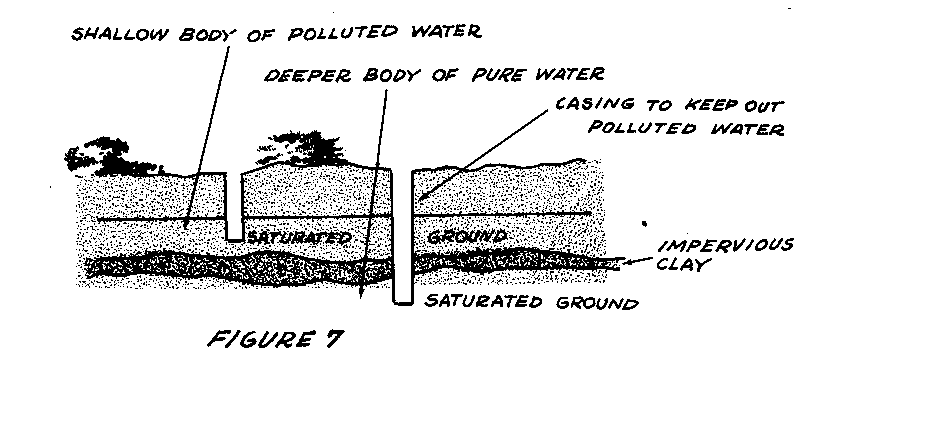
perforated or absent in the lower part of
the well to let water enter.
See also
"Well Casing and Platforms," p. 12, and
"Reconstructing Dug Wells," p. 59.
In loose sediment,
the base of the
well should consist of a perforated
casing surrounded by coarse sand and
small pebbles; otherwise, rapid pumping
may bring into the well enough material
to form a cavity and collapse the well
itself. Packing the
area around the
well hole in the water-bearing layer with
fine gravel will prevent sand from washing
in and increase the effective size
of the well. The
ideal gradation is from
sand to 6mm (1/4") gravel next to the
well screen. In a
drilled well it way
be added around the screen after the pump
pipe is installed.
Well Development
Well development refers to the steps
taken after a well is drilled to insure
maximum flow and well life by preparing
the sediments around the well.
The layer
of sediments from which the water is
drawn often consists of sand and silt.
When the well is first pumped, the fine
material will be drawn into the well and
make the water muddy.
You will want to
pump out this fine material to keep it
from muddying the water later and to make
the sediments near the well more porous.
However, if the water is pumped too
rapidly at first, the fine particles may
collect against the perforated casing or
the sand grains at the bottom of the
well and block the flow of water into it.
A method for
removing the fine material
successfully is to pump slowly until the
water clears, then at successively higher
rates until the maximum of the pump or
well is reached.
Then the water level
should be permitted to return to normal
and the process repeated until consistently
clear water is obtained.
Another method is
surging, which is
moving a plunger (an attachment on a
drill rod) up and down in the well.
This
causes the water to surge in and out of
the sedimentary layer and wash loose the
fine particles, as well as any drilling
mud stuck on the wall of the well.
Coarse
sediment washed into the well can be removed
by a bailing bucket, or it may be
left in the bottom of the well to serve
as a filter.
Sources:
Michael T. Field, VITA Volunteer, Schenectady,
New York
John Chronic, VITA Volunteer, Boulder,
Colorado
David B. Richards, VITA Volunteer, Fort
Collins, Colorado
Yaron M. Sternberg, VITA Volunteer,
Bloomington, Indiana.
A Primer on Ground Water, H. L. Baldwin
and C. L. McGuinness, U. S. Government
Printing Office, Washington, D. C., 1964,
26 pages, U.S. $0.25
This inexpensive booklet discusses ground
water in more detail than this article
and is a useful reference for anyone working
with wells.
Ground Water Hydrology, D. K. Todd, Wiley
& Sons, New York, 1959, 336 pages, U.S.
$0.95.
One of several textbooks available, this
book describes the mathematical approach
to ground water study.
It also contains
much information on related subjects such
as well development and water law.
Water Supply for Rural Areas and Small
Communities, E. G. Wagner an J. N.
Lanoix, World Health Organization,
Geneva, 1959, 340 pages, $6.75.
This excellent book has a variety of information
on ground water, wells, and
water systems, all aimed at the village
level.
Hydrogeology, S. N. Davis and R. J. M.
DeWiest, Wiley & Sons, New York, 1966,
300 pages, U.S. $11.00
Another textbook, but concentrates on
the importance of geology on the occurrence
of ground water.
Water Well Handbook, K. E. Anderson,
Missouri Water Well Drillers Association,
P. 0. Box 250, Rolla, Missouri, 1965,
281 pages, U.S. $3.00.
Comprehensive handbook used by well
drillers and field engineers; includes
charts, tables, and other data dealing
with drilling equipment, hardware associated
with well construction and installation
of pumps. Many
consider
this the practical bible of water wells.
Ground Water and Wells, Edward E. Johnson,
Inc., Saint Paul, Minnesota 55104, 440
pages, 1966, about $5.00.
An excellent semi-technical reference book
used by the water-well industry covering
such items as: ground water occurrence,
well design as related to geology, well
drilling, well maintenance, and well operation.
Wells, Department of the Army, Technical
Manual (TM 5-297), 1957, Superintendent
of Documents, U.S. Government Printing
Office, Washington 25, D.C., 264 pages,
$1.00.
An elementary, comprehensive book on well
drilling and well construction.
Easy to
read and understand, but not as up to
date as the other references above.
Small Water Supplies, Bulletin No. 10,
The Ross Institute, Keppel Street (Gower
Street), London, W.C. 1, England, 1967,
67 pages.
TUBEWELLS
Where soil conditions
permit, the tubewells
described here will, if they have
the necessary casing, provide pure
water. They are much
easier to install
and cost much less than large diameter
wells.
Tubewells will
probably work well
where simple earth borers or earth
augers work (i.e., alluvial plains with
few rocks in the soil), and where there
is a permeable water-bearing layer 15
to 25 meters (50 to 80 feet) below
the surface. They
are sealed wells,
and consequently sanitary, which offer
no hazard to small children.
The
small amounts of materials needed keep
the cost down. These
wells may not
yield enough water for a large group,
but they would be big enough for a family
or a small group of families.
The storage
capacity in small diameter
wells is small. Their
yield depends
largely on the rate at which water
flows from the surrounding soil into
the well. From a
saturated sand layer,
the flow is rapid.
Water flowing in
quickly replaces water drawn from the
well. A well which
taps such a layer
seldom goes dry. But
even when water-bearing
sand is not reached, a well with
even a limited storage capacity may
yield enough water for a household.
Well Casing and Platforms
In home or village
wells, casing and
platforms serve two purposes: (1) to
keep well sides from caving in, and
(2) to seal the well and keep any
polluted surface water from entering
the well.
Two low-cost casing
techniques are
described here:
1. Method A, from an
American Friends
Service Committee
(AFSC) team in
Rasulia, Madhya Pradesh,
India.
2. Method B, from an
International
Voluntary
Services (IVS) team in
Vietnam.
Method A. (See Figure 1)
uwr1x13.gif (600x600)

Tools and Materials
Asbestos cement, tile, concrete, or
even galvanized
iron will do.
Casing pipe (from pump to water-bearing
layer to below
minimum
water table).
Sand
Gravel
Cement
Device for lowering and placing
casing (see Figure
2).
uwr2x13.gif (486x486)

Drilling rig - see "Tubewell Boring"
Foot valve, cylinder, pipe, handpump.
The well hole is
dug as deep as
possible into the water-bearing strata.
The diggings are placed near the hole
to make a mound, which later will
serve to drain spilled water away from
the well. This is important because
backwash is one of the few sources of
contamination for this type of well.
The entire casing pipe below water
level should be perforated with many
small holes no larger than 5mm (3/16")
in diameter. Holes
larger than this
will allow coarse sand to be washed
inside and plug up the well.
Fine
particles of sand, however, are expected
to enter. These
should be small
enough to be pumped immediately out
through the pump; This keeps the well
clear. The first
water from the new
well may bring with it large quantities
of fine sand. When
this happens, the
first strokes should be strong and
steady and continued until the water
comes clear.
Perforated casing
is lowered, bell end
downward, into the hole using the device
shown in Figure 2.
When the casing
is properly positioned, the trip
cord is pulled and the next section prepared
and lowered. Since
holes are
easily drilled in asbestos cement pipe,
they can be wired together at the joint
and lowered into the well.
Be sure the
bells point downward, since this will
prevent surface water or backwash from
entering the well without the purifying
filtration effect of the soil; it will
also keep sand and dirt from filling
the well. Install
the casing vertically
and fill the remaining space with
pebbles. This will
hold the casing
plumb. The casing
should rise 30 to
60cm (1' to 2') above ground level and
be surrounded with a concrete pedestal
to hold the pump and to drain spilled
water away from the hole.
Casing
joints within 3 meters (10 feet) of the
surface should be sealed with concrete
or bituminous material.
Method B
Plastic seems to be
an ideal casing
material, but because it was not
readily available, the galvanized
iron and concrete casings described
here were developed in the Ban Me Thuot
area of Vietnam. The
materials for one
20 meter (65') well, not including a
pump, cost about U.S. $17 in 1959.
Tools and Materials
Wooden V-bloc, 230cm (7 1/2') long
(see Figure 3)
uwr3x14.gif (145x437)

Angle iron, 2 sections, 230cm (7 1/2')
long
Pipe, 10cm (4") in diameter, 230cm
(7 1/2') long
Clamps
Wooden mallet
Soldering Equipment
Galvanized sheet metal: 0.4mm x 1 meter
x 2 meter
(0.016" x 39 112" x 79")
sheets
Plastic Casing
Black plastic pipe
for sewers ana
drains was almost ideal.
Its friction
joints could be quickly slipped together
and sealed with a chemical solvent.
It seemed durable but was light
enough to be lowered into the well by
hand. It could be
easily sawed or
drilled to make a screen.
Care must
be taken to be sure that any plastic
used is not toxic.
Galvanized Sheet Metal Casing
Galvanized sheet
metal was used to
make casing similar to downspouting.
A thicker gauge than the 0.4mm (0.016")
available would have been preferable.
Because the sheet metal would not
last indefinitely if used by itself,
the well hole was made oversize and
the ring-shaped space around the casing
was filled with a thin concrete
mixture which formed a cast concrete
casing and seal outside the sheet
metal when it hardened.
The 1 meter x 2
meter (39 1/2" x
79") sheets were cut lengthwise into
three equal pieces which yielded three
2-meter (79") lengths of 10cm (4")
diameter pipe.
The edges were
prepared for making
seams by clamping them between the
two angle irons, and then pounding
the edges with a wooden mallet to
the shape shown in Figure 3.
The seam is made
slightly wider at
one end than at the other to give
the pipe a slight taper which allows
successive lengths to be slipped a
short distance inside one another.
The strips are
rolled by bridging them
over a 2-meter (79") wooden V-shaped
block and applying pressure from above
with a length of 5cm (2") pipe (see
Figure 4). The sheet
metal strips are
uwr4x15.gif (180x540)

shifted from side to side over the V-block
as they are being bent to produce
as uniform a surface as possible.
When the strip is bent enough, the two
edges are hooked together and the 5cm
(2") pipe is slipped inside.
The ends
of the pipe are set up on wooden blocks
to form an anvil, and the seam is firmly
crimped as shown in Figure 4.
After the seam is
finished, any
uwr5x15.gif (162x486)

irregularities in the pipe are removed
by applying pressure by hand or with
the wooden mallet and pipe anvil.
A
local tinsmith and his helper were able
to make six to eight lengths (12-16
meters) of the pipe per day.
Three
lengths of pipe were slipped together
and soldered as they were made, and
the remaining joints had to be soldered
as the casing was lowered into the well.
The lower end of the pipe was perforated
with a hand drill to form a screen.
After the casing was lowered to the
bottom of the well, fine gravel was
packed around the perforated portion
of the casing to above the water
level.
The cement grouting
mortar which was
used around the casings varied from
pure cement to a 1:1 1/2 cement : sand
ratio mixed with water to a very plastic
consistency. The
grout was put around
the casing by gravity and a strip of
bamboo about 10 meters (33 feet) long
was used to "rod" the grout into place.
A comparison of volume around the
casing and volume of grouting used
indicated that there may have been some
voids left probably below the reach of
the bamboo rod.
These are not serious
however, as long as a good seal is
obtained for the first 8 to 10 meters
(26 to 33 feet) down from the surface.
In general, the greater proportion of
cement used and the greater the space
around the casing, the better seemed
to be the results obtained.
However,
insufficient experience has been obtained
to reach any final conclusions.
In addition, economic considerations
limit both of these factors.
Care must be taken
in pouring the
grout. In one case,
two sections of
casing were not assembled perfectly
straight: the casing, as a result,
was not centered in the well, the
pressure of the grouting was not equal
all the way around, and the casing collapsed.
With reasonable care,
pouring the grout in several stages
and allowing it to set in-between
should eliminate this.
The grouting,
however, cannot be poured in too many
stages because a considerable amount
sticks to the sides of the well each
time, reducing the space for successive
pourings to pass through.
A proposed
modification of the above
method which has not yet been tried is
as follows: In areas such as Ban Me
Thuot, where the structure of the
material through which the well is
drilled is such that there is little
or no danger of cave-in, the casing
serves only one purpose, as a sanitary
seal. It is
therefore proposed that
the well be cased only about 8 meters
(26 feet) down from the ground surface.
To do this, the well would be
drilled to the desired depth with a
diameter roughly the same as that of
the casing. The well
would then be
reamed out to a diameter 5 to 6cm (2"
to 2 1/4") larger than the casing
down to the depth the casing will go.
A flange fitted at the bottom of the
casing with an outside diameter about
equal to that of the reamed hole will
center the casing in the hole and
support the casing on the shoulder
where the reaming stopped.
Grouting
would then be poured as in the original
method. This
modification would (1)
save considerable costly material,
(2) allow the well to be made a
smaller diameter except near the top,
(3) lessen grouting difficulties, and
(4) still provide adequate protection
against pollution.
Concrete Tile Casing
If the well is
enlarged to an adequate
diameter, precast concrete tile
with suitable joints could be used as
casing. This would
require a device
for lowering the tile into the well
one by one and releasing them at the
bottom. Mortar would
have to be used
to seal the joints above the water level,
the mortar being spread on each successive
joint before it is lowered.
Asbestos cement casing would also be
a possibility where it was available
with suitable joints.
No Casing
The last
possibility would be to use
no casing at all. It
is felt that when
finances or skills do not permit the
well to be cased, there are certain
circumstances under which an uncased
well would be superior to no well at
all. This is
particularly true in
localities where the custom is to boil
or make tea out of all water before
drinking it, where sanitation is
greatly hampered by insufficient
water supply, and where small scale
hand irrigation from wells can greatly
improve the diet by making gardens possible
in the dry season.
The danger of
pollution in an uncased
well can be minimized by: (1)
choosing a favorable site for the well
and (2) making a platform with a drain
which leads away from the well,
eliminating all spilled water.
Such a well should
be tested frequently
for pollution. If it
is found
unsafe, a notice to this effect should
be posted conspicuously near the well.
Well Platform
In the work in the
Ban Me Thuot
area, a flat 1.75 meter (5.7') square
slab of concrete was used around each
well. However, under
village conditions,
this did not work well.
Large quantities
of water were spilled, in part
due to the enthusiasm of the villagers
for having a plentiful water supply,
and the areas around wells became
quite muddy.
The conclusion was
reached that the
only really satisfactory platform would
be a round, slightly convex one with a
small gutter around the outer edge.
The gutter should lead to a concreted
drain which would take the water a considerable
distance from the well.
If the well
platform is too big and
smooth, there is a great temptation
on the part of the villagers to do
their laundry and other washing around
the well. This
should be discouraged.
In villages where animals run loose
it is necessary to build a small fence
around the well to keep out animals,
especially poultry and pigs, which
are very eager to get water, but tend
to mess up the surroundings.
Sources:
Explanatory Notes on Tubewells, by
Wendell Mott,
American Friends Service
Committee, Philadelphia, Pennsylvania,
1956 (mimeo).
Report by Richard G. Koegel, International
Voluntary Services, Ban Me
Thuot, Vietnam, 1959 (mimeo).
Hand-Operated Drilling Equipment
Two methods of
drilling a shallow
tubewell with hand-operated equipment
are described here: Method A operates
by turning an earth-boring auger;
Method B uses a ramming action.
Method A was used
by an American
Friends Service Committee (AFSC) team
in India; Method B was used by an
International Voluntary Services (IVS)
team in Vietnam.
Methods A
This simple
hand-drilling rig was
used by an American Friends Service
Committee team in India to dig wells
15 to 20cm (6" to 8") in diameter up
to 15 meters (50') deep.
Tools and Materials
Earth auger with coupling to attach
to 2.5cm (1")
drill line (see entry
on tubewell earth
augers)
Standard weight galvanized steel pipe:
For Drill Line:
4 pieces: 2.5cm (1") in diameter and
3 meters
(10') long (2
pieces have
threads on one
end only;
others need no
threads.)
2 pieces: 2.5cm (1") in diameter and
107cm (3
1/2') long
For Turning Handle:
2 pieces: 2.5cm (1") in diameter
and 61cm (2') long
2.5cm (1") T coupling
For Joint A:
4 pieces: 32mm (1 1/4") in diameter
and 30cm
(1') long
Sections and Couplings for Joint B:
23cm (9") section of 32mm (1 1/4")
diameter
(threaded at one
end only)
35.5cm (14") section of 38mm (1 1/2")
diameter
(threaded at one
end only)
Reducer coupling: 32mm to 25mm
(1
1/4" to 1")
Reducer coupling: 38mm to 25mm
(1
1/2" to 1")
8 10mm (3/8") diameter hexagonal head
machine
steel/bolts 45mm
(1 3/4") long,
with nuts
2 10mm (3/8") diameter hex head
steel
machine bolts 5cm
(2")
long, with nuts
9 10mm (3/8") steel hex nuts
To Make Toggle Bolt:
1 3mm (1/8") diameter countersink
head iron
rivet 12.5mm
(1/2")
1 1.5mm (1/16") sheet steel, 10mm
(3/8") x 25mm (1")
Drills: 3mm (1/8"), 17.5mm (13/16"),
8.75mm
(13/32")
Countersink
Thread cutting dies, unless pipe is
already threaded
Small tools: wrenches, hammer, hacksaw,
files
For platform: wood, nails, rope,
ladder
Basically the
method consists of
rotating an ordinary earth auger.
As
the auger penetrates the earth, it
fills with soil.
When full it is
pulled out of the hole and emptied.
As the hole gets deeper, more sections
of drilling line are added to extend
the shaft. Joint A
in Figures 1 and 2
uwr1x170.gif (600x486)

describe a simple method for attaching
new sections.
By building an
elevated platform 3
to 3.7 meters (10 to 12 feet) from the
ground, a 7.6 meter (25 foot) long section
of drill line can be balanced upright.
Longer lengths are too difficult
to handle.
Therefore, when the
hole gets deeper than 7.6 meters (25
feet), the drill line must be taken
apart each time the auger is removed
for emptying. Joint
B makes this
operation easier.
See Figures 1 and 3.
uwr3x170.gif (600x486)

Joint C (see
construction details
for Tubewell Earth Auger) is proposed
to allow rapid emptying of the
auger. Some soils
respond well to
drilling with an auger that has two
sides open. These
are very easy to
empty, and would not require Joint C.
Find out what kinds of augers are
successfully used in your area, and
do a bit of experimenting to find the
one best suited to your soil.
See
the entries on augers.
Joint A has been
found to be faster
to use and more durable than pipe
threaded connectors.
The pipe threads
become damaged and dirty and are difficult
to start. Heavy,
expensive pipe
wrenches get accidentally dropped into
the well and are hard to get out.
By
using a sleeve pipe fastened with two
10mm (3/8") bolts, these troubles can
be avoided. Neither
a small bicycle
wrench nor the inexpensive bolts will
obstruct drilling if dropped in.
Be
sure the 32mm (1 1/4") pipe will fit
over your 25mm (1") pipe drill line
before purchase. See
Figure 2.
uwr2x18.gif (437x437)
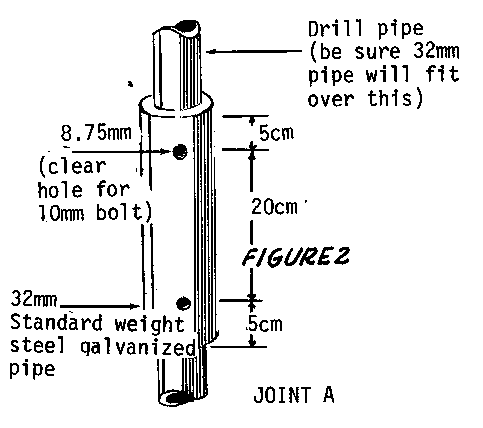
Four 3 meter (10')
sections and two
107cm (3 1/2') sections of pipe are
the most convenient lengths for drilling
a 15 meter (50') well.
Drill an
8.75mm (13/32") diameter hole through
each end of all sections of drill line
except those attaching to Joint B and
the turning handle which must be
threaded joints. The
holes should be
5cm (2") from the end.
When the well is
deeper than 7.6 meters
(25'), several features facilitate
the emptying of the auger as shown in
Figures 3 and 4.
First the full auger
uwr3x190.gif (600x600)

is pulled up until Joint B appears at
the surface. See
Figure 4A. Then a
uwr4x20.gif (600x600)
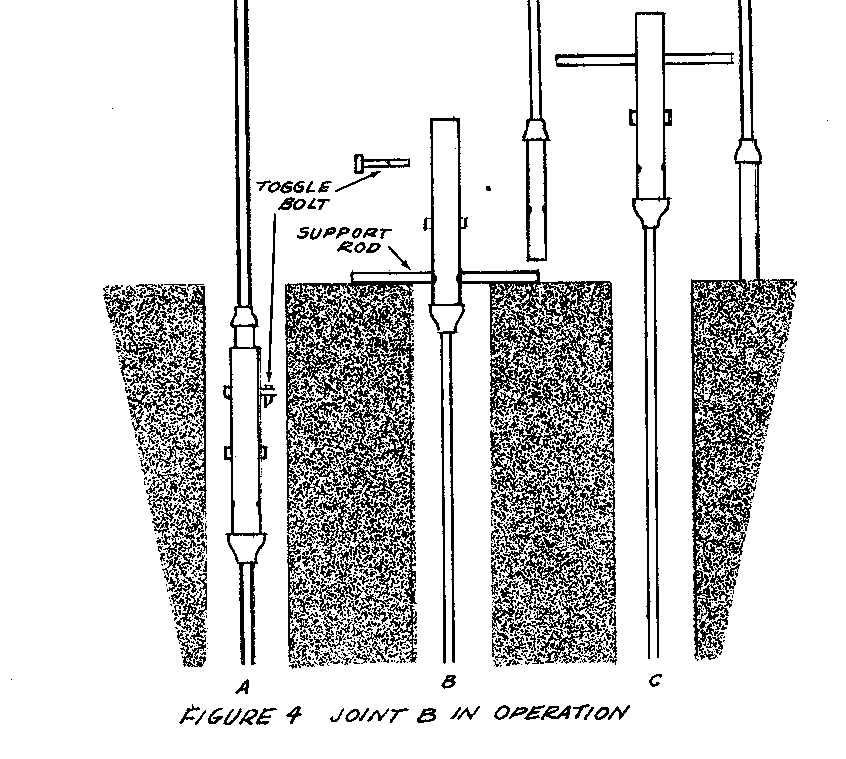
19mm (3/4") diameter rod is put through
the hole. This
allows the whole drill
line to rest on it making it impossible
for the part still in the well
to fall in. Next
remove the toggle
bolt, lift out the top section of line
and balance it beside the hole.
See
Figure 4B. Pull up
the auger, empty
uwr4x20.gif (486x486)

it, and replace the section in the
hole where it will be held by the 19mm
(3/4") rod. See
Figure 4C. Next replace
the upper section of drill
line. The 10mm
(3/8") bolt acts as a
stop which allows the holes to be
easily lined up for reinsertion of
the toggle bolt.
Finally withdraw
the rod and lower the auger for the
next drilling. Mark
the location for
drilling the 8.75mm (13/32") diameter
hole in the 32mm (1 1/4") pipe through
the toggle bolt hole in the 38mm
(1 1/2") pipe.
If the hole is located
with the 32mm (1 1/4") pipe resting on
the stop bolt, the holes are bound to
line up.
Sometimes a special
tool is needed to
penetrate a water-bearing sand layer,
because the wet sand caves in as soon
as the auger is removed.
If this happens
a perforated casing is lowered into
the well, and drilling is accomplished
with an auger that fits inside
the casing. A
percussion type with a
flap, or a rotary type with solid
walls and a flap are good possibilities.
See the entries describing these devices.
The casing will settle deeper
into the sand as sand is dug from beneath
it. Other sections
of casing
must be added as drilling proceeds.
Try to penetrate the water bearing
sand layer as far as possible, (at
least 3 feet). Ten
feet of perforated
casing embedded in such a sandy layer
will provide a very good flow of water.
Tubewell Earth Auger
This earth auger is
made from a 15cm
(6") steel tube.
Similar devices
have long been used with power drilling
equipment, but this particular design
needs field trial (see Figure 5).
uwr5x21.gif (486x486)
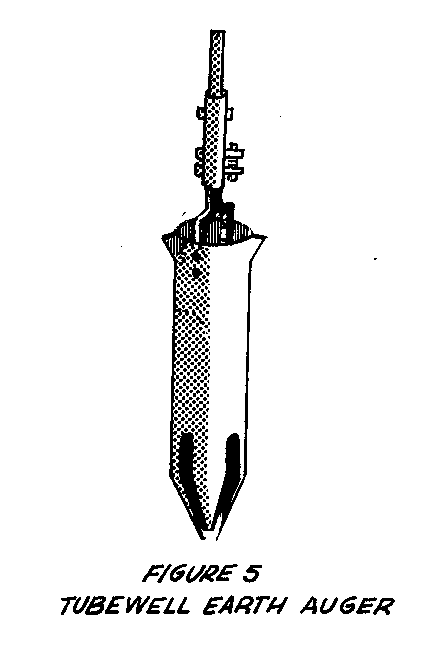
This auger can be
made without welding
equipment, but some of the bends
in the pipe and the bar can be made much
more easily when the metal is hot (see
Figure 6).
uwr6x22.gif (600x600)
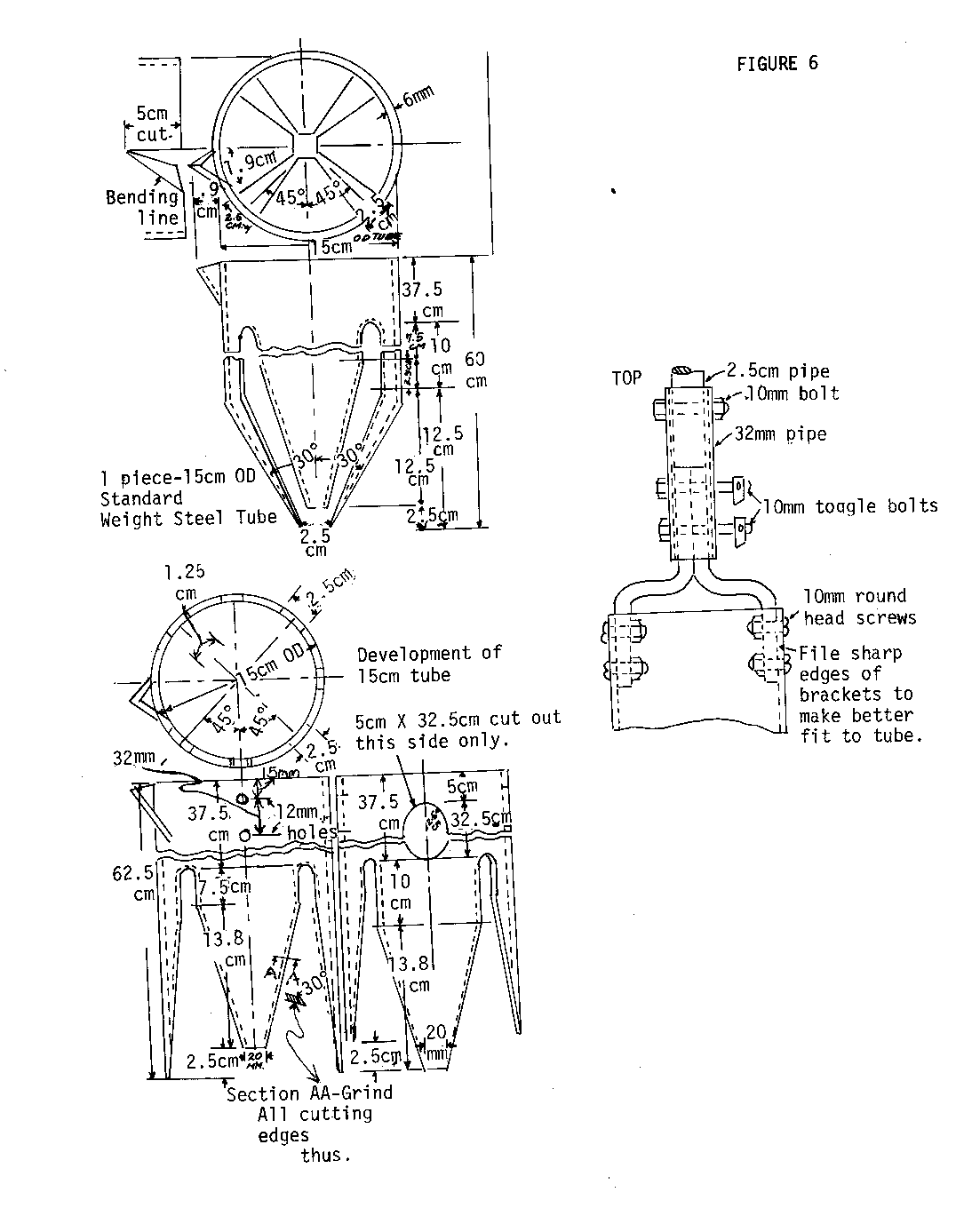
An open earth
auger, which is easier
to empty than this one, is better
suited for some soils.
This auger
cuts faster than the Tubewell Sand
Auger.
Tools and Materials
Galvanized pipe: 32mm (1 1/4") in
diameter and 21.5cm
(8 1/2") long
Hexagonal head steel bolt: 10mm
(3/8") in
diameter and 5cm (2")
long, with nut
2 hex. head steel bolts: 10mm
(3/8") in
diameter and 9.5cm
(3 3/4") long
2 Steel bars: 1.25cm x 32mm x 236.5mm
(1/2" x 1
1/4" x 9 5/16")
4 Round head machine screws: 10mm
(3/8") in
diameter and 32mm
(1 1/4") long
2 flat head iron rivets: 3mm (1/8")
in diameter and
12.5mm (1/2") long
Steel strip: 10mm x 1.5mm x 2.5cm
(3/8" x 1/16" x 1")
Steel tube: 15cm (6") outside diameter,
62.5cm (24
5/8") long
Hand tools
Source:
Wells, Technical Manual 5-297, AFM 85-23,
U.S. Army and Air Force, 1957.
Tubewell Sand Auger
This sand auger can
be used to
drill in loose soil or wet sand,
where an earth auger is not so effective.
The simple cutting head requires
less force to turn than the "Tubewell
Earth Auger," but it is more difficult
to empty. <see figure 7>
uwr7x23.gif (486x486)
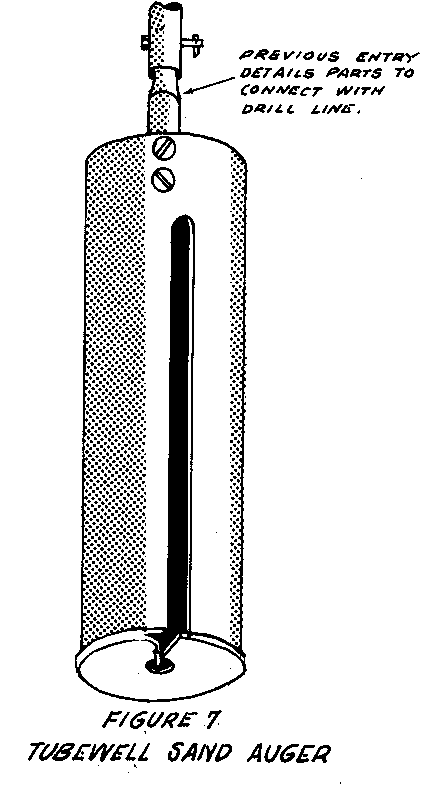
A smaller version
of the sand auger
made to fit inside the casing pipe can
be used to remove loose, wet sand.
This design needs
field trial,
although similar devices have long been
used with power drilling equipment.
Tools and Materials <see figure 8>
uwr8x24.gif (600x600)
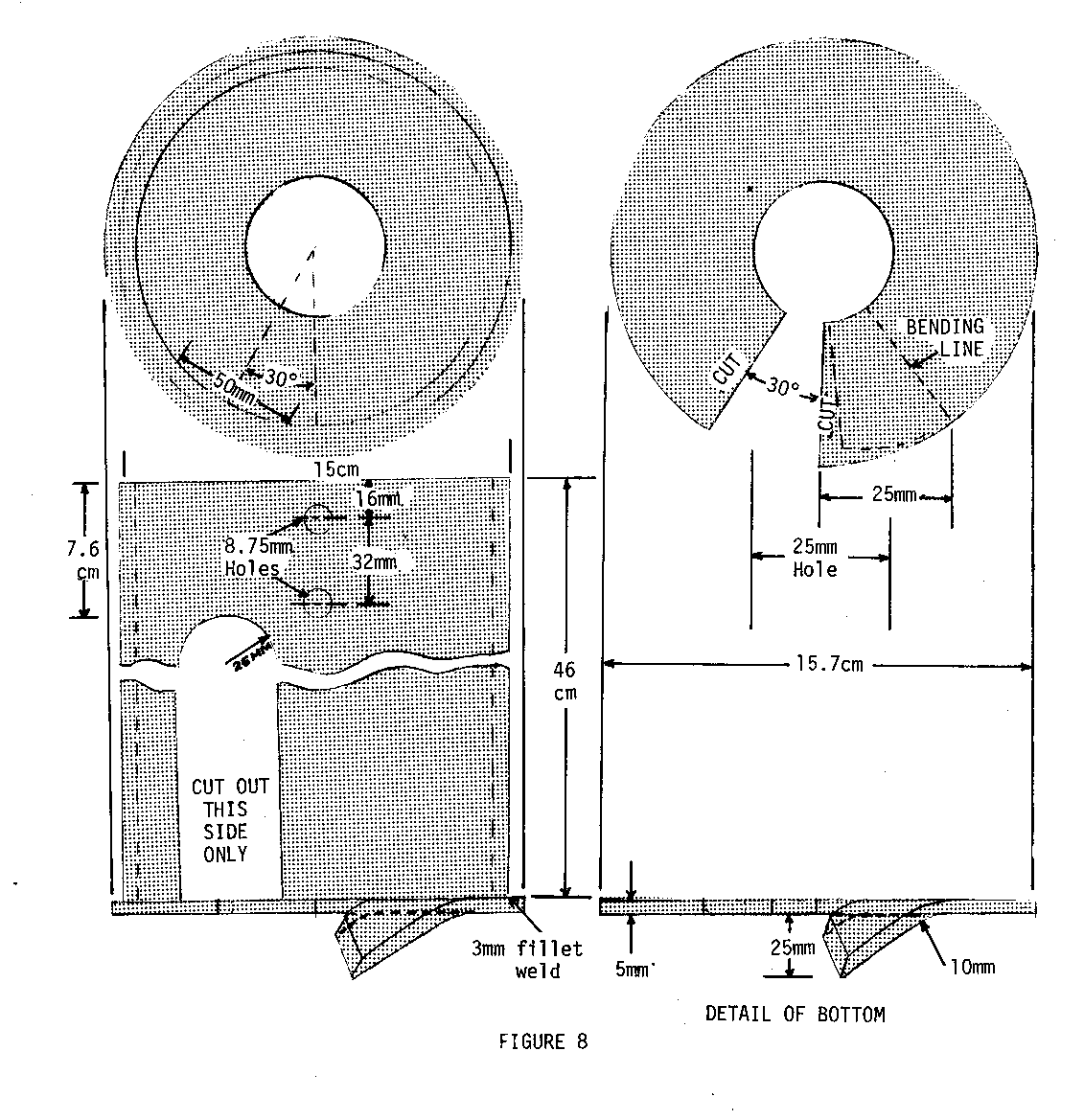
Steel tube: 15cm (6") outside diameter
and 46cm (18")
long
Steel plate: 5mm x 16.5cm x 16.5cm
(3/16" x 6
1/2" x 6 1/2")
Acetylene welding and cutting equipment
Drill
Source:
Wells, Technical Manual 5-297, AFM 85-23,
U.S. Army and Air
Force, 1957.
Tubewell Sand Bailer <see figure 9>
uwr9x25.gif (600x600)
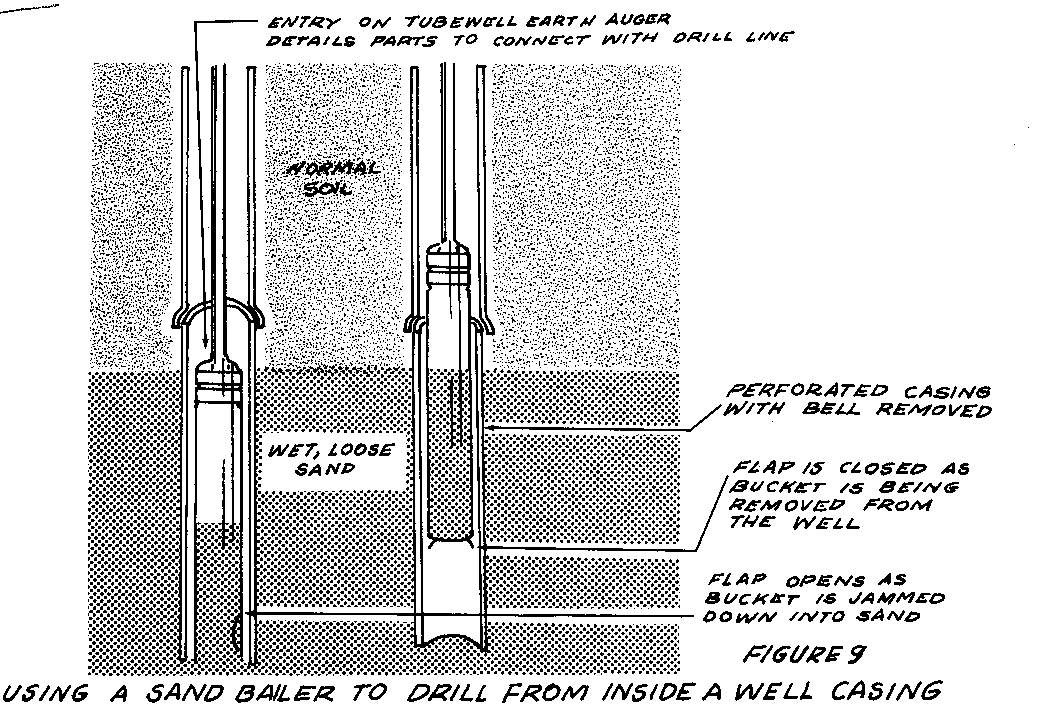
The sand bailer can
be used to drill
from inside a perforated well casing
when a bore goes into loose wet sand
and the walls start to cave in.
It has
been used in making many tubewells in
India.
Tools and Materials
Steel tube: 12.5cm (5") in diameter
and 91.5cm (3') long
Truck innertube or leather: 12.5cm
(5") square
Pipe coupling: 15cm to 2.5cm (5" to
1")
Small tools
By repeatedly
jamming this "bucket"
into the well, sand will be removed
from below the perforated casing allowing
it to settle deeper into the sand
layer. The casing
prevents the walls
from caving in. The
bell is removed
from the first section of casing; at
least one other section rests on top
of it to help force it down as digging
proceeds. Try to
penetrate the water
bearing sand layer as far as possible:
3 meters (10) of perforated casing
embedded in such a sandy layer will
usually provide a very good flow of
water.
Be sure to try your
sand "bucket" in
wet sand before attempting to use it
at the bottom of your well.
Source:
Explanatory Notes on Tubewells, by
Wendell Mott, American Friends Service
Committee, Philadelphia, Pennsylvania,
1956 (mimeo).
Method B
The equipment
described here has been
used successfully in the Ban Me Thuot
area of Vietnam. One
of the best performances
was turned in by a crew of
three inexperienced mountain tribesmen
who drilled 20 meters (65') in a day
and a half. The
deepest well drilled
was a little more than 25 meters (80');
it was completed, including the installation
of the pump, in six days.
One
well was drilled through about 11
meters (35') of sedimentary stone.
The cost of the
equipment, excluding
labor, was U.S. $35.19 in 1957 in
Vietnam.
Tools and Materials
For tool tray:
Wood: 3cm x 3cm x 150cm (1 1/4" x
1 1/4" x
59")
Wood: 3cm x 30cm x 45cm (1 1/4" x
12" x 17
3/4")
For safety rod:
Steel rod: 1cm (3/8") in diameter,
30cm (12")
long
Drill
Hammer
Anvil
Cotter pin
For auger support:
Wood: 4cm x 45cm x 30cm
(1 1/2" x
17 3/4" x 12")
Steel: 10cm x 10cm x 4mm
(4" x
4" x 5/32")
Location of the Well
Two considerations
are especially important
for the location of village
wells: (1) the average walking distance
for the village population should
be as short as possible; (2) it should
be easy to drain spilled water away
from the site to avoid creating a mud-hole.
In the Ban Me Thuot
area, the final
choice of location was in all cases
left up to the villagers.
Water was
found in varying quantities at all
the sites chosen.
(See "Getting
Ground Water from Wells and Springs.
Starting to Drill
A tripod is set up
over the approximate
location for the well (see Figure 1).
uwr1x26.gif (486x486)
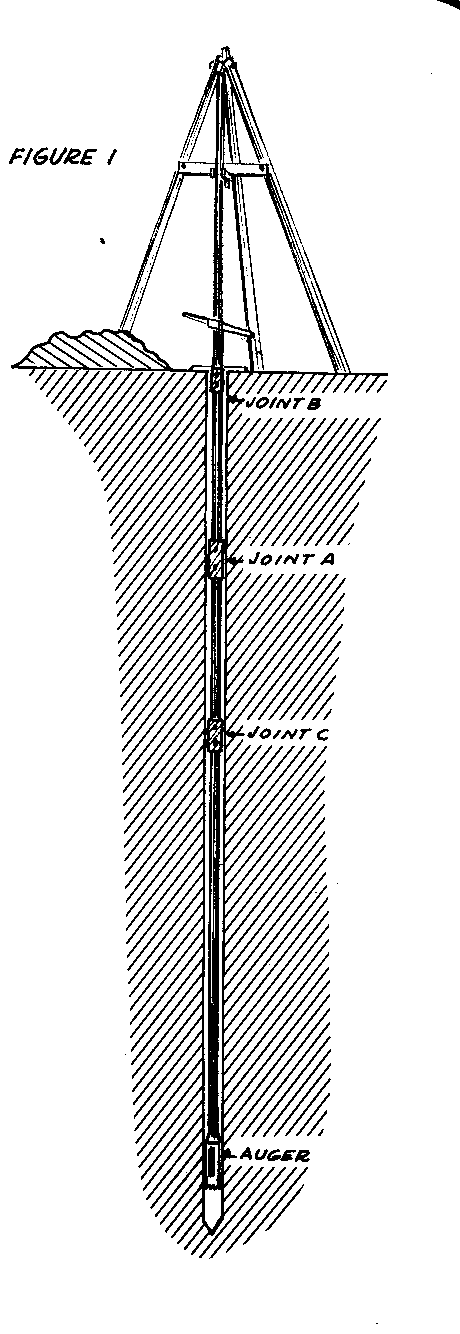
Its legs are set into shallow
holes with dirt packed around them to
keep them from moving.
To make sure
the well is started exactly vertically,
a plumb bob (a string with a stone
tied to it is good enough) is then
hung from the auger guide on the tripod's
crossbar to locate the exact
starting point. It
is helpful to dip
a small starting hole before setting
up the auger.
Drilling
Drilling is accomplished by ramming the
auger down to penetrate the earth and
then rotating it by its wooden handle
to free it in the hole before lifting
it to repeat the process.
This is a
little awkward until the auger is down
30cm to 60cm (1' to 2') and should be
done carefully until the auger starts
to be guided by the hole itself.
Usually two or three men work together
with the auger. One
system which
worked out quite well was to use
three men, two working while the third
rested, and then alternate.
As the auger goes
deeper it will be
necessary from time to time to adjust
the handle to the most convenient
height. Any wrenches
or other small
tools used should be tied by means of
a long piece of cord to the tripod so
that if they are accidentally dropped
in the well, they can easily be removed.
Since the soil of the Ban Me
Thuot area would stick to the auger,
it was necessary to keep a small amount
of water in the hole at all times for
lubrication.
Emptying the Auger:
Each time the auger is rammed down
and rotated, it should be noted how
much penetration has been obtained.
Starting with an empty auger the penetration
is greatest on the first
stroke and becomes successively less
on each following one as the earth
packs more and more tightly inside
the auger. When
progress becomes too
slow it is time to raise the auger to
the surface and empty it.
Depending
on the material being penetrated, the
auger may be completely full or have
30cm (1') or less of material in it
when it is emptied.
A little experience
will give one a "feel" for the most
efficient time to bring up the auger
for emptying. Since
the material in
the auger is hardest packed at the bottom,
it is usually easiest to empty
the auger by inserting the auger
cleaner through the slot in the side
of the auger partway down and pushing
the material out through the top of the
auger in several passes.
When the
auger is brought out of the hole for
emptying, it is usually leaned up
against the tripod, since this is
faster and easier than trying to lay
it down.
Coupling and Uncoupling Extensions
The extensions are
coupled by merely
slipping the small end of one into the
large end of the other and pinning
them together with a 10mm (3/8") bolt.
It has been found sufficient and time-saving
to just tighten the nut finger-tight
instead of using a wrench.
Each time the auger
is brought up
for emptying, the extensions must be
taken apart. For
this reason the extensions
have been made as long as
possible to minimize the number of
joints. Thus at a
depth of 18.3 meters
(60'), there are only two joints to be
uncoupled in bringing up the auger.
For the sake of
both safety and speed,
use the following procedure in coupling
and uncoupling. When
bringing up the
auger, raise it until a joint is just
above the ground and slip the auger
support (see Figures 2 and 3) into
uwr2x270.gif (437x437)
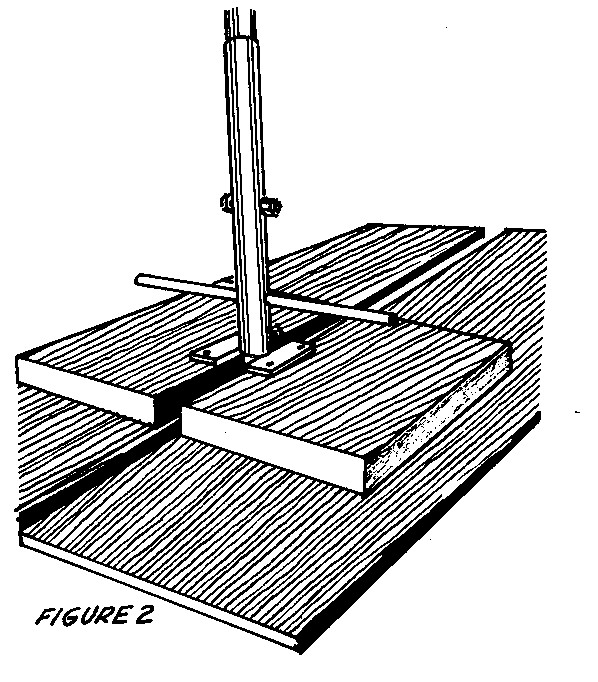
place, straddling the extension so that
the bottom of the coupling can rest on
the small metal plate.
The next step
is to put the safety rod (see Figure 4)
uwr4x28.gif (540x540)
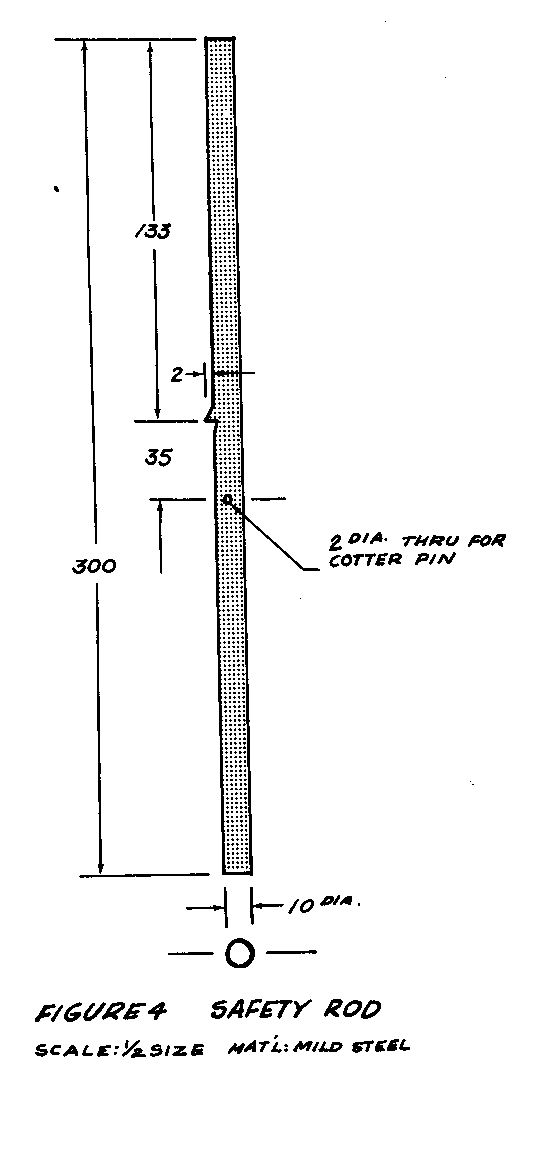
through the lower side in the coupling
and secure it with either a cotter pin
or a piece of wire.
The purpose of
the safety rod is to keep the auger
from falling into the well if it should
be knocked off the auger support or
dropped while being raised.
Once the safety rod
is in place, remove
the coupling bolt and slip the
upper extension out of the lower.
Lean the upper end of the extension
against the tripod between the two
wooden pegs in the front legs, and
rest the lower end in the tool tray
(see Figures 5 and 6).
uwr5x300.gif (353x353)
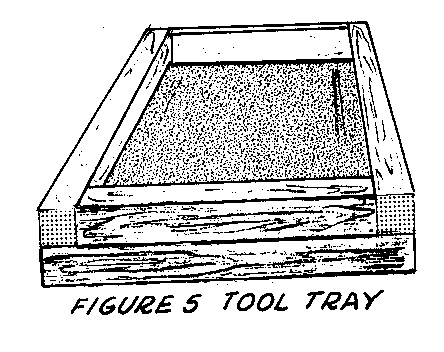
The reason
for setting the extensions in the tool
tray is to keep dirt from sticking to
the lower ends and making it difficult
to put the extensions together and
take them apart.
To couple the
extensions after emptying
the auger, the procedure is the
exact reverse of uncoupling.
Drilling Rock
When stone or other
substances which
the auger cannot penetrate are met, a
heavy drilling bit must be used.
Depth of Well
The rate at which
water can be taken
from a well is roughly proportional to
the depth of the well below the water
table as long as it keeps going into
water-bearing ground.
However, in
village wells where water can only be
raised slowly by hand pump or bucket,
this is not usually of major importance.
The important point is that in areas
where the water table varies from one
time of year to the next the well must
be deep enough to give sufficient water
at all times.
Information on the
water table variation
may be obtained from already
existing wells, or it may be necessary
to drill a well before any information
can be obtained. In
the latter case
the well must be deep enough to allow
for a drop in the water table.
Source:
Report by Richard G. Koegel, International
Voluntary Services, Ban Me
Thuot, Vietnam, 1959 (mimeo).
Equipment <see figure 7>
uwr7x32.gif (353x353)
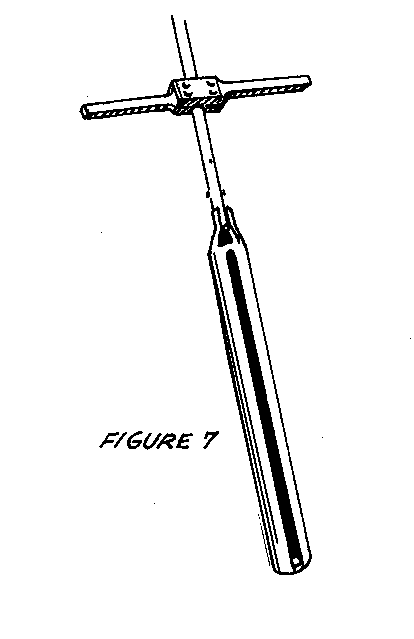
The following
section gives construction
details for the equipment
used with Method B for well-drilling:
1. Auger, Extensions and Handle
2. Auger Cleaner
3. Demountable Reamer
4. Tripod and Pulley
5. Bailing Bucket
6. Bit for Drilling Rock
Auger, Extensions and Handle
The auger is
hacksawed out of
standard-weight steel pipe about 10cm
(4") in diameter (see Figure 8).
Lightweight
uwr8x33.gif (600x600)
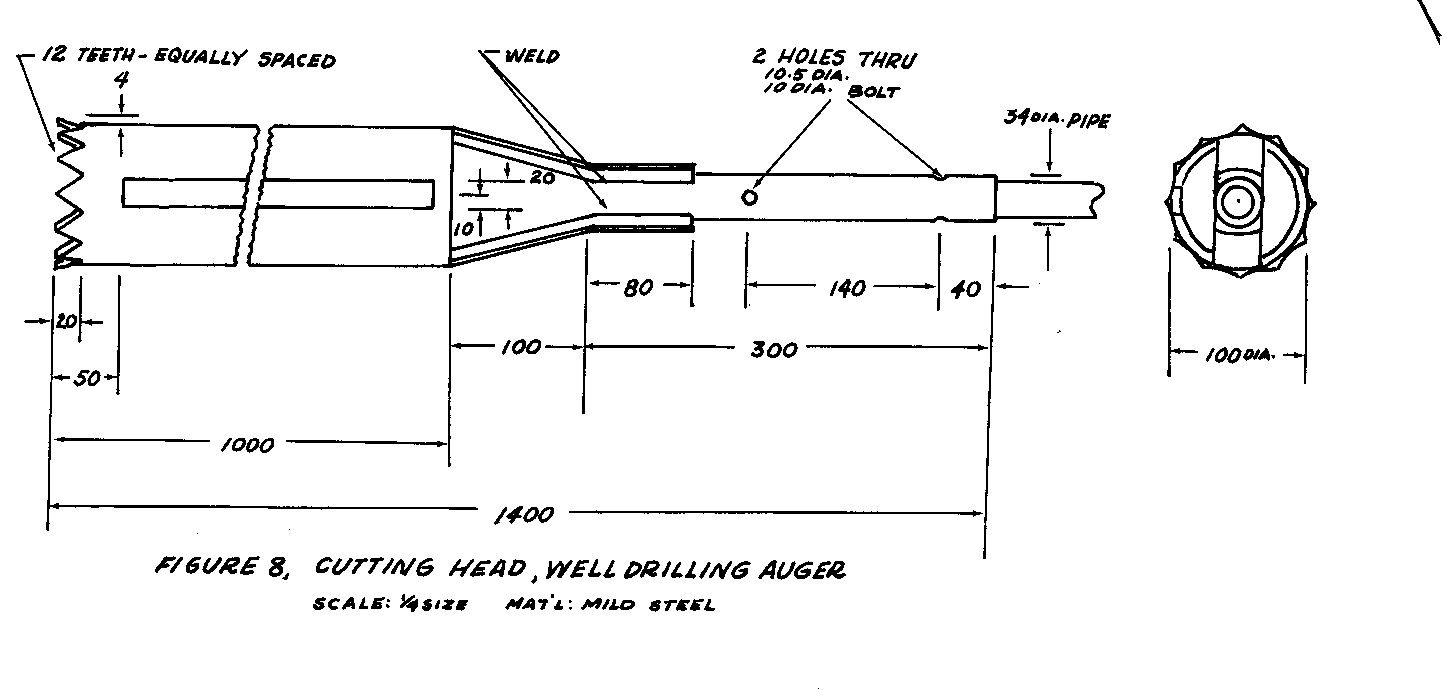
tubing is not strong enough.
The extensions (see Figure 9) and handle
uwr9x34.gif (600x600)
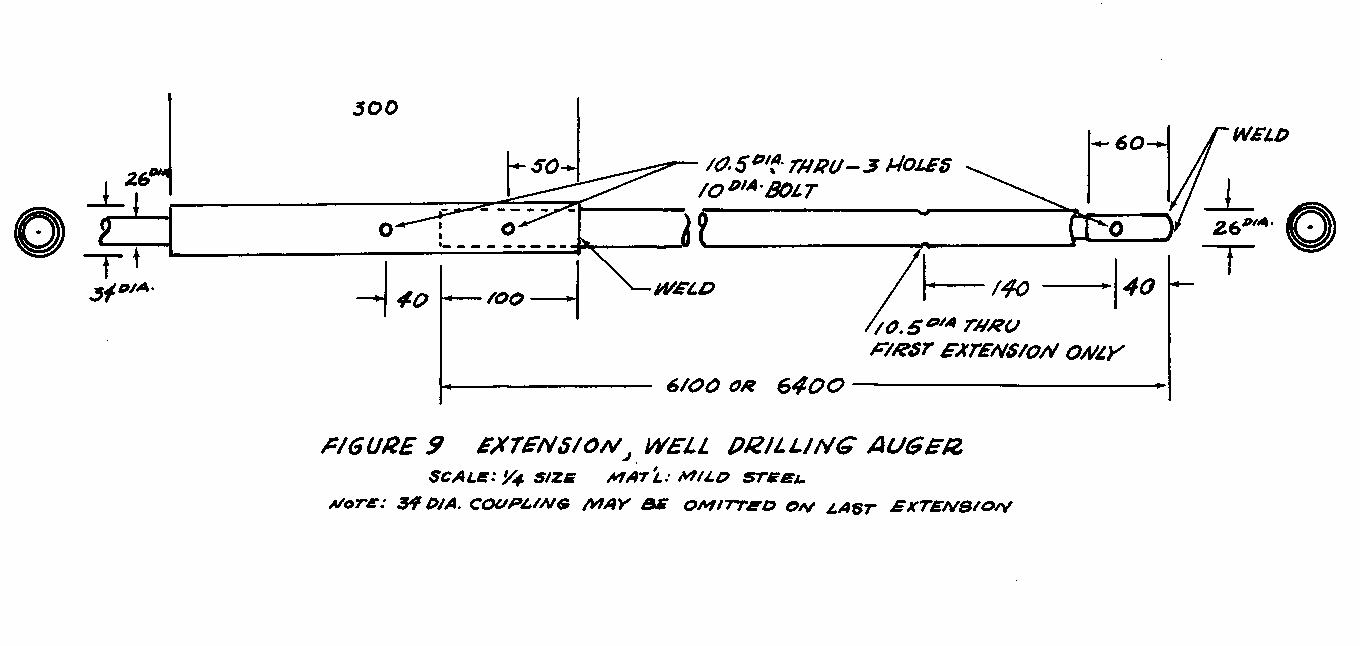
(see Figure 10) make it possible
uwr10x35.gif (600x600)
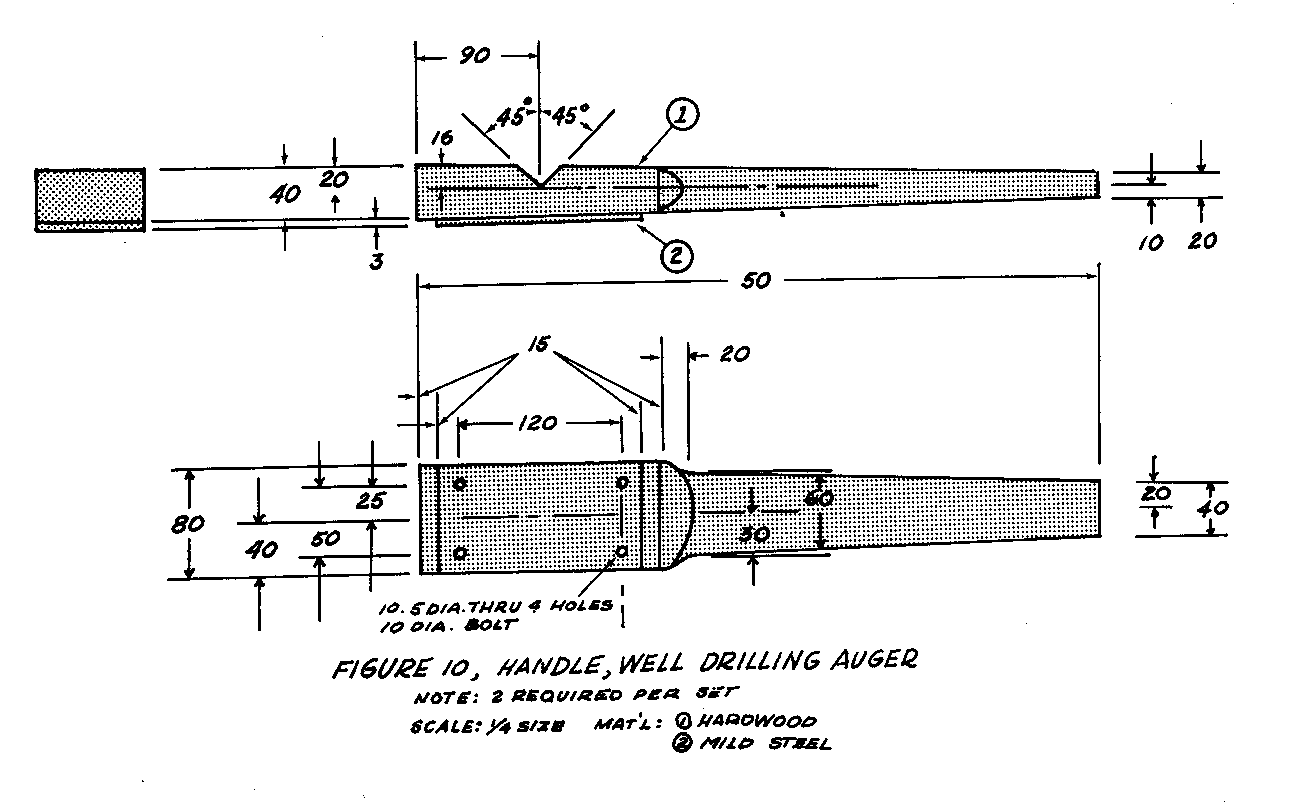
to bore deep holes.
Tools and Materials
Pipe: 10cm (4") in diameter, 120cm
(47 1/4")
long, for auger
Pipe: 34mm outside diameter (1" inside
diameter); 3 or 4
pieces 30cm
(12") long,
for auger and extension
socket
Pipe: 26mm outside diameter (3/4" inside
diameter); 3 or 4
pieces 6.1 or
6.4 meters (20' or
21') long, for
drill extensions
Pipe: 18mm outside diameter (1/2"
inside diameter); 3
or 4 pieces
6cm (2 3/8")
long
Hardwood: 4cm x 8cm x 50cm (1 1/2" x
3 1/8" x 19
3/4"), for handle
Mild steel: 3mm x 8cm x 15cm
(1/8" x 3
1/8" x 6")
4 bolts: 1cm (3/8") in diameter and
10cm (4") long
4 Nuts
Hand tools and welding equipment
In making the
auger, a flared-tooth
cutting edge is cut in one end of the
10cm pipe. The other
end is cut, bent
and welded to a section of 34mm outside-diameter
(1" inside-diameter) pipe,
which forms a socket for the drill
line extensions. A
slot which runs
nearly the length of the auger is used
for removing soil from the auger.
Bends are made stronger and more easily
and accurately when the steel is hot.
At first, an auger with two cutting
lips similar to a post-hole auger was
used; but it became plugged up and did
not cut cleanly. In
some soils, this
type of auger may be more effective.
Auger Cleaner
Soil can be removed
rapidly from the
auger with this auger cleaner (see Figure 11).
uwr11x36.gif (353x353)
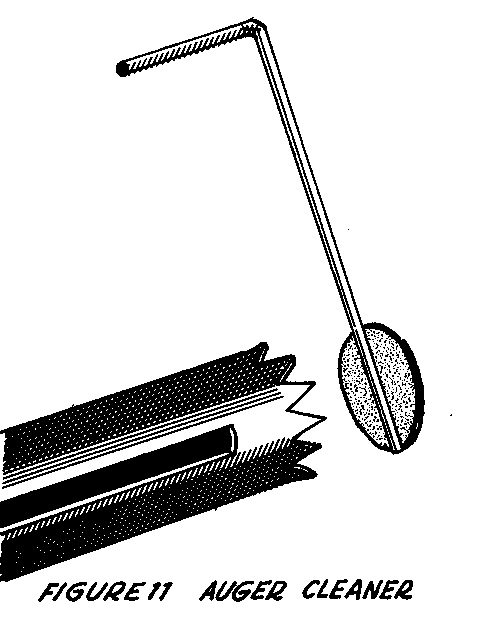
Figure 12 gives construction
uwr12x36.gif (486x486)
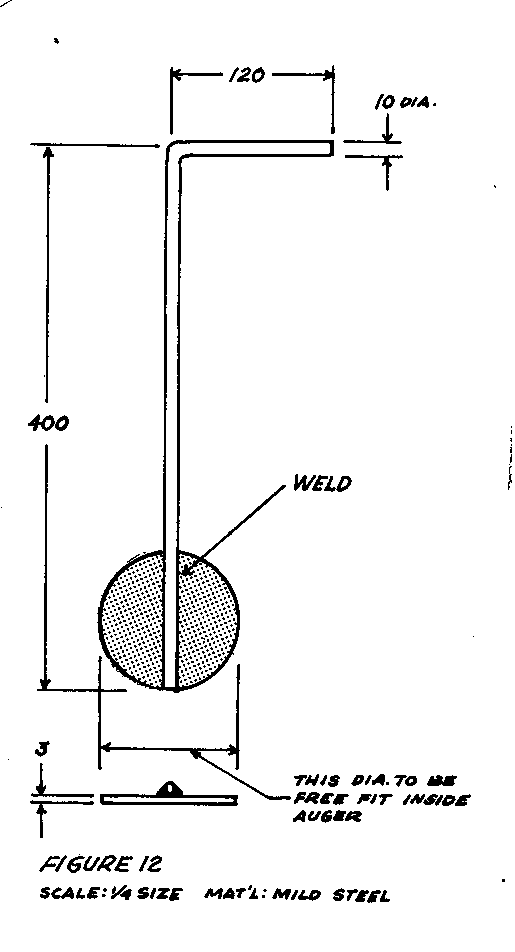
details.
Tools and Materials
Mild steel: 10cm (4") square and 3mm
(1/8") thick
Steel rod: 1cm (3/8") in diameter and
52cm (20 1/2")
long
Welding equipment
Hacksaw
File
Demountable Reamer
If the diameter of
a drilled hole
has to be made bigger, the demountable
reamer described here can be attached
to the auger.
Tools and Materials
Mild steel: 20cm x 5cm x 6mm (8" x 2"
x 1/4"), to
ream a well diameter of
19cm (7 1/2")
2 Bolts: 8mm (5/16") in diameter and
10cm (4") long
Hacksaw
Drill
File
Hammer
Vise
The reamer is
mounted to the top of
the auger with two hook bolts (see Figure 13).
uwr13x37.gif (486x486)
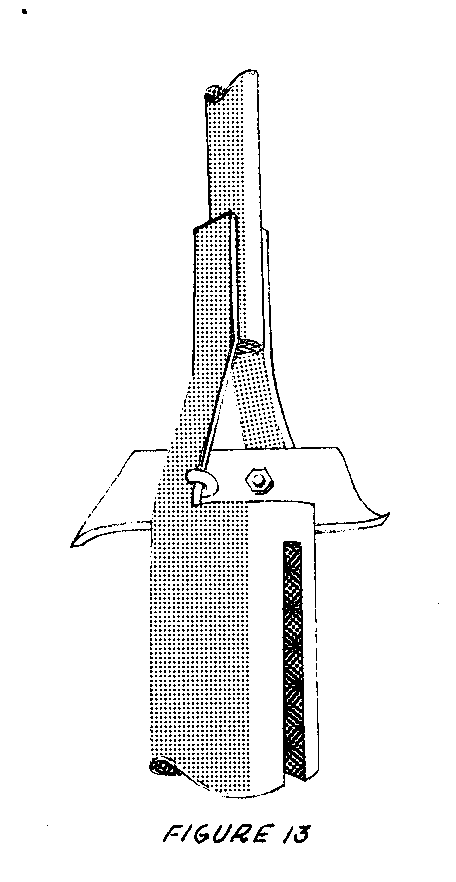
It is made from a piece of
steel 1cm (1/2") larger than the desired
well diameter (see Figure 14).
uwr14x38.gif (600x600)
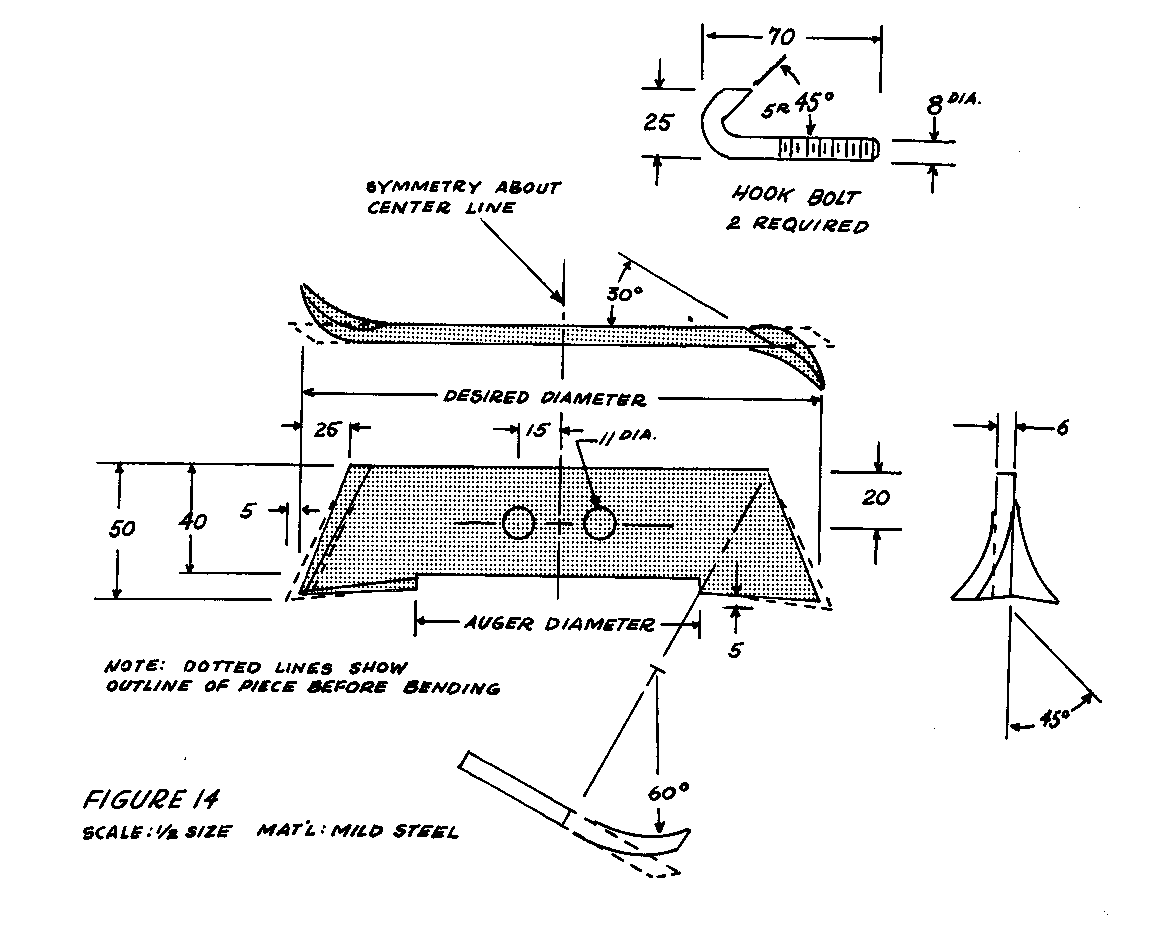
After the reamer is
attached to the
top of the auger, the bottom of the
auger is plugged with some mud or a
piece of wood to hold the cuttings inside
the auger.
In reaming, the
auger is rotated with
only slight downward pressure. It
should be emptied before it is too
full so that not too many cuttings will
fall to the bottom of the well when the
auger is pulled up.
Because the depth
of a well is more
important than the diameter in determining
the flow and because doubling
the diameter means removing four times
the amount of earth, larger diameters
should be considered only under special
circumstances. (See "Well Casing and
Platforms," page 12.)
Tripod and Pulley
The tripod (see
Figures 15 and 16),
uwr0040.gif (393x393)
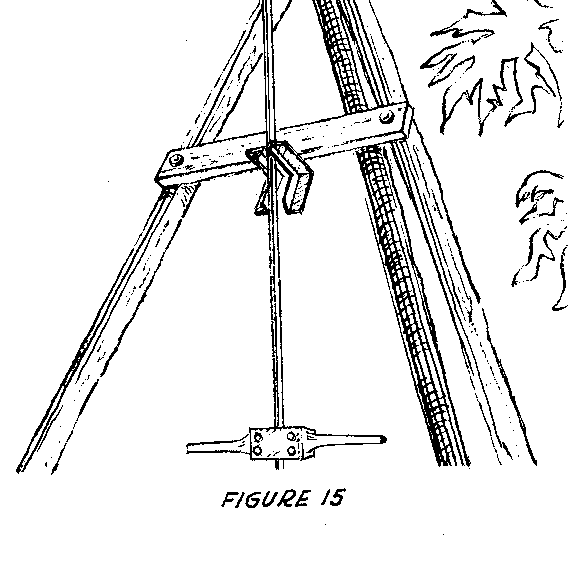
which is made of poles and assembled
with 16m (5/8") bolts, serves three
purposes: (1) to steady the extension
of the auger when it extends far above
ground; (2) to provide a mounting for
the pulley (see Figures 17 and 19)
uwr170.gif (600x600)
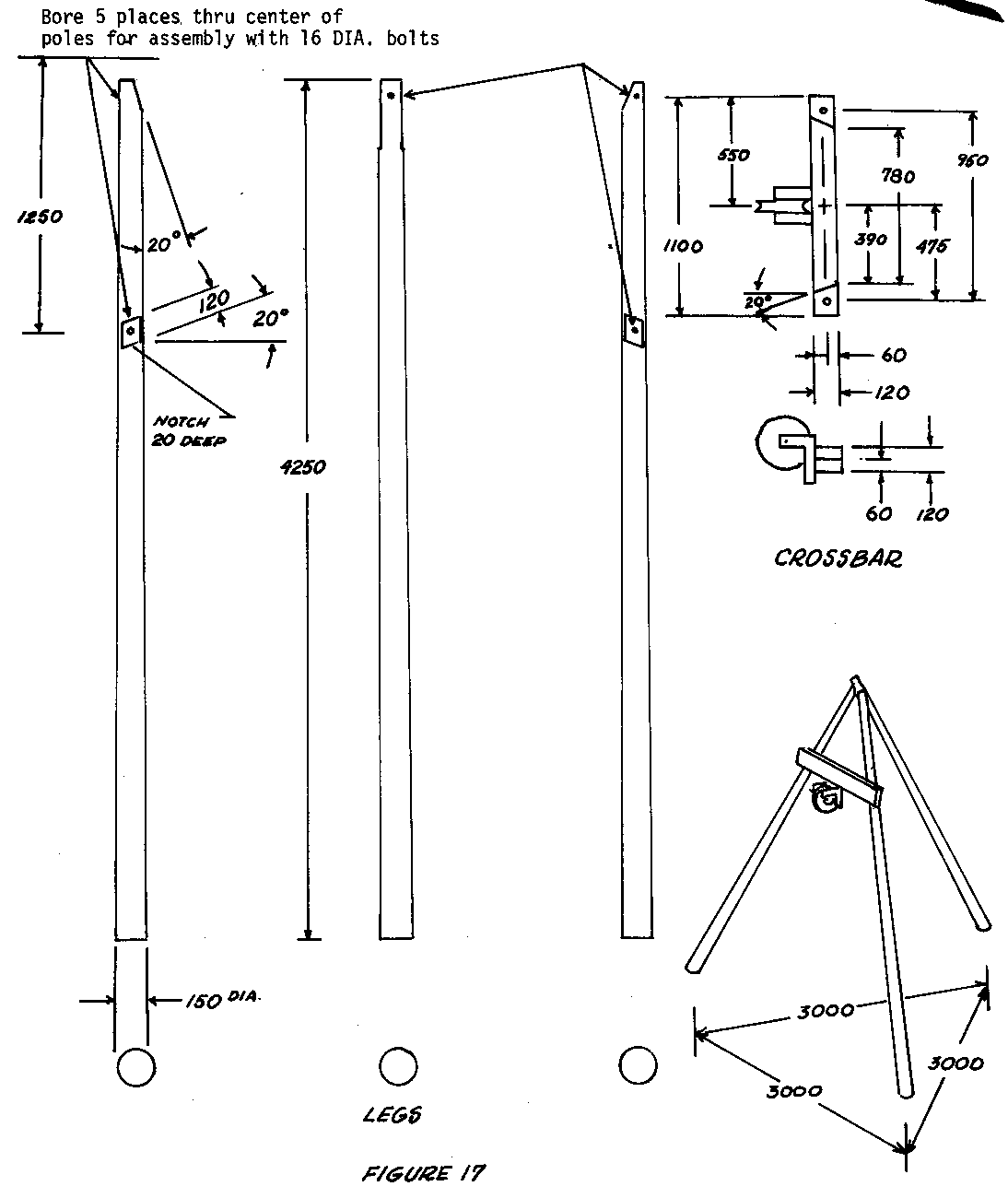
used with the drill bit and bailing
bucket; and (3) to provide a place
for leaning long pieces of casing,
pipe for pumps or auger extensions
while they are being put into or taken
out of the well.
When a pin or bolt is put through the
holes in the two ends of the "L"-shaped
pulley bracket (see Figures 15 and 18)
uwr150.gif (393x393)
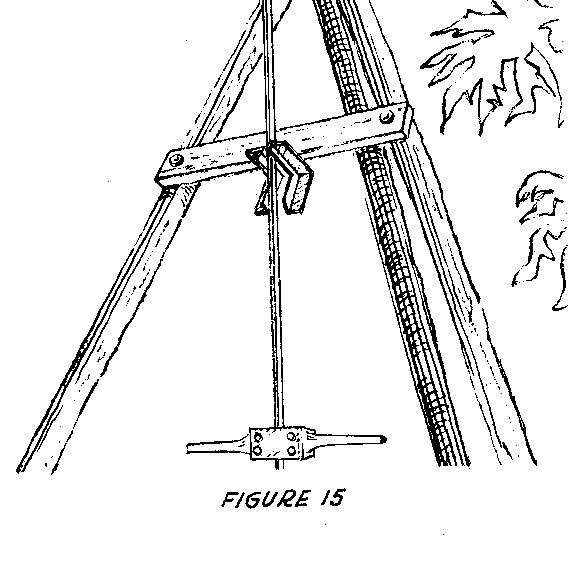
which extend horizontally beyond
the front of the tripod crossbar,
a loose guide for the upper part of
the auger extension is formed.
To keep the extensions from falling
when they are leaned against the tripod,
two 30cm (12") long wooden pegs
are driven into drilled holes near the
top of the tripod's two front legs
(see Figure 19).
uwr17.gif (600x600)
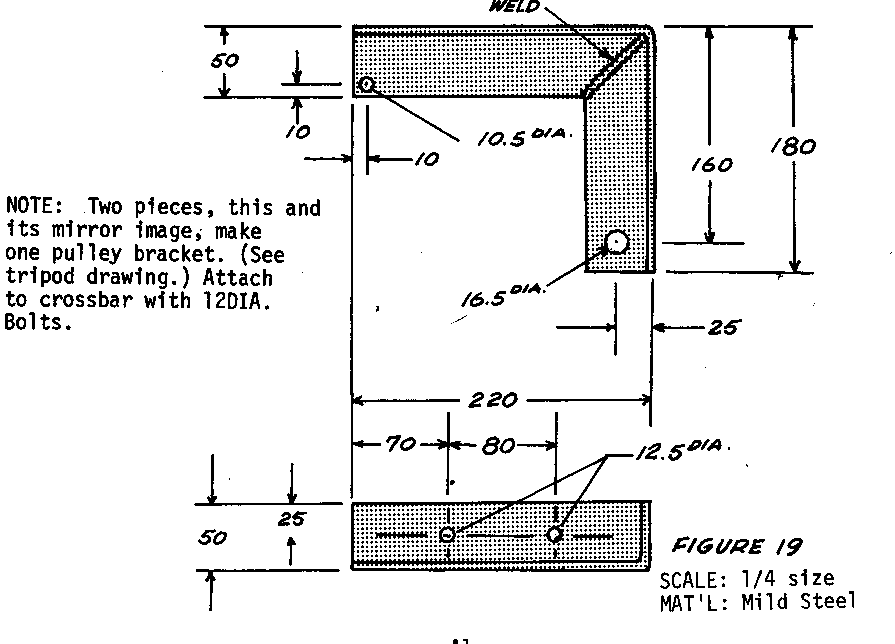
Tools and Materials
3 Poles: 15cm (3") in diameter and
4.25 meters (14')
long
Wood for cross bar: 1.1 meter
(43 1/2") x
12cm (4 3/4") square
For pulley wheel:
Wood: 25cm
(10") in diameter and
5cm (2")
thick
Pipe: 1.25cm
(1/2") inside diameter,
5cm (2")
long
Axle bolt: to fit
close inside
1.25cm
(1/2") pipe
Angle iron: 80cm (31 1/2") long, 50cm
(19 3/4")
webs, 5mm (3/16") thick
4 Bolts: 12mm (1/2") in diameter,
14cm (5 1/2")
long; nuts and washers
Bolt: 16mm (5/8") in diameter and
40cm (15 3/4")
long; nuts and
washers
2 Bolts: 16mm (5/8") in diameter and
25cm (9 7/8")
long; nuts and washers
Bailing Bucket
The bailing bucket
can be used to
remove soil from the well hole when
cuttings are too loose to be removed
with the auger.
Tools and Materials
Pipe: about 8.5cm (3 3/8") in diameter
1 to 2 cm
(1/2" to 3/4")
smaller in diameter
than the auger,
180cm (71")
long
Steel rod: 10mm (3/8") in diameter
and 25cm (10")
long; for bail
(handle)
Steel plate: 10cm (4") square, 4mm
(5/32") thick
Steel bar: 10cm x 1cm x 5mm (4" x
3/8" x
3/16")
Machine screw: 3mm (1/8") in diameter;
16mm (5/8")
long; nut and
washer
Truck innertube: 4mm (5/32") thick,
10mm (3/8")
square
Welding equipment
Drill, hacksaw, hammer, vise, file
Rope
Both standard
weight pipe and thin-walled
tubing were tried for the bailing
bucket. The former, being heavier,
was harder to use, but did a better job
and stood up better under use. Both
the steel bottom of the bucket and the
rubber valve should be heavy because
they receive hard usage. The metal
bottom is reinforced with a crosspiece
welded in place (see Figures 20 and 21).
uwr20420.gif (353x353)

Using the Bailing Bucket
When water is
reached and the cuttings
are no longer firm enough to be brought
up in the auger, the bailing bucket
must be used to clean out the well as
work progresses.
For using the
bailing bucket the
pulley is mounted in the pulley bracket
with a 16mm (5/8") bolt as axle. A
rope attached to the bailing bucket is
then run over the pulley and the
bucket is lowered into the well. The
pulley bracket is so designed that the
rope coming off the pulley lines up
vertically with the well, so that there
is no need to shift the tripod.
The bucket is
lowered into the well,
preferably by two men, and allowed to
drop the last meter or meter and one-half
(3 to 5 feet) so that it will
hit the bottom with some speed. The
impact will force some of the loose
soil at the bottom of the well up
into the bucket. The bucket is then
repeatedly raised and dropped 1 to 2
meters (3 to 6 feet) to pick up more
soil. Experience will show how long
this should be continued to pick up
as much soil as possible before raising
and emptying the bucket. Two or
more men can raise the bucket, which
should be dumped far enough from the
well to avoid messing up the working
area.
If the cuttings are
too thin to be
brought up with the auger but too thick
to enter the bucket, pour a little
water down the well to dilute them.
Bit for Drilling Rock
The bit described
here has been used
to drill through layers of sedimentary
stone up to 11 meters (36') thick.
Tools and Materials
Mild steel bar: about 7cm (2 3/4") in
diameter and about
1.5 meters (5')
long, weighing
about 80kg (175
pounds)
Stellite (a very hard type of tool
steel) insert for
cutting edge
Anvil and hammers, for shaping
Steel rod: 2.5cm x 2cm x 50cm (1" x
3/4" x 19
3/4") for bail
Welding equipment
The drill bit for
cutting through
stone and hard formations is made from
the 80kg (175-pound) steel bar (see
Figures 22 and 23). The 90-degree
uwr22440.gif (317x317)
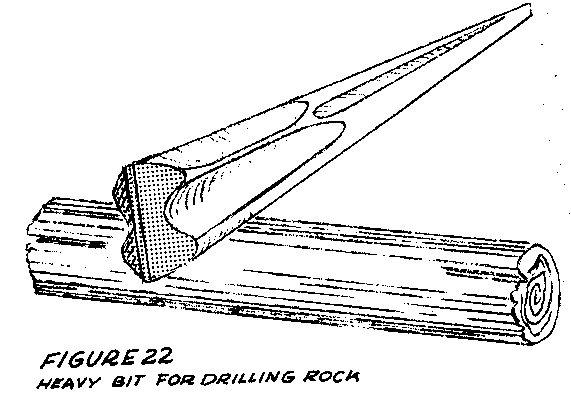
stellite and a bail (or handle) for
attaching a rope is welded to the
top. The bail should be large enough
to make "fishing" easy if the rope
breaks. A 2.5cm (1") rope was used
at first, but this was subject to
much wear when working in mud and
water. A 1cm (3/8") steel cable was
substituted for the rope, but it was
not used enough to be able to show
whether the cable or the rope is
better. One advantage of rope is that
it gives a snap at the end of the fall
which rotates the bit and keeps it
from sticking. A swivel can be
mounted between the bit and the rope
or cable to let the bit rotate.
If a bar this size
is difficult to
find or too expensive, it might be possible
to make one by welding a short
steel cutting end onto a piece of pipe
which is made heavy enough by being
filled with concrete. This has not
been tried.
In using the
drilling bit, the pulley
is put in place as with the bailing
bucket, and the bit is attached to its
rope or cable and lowered into the well.
Since the bit is heavy, wrap the rope
once or twice around the back leg of
the tripod so that the bit cannot "get
away" from the workers with the chance
of someone being hurt or the equipment
getting damaged. The easiest way
found to raise and drop the bit was to
run the rope through the pulley and
then straight back to a tree or post
where it was attached at shoulder
height or slightly lower. Workers
line up along the rope and raise the
bit by pressing down on the rope; they
drop it by allowing the rope to return
quickly to its original position (see
Figure 24). This requires five to
uwr24x46.gif (353x353)
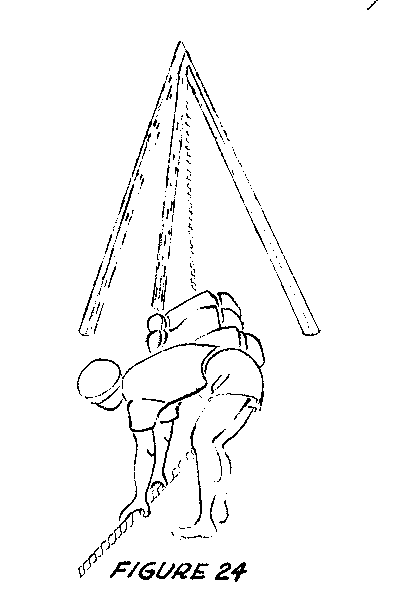
seven men; occasionally more helped.
Frequent rests are necessary; usually
after every 50 to 100 strokes. Because
the work is harder near the ends of the
rope than in the middle, the positions
of the workers should be rotated to distribute
the work evenly.
A small amount of
water should be
kept in the hole for lubrication and
to mix with the pulverized stone to
form a paste which can be removed with
a bailing bucket. Too much water will
slow down the drilling.
The speed of
drilling is, of course,
dependent on the type of stone encountered.
In the soft water-bearing stone
of the Ban Me Thuot area it was possible
to drill several meters (about
10 feet) per day. However, when hard
stone such as basalt is encountered,
progress is measured in centimeters
(inches). The decision must then be
made whether to continue trying to penetrate
the rock or to start over in a
new location. Experience in the past
has indicated that one should not be
too hasty in abandoning a location,
since on several occasions what were
apparently thin layers of hard rock
were penetrated and drilling then continued
at a good rate.
On occasion the bit
has become stuck
in the well and it has been necessary
to use a lever arrangement consisting
of a long pole attached to the rope to
free it (see Figure 25). On other occasions
uwr25x46.gif (353x353)
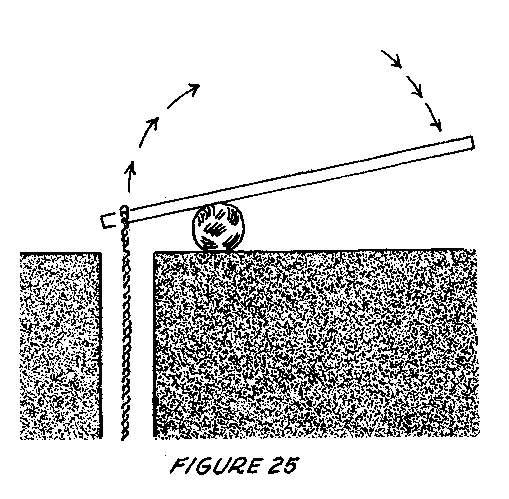
a crude windlass was used consisting
of a horizontal pole which was
used to wrap the rope around a vertical
pole pivoted on the ground and
held in place by several men (see Figure 26).
uwr26x47.gif (353x353)

When the above two failed,
it was necessary to borrow a chain
hoist. Twice when the rope was allowed
to become too worn, it was broken when
trying to retrieve a stuck bit. It was
then necessary to fit a hook to one of
the auger extensions, attach enough
extensions together to reach the desired
depth, and after hooking the bit,
to pull with the chain hoist. A rope
or cable may also be used for this
purpose, but it is considerably more
difficult to hook onto the bit.
Drilling Mechanically
A method for
raising and dropping the
bit mechanically, not used on the project
but used successfully elsewhere,
is:
1. Jack up the rear wheel of a car
and replace the
wheel with a small
drum.
2. Take the rope which is attached
to the bit and
come from the tripod
on the pulley and
wrap it
loosely around the
drum.
3. Pull the unattached end of the
rope taut and set
the drum in
motion. The rope
will move with
the drum and raise
the bit.
4. Let the end of the rope go slack
quickly to drop
the bit.
It will probably be
necessary to polish
and/or grease the drum.
DRY BUCKET WELL DRILLING
The dry bucket
method is a simple and
quick method of drilling wells in dry
soil which is free of rocks. It can
be used for 5cm to 7.5cm (2" to 3")
diameter wells in which steel pipe is
to be installed. For wells which are
wider in diameter, it is a quick method
of removing dry soil before completing
the bore with a wet bucket, tubewell
sand bailer or tubewell sand auger.
A 19.5-meter (64')
hole was dug in
less than 3 hours with this method in
north Florida. The method works best
in sandy soil, according to the author
of this entry, who has drilled 30 wells
with it.
Tools and Materials
Dry bucket
Rope: 16mm (5/8") or 19mm (3/4") in
diameter and 6 to 9
meters (20' to
30') longer than
the deepest well to
be drilled
3 Poles: 10cm (4") in diameter at large
end and 3.6 to 4.5
meters (12' to
15') long
Chain, short piece
Pulley
Bolt: 12.5mm (1/2") in diameter and
30 to 35cm
(12" to 14") long (long
enough to reach
through the upper
ends of the three
poles )
The dry bucket is
held about 10cm
(several inches) above the ground,
centered above the hole location and
then dropped (see Figure 1). This
uwr1x48.gif (437x353)
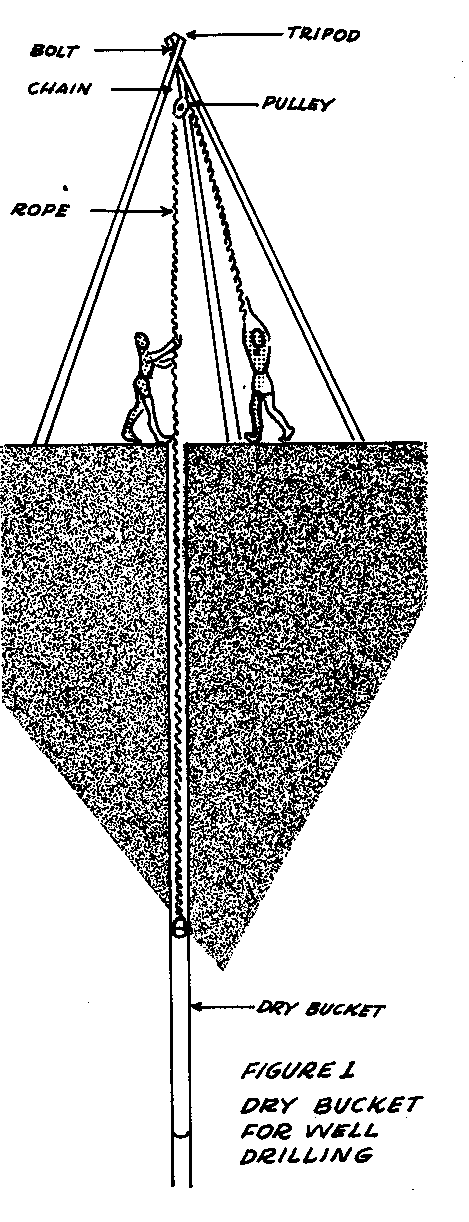
drives a small amount of soil up
into the bucket. After this is repeated
two or three times, the bucket is removed,
held to one side and tapped
with a hammer or a piece of iron to
dislodge the soil. The process is
repeated until damp soil is reached
and the bucket will no longer remove
soil.
Dry Bucket for Well Drilling
A dry bucket is
simply a length of
pipe with a bail or handle welded to
one end and a slit cut in the other.
Bend the iron rod
into a U-shape
small enough to slide inside the pipe.
Weld it in place as in Figure 2.
uwr2x49.gif (486x486)
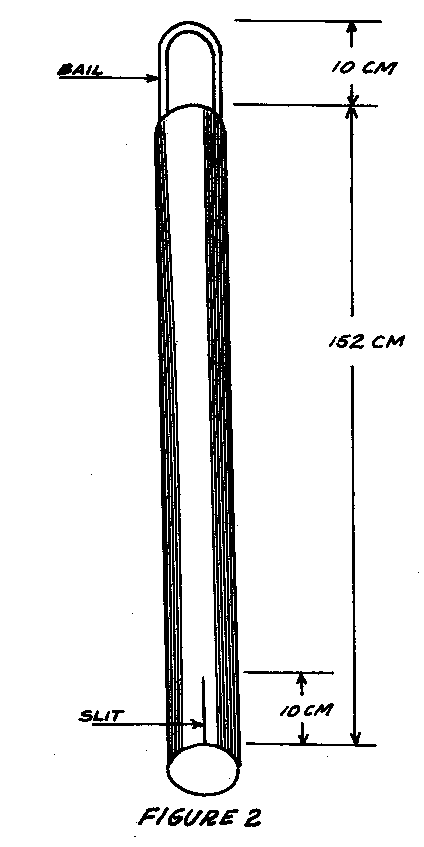
File a gentle taper
on the inside
of the opposite end to make a cutting
edge (see Figure 3).
uwr3x49.gif (393x393)
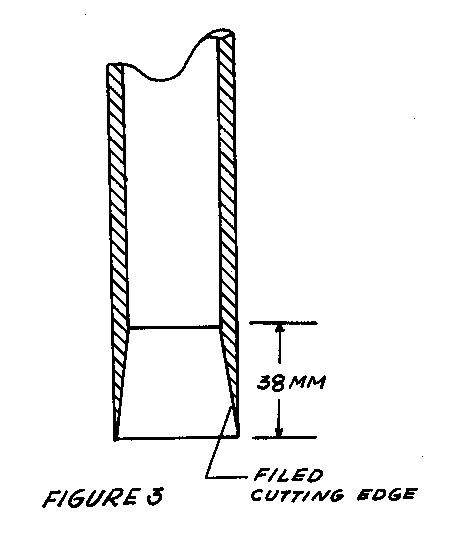
Cut a slit in one
side of the sharpened
end of the pipe (see Figure 2).
Tools and Materials
Hacksaw
File
Iron rod: 10mm (3/8") or 12.5mm
(1/2") in
diameter and 30cm (1')
long
Iron pipe: slightly larger in diameter
than the largest
part of casing
to be put in the
well (usually
the coupling) and
152cm (5') long
Source:
John Brelsford, VITA Volunteer, New
Holland, Pennsylvania
DRIVING WELLS
A pointed strainer
called a well point,
properly used, can quickly and cheaply
drive a sanitary well, usually less
than 7.6 meters (25') deep.
In soils
where the driven well is suitable, it
is often the cheapest and fastest way
to drill a sanitary well.
In heavy
soils, particularly clay, drilling with
an earth auger is faster than driving
with a well point.
Tools and Materials
Well point and driving cap: usually
obtainable from the
United States
for about $10,
through mail order
houses (see Figure
1)
uwr1x50.gif (486x486)
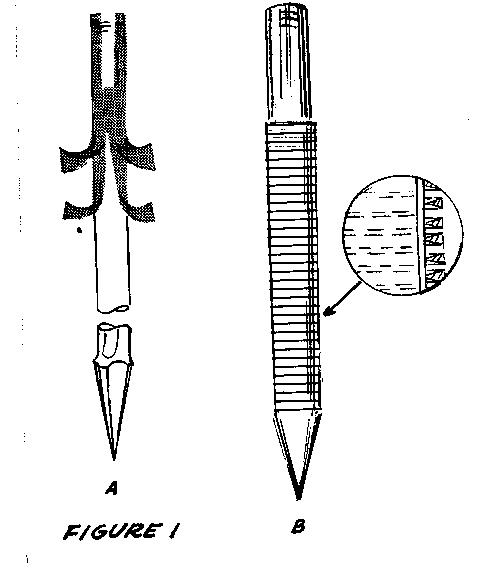
Pipe: 3cm (1") in diameter
Heavy hammer and wrenches
Pipe compound
Special pipe couplings and driving
arrangements are
desirable but not
necessary
Driven wells are
highly successful
in coarse sand where there are not too
many rocks and the water table is within
7 meters (23') of the surface.
They are usually used as shallow wells
where the pump cylinder is at ground
level. If conditions
for driving are
very good, 10cm (4") diameter points
and casings that can accept the cylinder
of a deep well, can be driven to depths
of 10 to 15 meters (33' to 49').
The most common types of well points
are:
1. a pipe with holes
covered by a
screen and a
brass jacket with
holes.
For general use, a #10 slot
or 60 mesh is
recommended. Fine
sand requires a
finer screen, perhaps
a #6 slot or 90
mesh;
2. a slotted steel
pipe with no covering
screen, which
allows more water
to enter but is
less rugged.
Before starting to
drive the point,
make a hole at the site with handtools.
The hole should be plumb and should be
slightly larger in diameter than the
well point.
The joints must be
carefully made to
prevent thread breakage and assure airtight
operation. Clean and
oil the
threads carefully and use joint compound
and special drive couplings when
available. To insure
that joints stay
tight, give the pipe a fraction of a
turn after each blow, until the top
joint is permanently set.
Do not twist
the whole string and do not twist and
pound at the same time.
The latter
may help get past stones, but soon
will break the threads and make leaky
joints.
Be sure the drive
cap is tight and
butted against the end of the pipe (see
Figure 2). Check
with a plumb bob to
uwr2x51.gif (600x600)
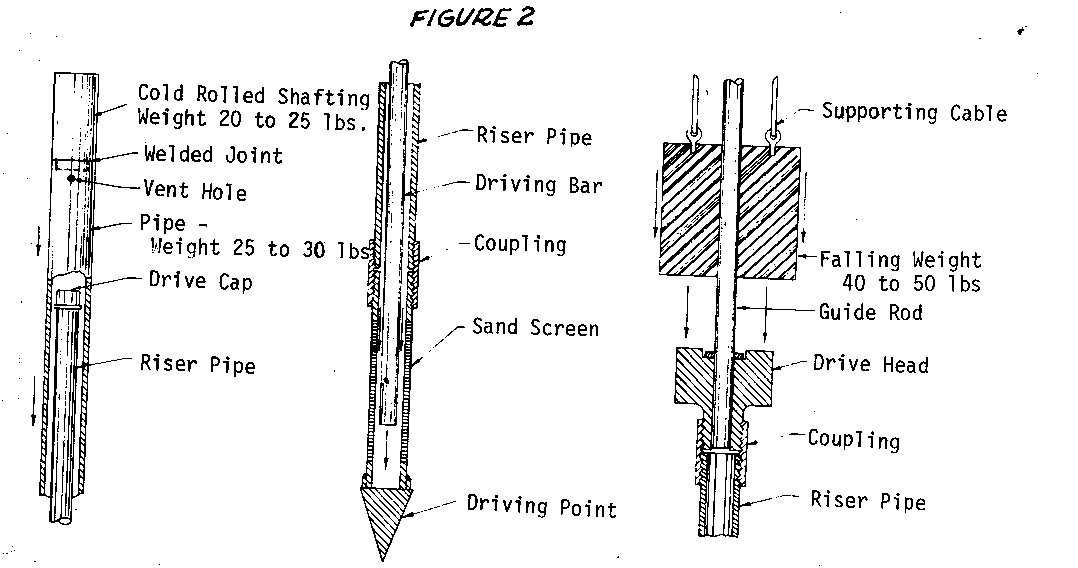
see that the pipe is vertical.
Test
it occasionally and keep it straight
by pushing on the pipe while driving.
Hit the drive cap squarely each time
or you may damage the equipment.
Several techniques
can help avoid
damage to the pipe.
The best way is
to drive with a steel bar that is
dropped inside the pipe and strikes
against the inside of the steel well
point. It is
retrieved with a cable
of rope. Once water
enters the well,
this method does not work.
Another way is to
use a driver pipe
which makes sure that the drive cap
is hit squarely. A guide rod can be
mounted on top of the pipe and a
weight dropped over it, or the pipe
itself can be used to guide a falling
weight which strikes a special drive-clamp
(see Figure 2).
Figure 3 is a table
which will help
uwr3x51.gif (600x600)
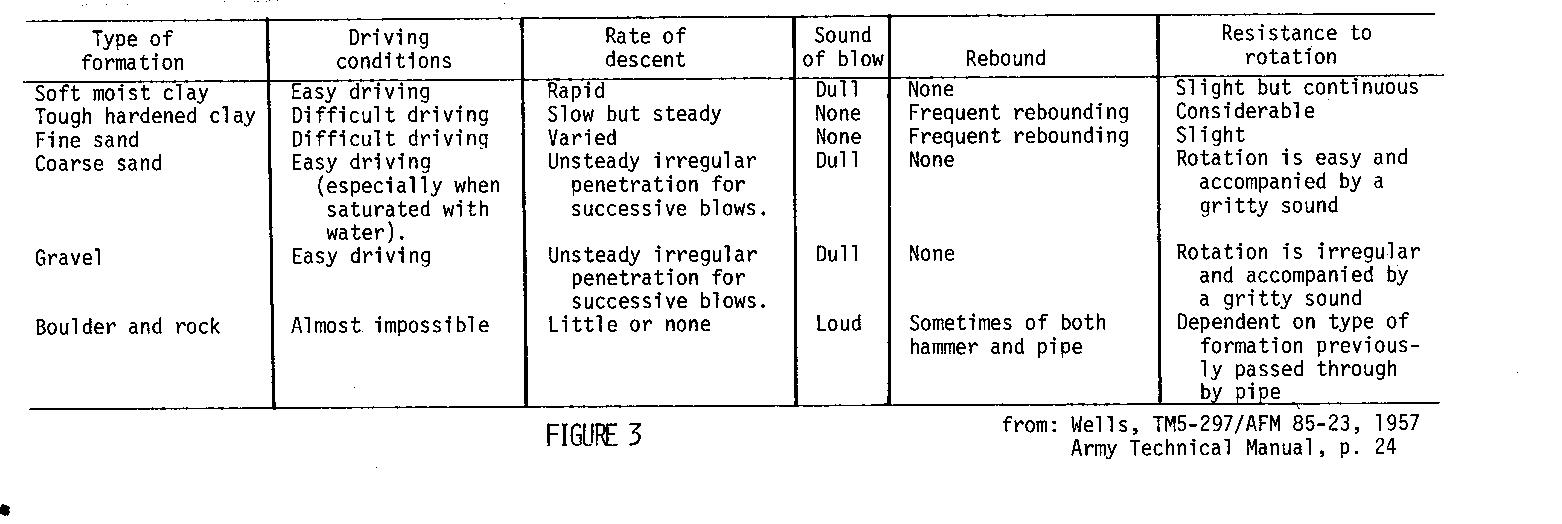
identify the formations being penetrated.
Experience is needed. . .but
this may help you to understand what
is happening.
When you think that
the water-bearing
layer has been reached, stop
driving and attach a handpump to try
the well. Usually,
easier driving
shows that the water-bearing level
has been reached, especially in
coarse sand. If the
amount of water
pumped is not enough, try driving a
meter or so (a few feet) more.
If
the flow decreases, pull the point back
until the point of greatest flow is
found. The point can
be raised by
using a lever arrangement like a fence-post
jack, or, if a drive-monkey is
used, by pounding the pipe back up.
Sometimes sand and
silt plug up the
point and the well must be `developed'
to clear this out and improve the flow.
First try hard, continuous pumping it
a rate faster than normal.
Mud and
fine sand will come up with the water,
but this should clear in about an hour.
It may help to allow the water in the
pipe to drop back down, reversing the
flow periodically.
With most pitcher
pumps this is easily accomplished by
lifting the handle very high; this opens
the check valve, allowing air to enter
and the water rushes back down the
well.
If this does not
clear up the flow,
there may be silt inside the point.
This can be removed by putting a 19mm
(3/4") pipe into the well and pumping
on it. Either use
the pitcher
pump or quickly and repeatedly
raise and lower the 19mm (3/4") pipe.
By holding your thumb over the top
of the pipe on the upstroke, a jet
of muddy water will result on each
downstroke. After
getting most of
the material out, return to direct
pumping. Clean the
sand from the valve
and cylinder of the pump after developing
the well. If you have
chosen too
fine a screen, it may not be possible
to develop the well successfully.
A
properly chosen screen allows the fine
material to be pumped out, leaving a
bed of coarse gravel and sand that provides
a highly porous and permeable
water-gathering area.
The final step is
to fill in the
starting borehole with puddled clay or,
if clay is not available, with well-tamped
earth. Make a solid,
waterproof
pump platform (concrete is best)
and provide a place for spilled water
to drain away.
Source:
Water Supply for Rural Areas and Small
Communities, by E. G. Wagner and J. N.
Lanoix, World Health Organization, 1959.
DUG WELLS
A village well must
often act as a
reservoir, because at certain hours of
the day the demand for water is heavy,
whereas during the night and the heat
of the day there is no call on the
supply. What is
suggested here is to
make the well large enough to allow the
water slowly percolating in to accumulate
when the well is not in use in
order to have an adequate supply when
the demand on it is heavy.
For this
reason wells are usually made 183 to
213cm (6' to 7') in diameter.
Wells cannot store
rainy season
water for the dry season, and there is
seldom any reason for making a well
larger in diameter than 213cm (7').
The depth of a well
is much more important
than the diameter in determining
the amount of water that can be
drawn when the water level is low.
A
deep, narrow well will often provide
more water than a wide shallow one.
Remember that
tubewells are much
easier to construct than a dug well,
and should be used if your region
allows their construction and an adequate
amount of water can be drawn
from a tubewell during the busy
hours (see section on Tubewells).
Deep dug wells have
several disadvantages.
uwr1x54.gif (600x600)
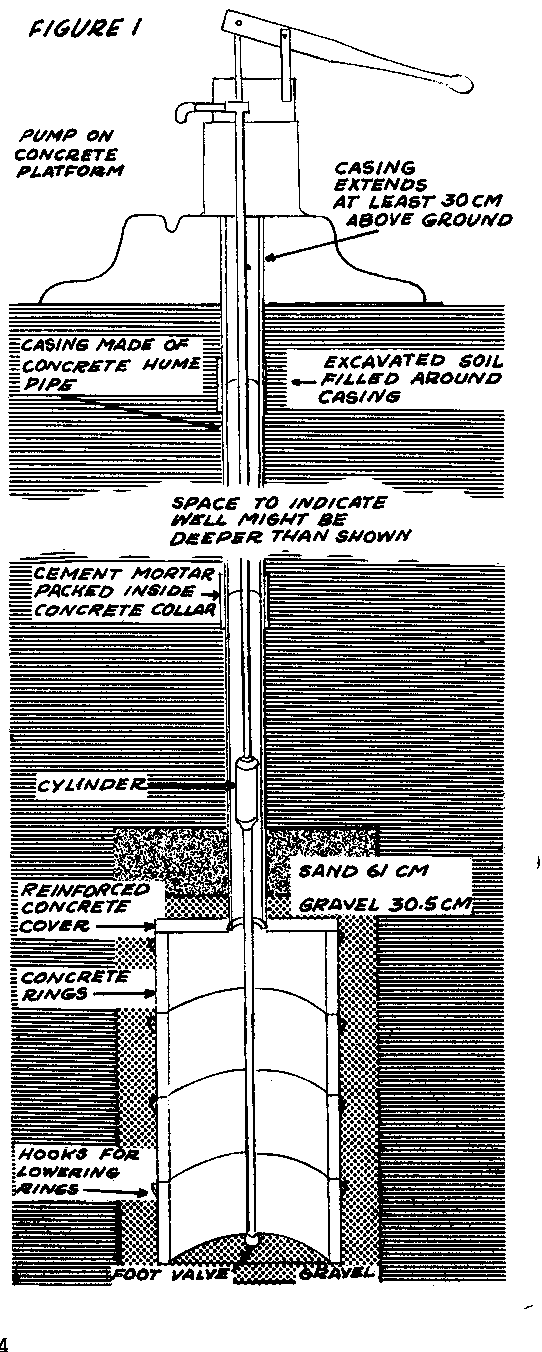
The masonry lining
needed is very expensive.
An open
well is very easily contaminated by
organic matter which falls in from
the surface and by the buckets used
to lift the water.
There is an added
problem of disposing of the great
quantity of soil removed from a deep
well.
This well has an
underground concrete
tank which is connected to the
surface with a casing pipe, rather
than a large-diameter lining as described
in the preceding entry.
The
advantages are that it is relatively
easy to build, easy to seal, takes up
only a small surface area and is low
in cost.
More than 45 of
these wells were installed
in India by an American Friends
Service Committee Team there; all performed
perfectly for several years,
except for one which was not dug deep
enough. The total
cost of an installation,
excluding labor, was Rs. 230 or
about U.S. $50.
Tools and Materials
4 reinforced concrete rings with iron
hooks for lowering,
91.5cm (3') in
diameter
1 reinforced concrete cover with a
seating hole for
casing pipe
Washed gravel to surround tank: 1.98
cubic meters (70
cubic feet)
Sand for top of well: 0.68 cubic
meters (24 cubic
feet)
Concrete pipe: 15cm (6") in diameter,
to run from the top
of the tank cover
to at least 30.5cm
(1') above ground
Concrete collars: for joints in the
concrete pipe
Cement: 4.5kg (10 pounds) for mortar
for pipe joints
Deep-well pump and pipe
Concrete base for pump
Tripod, pulleys, rope for lowering rings
Special tool for positioning casing
when refilling, see
"Positioning
Casing Pipe,"
below
Digging tools, ladders, rope
A villager in
Barpali, India, working
with an American Friends Service Committee
unit there suggested this radical
new idea: make a masonry tank at
the bottom of the well, roof it over,
and draw the water from it with a pump.
The resulting sealed well has many
advantages:
1. It provides pure
water, safe for
drinking.
2. It presents no
hazard of children
falling in.
3. Drawing water is
easy, even for
small children.
4. The well occupies
little space, a
small courtyard
can accommodate it.
5. The cost of
installation is greatly
reduced.
6. The labor
involved is much reduced.
7. There is no
problem of getting rid
of excavated
soil, since most of
it is replaced.
8. The casing
enables the pump and
pipe to be easily
removed for servicing.
9. The gravel and
sand surrounding the
tank provide an
efficient filter
to prevent
silting, allows a
large surface
area for percolating
water to fill the
tank, and increases
the effective
stored volume
in the tank.
On the other hand,
there are three
minor disadvantages: only one person
can pump at one time, the pump might
go out of order, and a certain amount
of technical skill is required to
make the parts used in the well and
to install them properly.
A well is dug 122cm
(4') in diameter
and about 9 meters (30') deep.
The
digging should be done in the dry
season, after the water table has
dropped to its lowest level.
There
should be a full 3 meter (10') reaccumulation
of water within 24 hours
after the well has been bailed or
pumped dry. Greater
depth is, of
course, desirable.
Over the bottom of
the well, spread
15cm (6") of clean, washed gravel or
small rock. Lower
the four concrete
rings and cover into the well and position
them there to form the tank.
A
tripod of strong poles with block and
tackle is needed to lower the rings,
because they weigh about 180kg (400
pounds) each. The
tank formed by the
rings and cover is 183cm (6') high and
91.5cm (3') in diameter.
The cover
has a round opening which forms a
seat for the casing pipe and allows
the suction pipe to penetrate to about
15cm (6") from the gravel bottom.
Positioning the Casing Pipe
The first section
of concrete pipe
is positioned in the seat and grouted
(mortared) in place.
It is braced vertically
by a wooden plug with four
hinged arms to brace against the sides
of the wall. Gravel
is packed around
the concrete rings and over the top of
the cover till the gravel layer above
the tank is at least 15cm (6") deep.
This is then covered with 61cm (2') of
sand. Soil removed
from the well is
then shoveled back until filled within
15cm (6") of the top of the first
section of casing.
The next section
of casing is then grouted in place,
using a concrete collar made for this
purpose. The well is
filled and more
sections of casing added until the
casing extends at least 30cm (1')
above the surrounding soil level.
The amount of soil
which will not
pack back into the well can be used
to make a shallow hill around the
casing to encourage spilled water to
drain away from the pump.
A concrete
cover is placed on the casing and a
pump installed.
If concrete or
other casing pipe
cannot be obtained, a chimney made
of burned bricks and sand-cement mortar
will suffice. The
pipe is somewhat
more expensive, but much easier
to install.
Source:
"A Safe Economical Well," American
Friends Service Committee, Philadelphia,
Pennsylvania, 1956 (mimeo).
Deep Dug Well
Untrained workers
can safely dig a
deep, sanitary well with simple, light
equipment, if they are well supervised.
The basic method is outlined
here.
Tools and Materials
Shovels, mattocks
Buckets
Rope--deep wells require wire rope
Forms--steel, welded and bolted together
Tower with winch and pulley
Cement
Reinforcing rod
Sand
Aggregate
Oil
The hand dug well
is the most widespread
of any kind of well.
Unfortunately,
most of these wells were dug
by uninformed people and now are infected
by parasitic and bacterial
disease. By using
modern methods and
materials, dug wells can safely be made
60 meters (196.8') deep and will give
a permanent source of pure water.
Experience has
shown that for one man,
the average width of a round well for
best digging speed is 1 meter (3 1/4').
However 1.3 meters (4 1/4') is best
for two men digging together and they
dig more than twice as fast as one man.
Thus, two men in the larger hole is
usually best.
Dug wells always
need a permanent
lining (except in solid rock, where the
best method is usually to drill a tubewell).
The lining prevents
collapse of the
hole, supports the pump platform, stops
entrance of contaminated surface water,
and supports the well intake which is
the part of the well through which
water enters. It is
usually best to
build the lining while digging, since
this avoids temporary supports and reduces
danger of cave-ins.
Dug wells are lined
in two ways:
(1) where the hole is dug and the lining
is built in its permanent place and
(2) where sections of lining are added
to the top and the whole lining moves
down as earth is removed from beneath
it. The second
method is called
caissoning. Often a
combination of
both is best, as shown in Figure 2.
uwr2x57.gif (600x600)
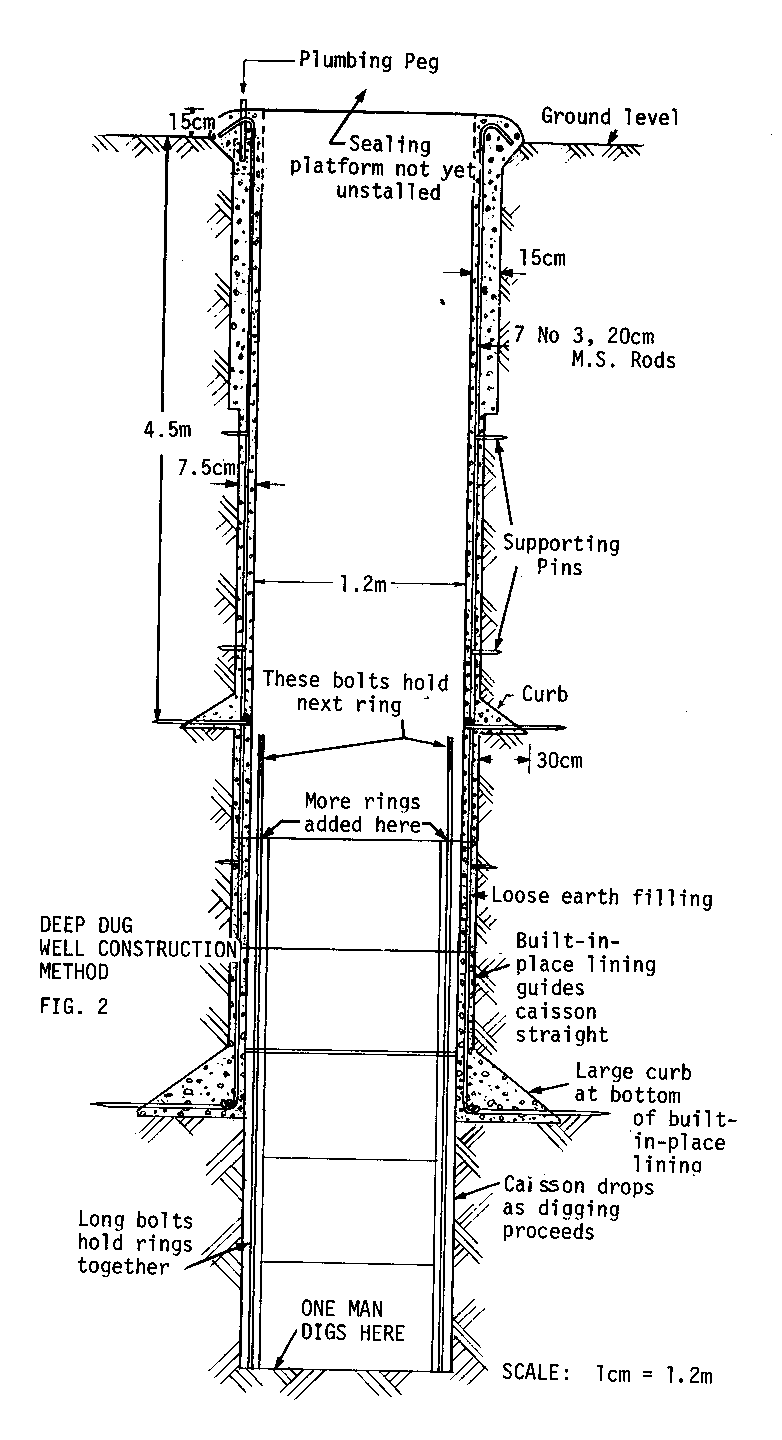
If possible, use
concrete for the
lining because it is strong, permanent,
made mostly of local materials, and can
be handled by unskilled workers with
good speed and results.
(See section
on Concrete Construction).
Masonry and
brickwork are widely
used in many countries and can be
very satisfactory if conditions are
right. In bad
ground, however, unequal
pressures can make them bulge or collapse.
Building with these materials
is slow and a thicker wall is required
than with concrete.
There is also
always the danger of movement during
construction in loose sands or swelling
shale before the cement has set firmly
between the bricks or stones.
This
danger is prevented with concrete by
leaving the form in place to support
the lining, until the concrete is hard.
Also, there may not be any skilled
masons in the area; suitable stone
or well-fired brick may not be readily
available.
Wood and steel are
not good for lining
wells. Wood requires
bracing,
tends to rot and hold insects; sometimes
it will make the water taste badly.
Worst of all, it will not make the
well watertight against contamination.
Steel is seldom used because it is
expensive, rusts quickly and usually
is subject to bulging and bending.
The general steps
in finishing the
first 4.6 meters (15') are:
* set up a tripod
winch over cleared,
level ground and
reference points
for plumbing and
measuring the
depth of the well.
* two men dig the
well while another
raises and unloads
the dirt until
the well is
exactly 4.6 meters
(15') deep.
* the hole is
accurately trimmed to
size using a
special jig mounted
on the reference
points.
* the forms are
carefully placed and
filled one by one
with tamped concrete.
After this is done,
dig to 9.1
meters (30'), trim and line this part
also with concrete.
A 12.5cm (5") gap
between the first and second of these
sections is filled with pre-cut concrete
which is grouted (mortared) in place.
Each lining is self-supporting as it
has a curb. The top
of the first
section of lining is thicker than the
second section and extends above the
ground to make a good foundation for
the pump housing and to make a safe
seal against ground water.
This method is used
until the water-bearing
layer is reached where an
extra-deep curb is constructed.
From
this point on, caissoning is used.
Caissons are
concrete cylinders
fitted with bolts for attaching them
together. They are
cast and cured
on the surface in special molds,
prior to use.
Several caissons are
lowered into the well and assembled
together. Then a
workman digs and the
caissons drop lower as earth is removed
from beneath them.
The concrete
lining guides the caissons.
If the water table
is high when the
well is dug, extra caissons are bolted
in place so that the well can be finished
by a small amount of digging and
without concrete work, during the dry
season.
Evaluation
Details on plans
and equipment for
this process are found in Water Supply
for Rural Areas and Small Communities,
by E. G. Wagner and J. N. Lanoix,
World Health Organization, 1959.
Source:
Water Supply for Rural Areas and Small
Communities, Wagner and Lanoix.
Reconstructing Dug Wells
Open dug wells are
not very sanitary,
but they can often be rebuilt by relining
the top 3 meters (10') with a
watertight lining, digging and cleaning
the well and covering it; this method
is to install a buried concrete slab;
see Figure 3 for construction details.
uwr3x59.gif (600x600)
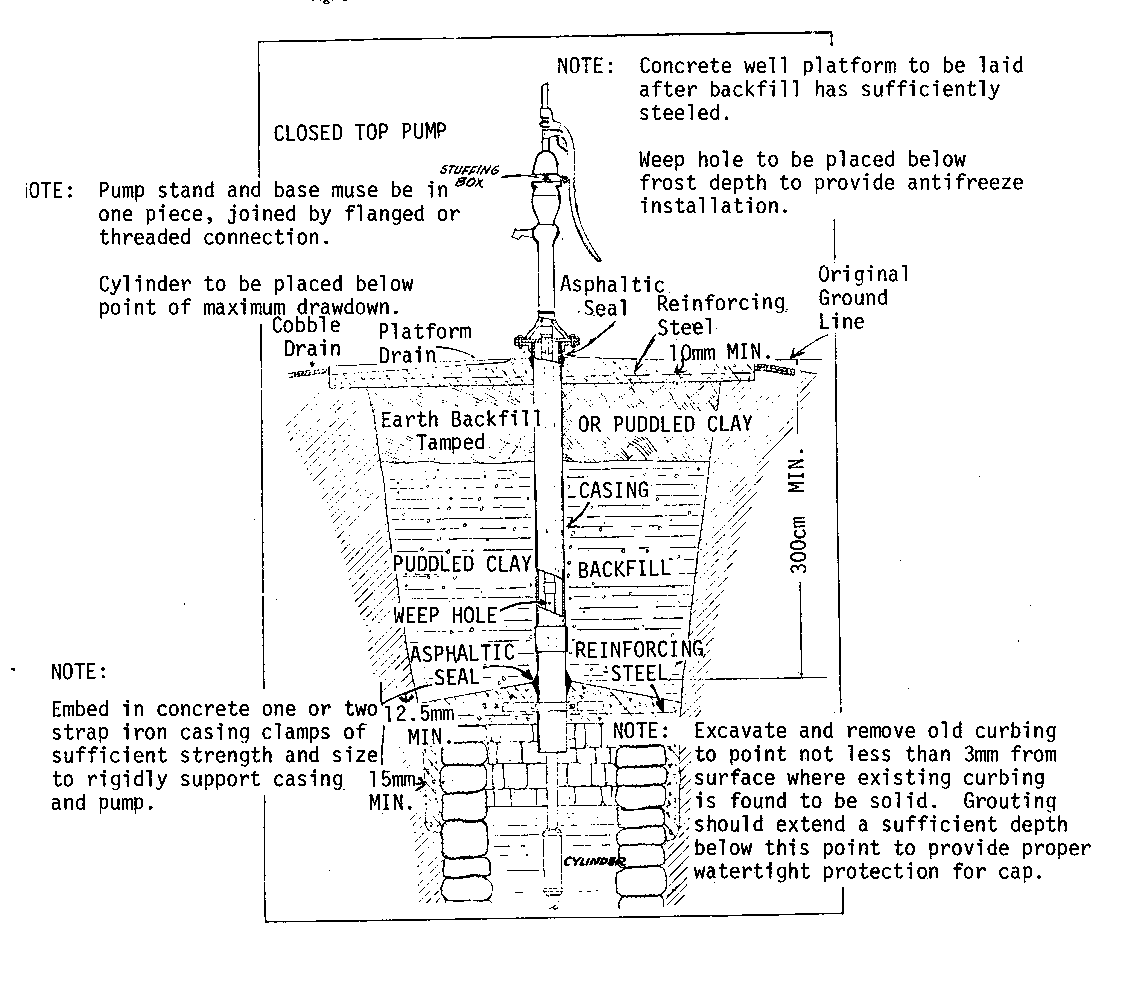
Tools and Materials
Tools and materials for reinforced
concrete
A method for entering the well
Pump and drop pipe
Before starting, check the following:
* Is the well
dangerously close to
a privy or other
source of contamination?
Is it close to a
water
source? Is it
desirable to dig a
new well elsewhere
instead of
cleaning this one?
Could a privy
be moved, instead?
* Has the well ever
gone dry? Should
you deepen it as
well as clean it?
* Surface drainage
should generally
slope away from
the well and there
should be
effective disposal of
spilled water.
* What method will
you use to remove
the water and what
will it cost?
* Before entering
the well to inspect
the old lining,
check for a lack
of oxygen by
lowering a lantern or
candle.
If the flame remains lit,
it is reasonably
safe to enter the
well.
If the flame goes out, the
well is dangerous
to enter. When
the well is
entered, have a rope
tied to the person
and two strong
men to pull him
out in case of
accident.
Relining the Wall
The first job is to
prepare the upper
3 meters (10') of the lining for concrete
by removing loose rock and chipping
away old mortar with a chisel, as
deep as possible (see Figure 4).
The
uwr4x63.gif (600x600)
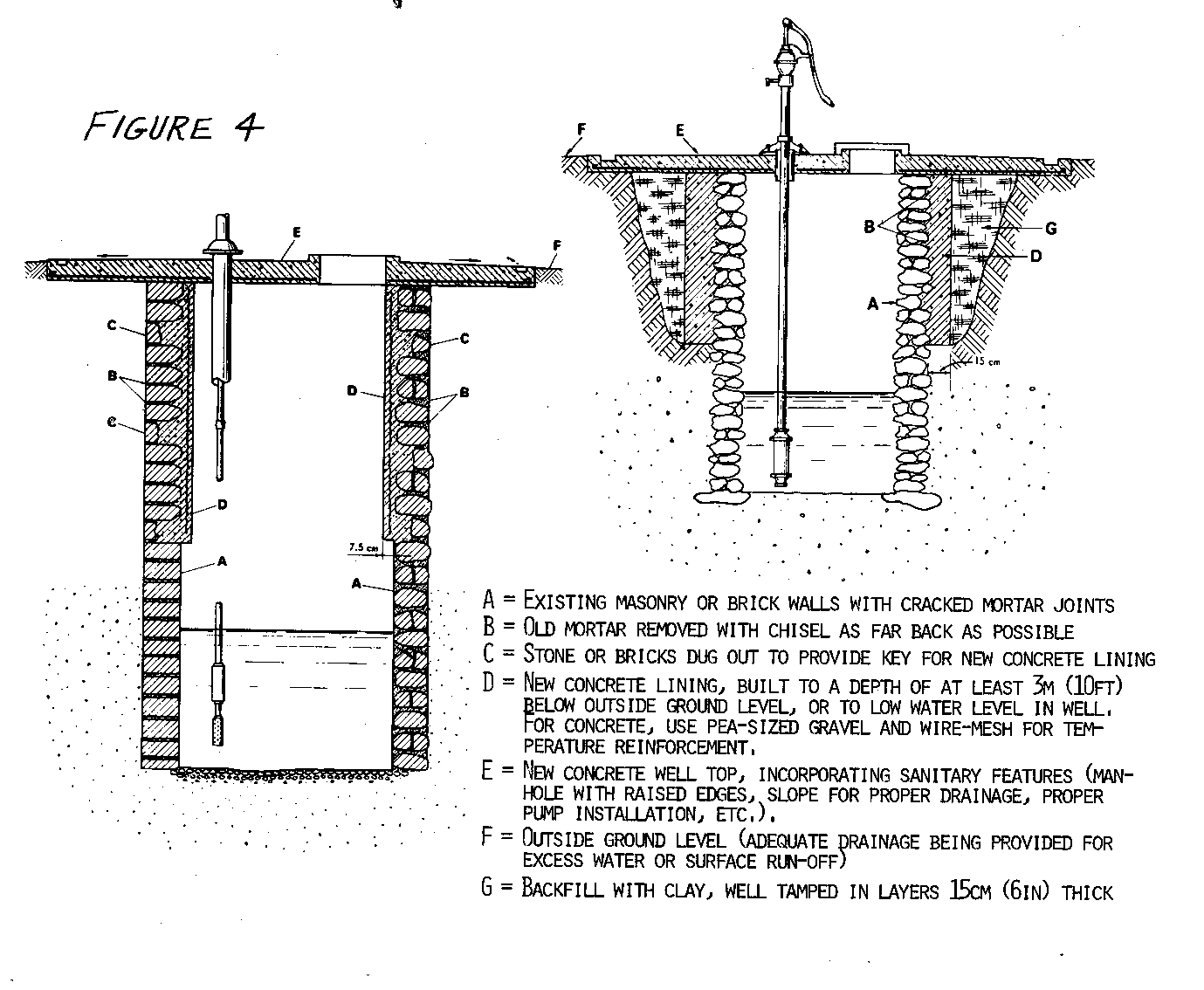
next task is to clean out and deepen
the well, if that is necessary.
All
organic matter and silt should be bailed
out. The well may be
dug deeper,
particularly during the dry season,
with the methods outlined in the article
on "Deep Dug Wells." One way to
increase the water yield is to drive
a well point deeper into the water-bearing
soil. This normally
will not
raise the level of water in the well,
but may make the water flow into the
well faster. The
well point can be
piped directly to the pump, but this
will not make use of the reservoir
capacity of the dug well.
The material
removed from the well
can be used to help form a mound
around the well so water will drain
away from the well site.
Usually,
additional soil will be needed for this
mound. A drain lined
with rock should
be provided to take spilled water
away from the concrete apron that
covers the well.
Reline the well
with concrete
troweled in place over wire mesh reinforcement.
The largest aggregate
should be pea-sized gravel and the
mix should be fairly rich with concrete,
using no more than 5 1/2 to 6 gallons
of water to a 94-pound sack of cement.
Extend the lining 70cm (27 1/2 inches)
above the original ground surface.
Installing the Cover and Pump
Cast the well cover
so that it makes
a watertight seal with the lining to
keep surface impurities out.
The
cover will also support the pump.
Extend
the slab out over the mound about
a meter (a few feet) to help drainage
away from the site.
Make a manhole and
space for the drop pipe of the pump.
Mount the pump off center so there is
room for the manhole.
The pump is
mounted on bolts cast into the cover.
The manhole must be 10cm (4") higher
than the surface of the slab.
The
manhole cover must overlap by 5cm (2")
and should be fitted with a lock to
prevent accidents and contamination.
Be sure that the pump is sealed to the
slab.
Disinfecting the Well
Disinfect the well
by using a stiff
brush to wash the walls with a very
strong solution of chlorine.
Then add
enough chlorine in the well to make
it about half the strength of the
solution used on the walls.
Sprinkle
this last solution all over the surface
of the well to distribute it
evenly. Cover the
well and pump up
the water until the water smells strongly
of chlorine. Let the
chlorine remain
in the pump and well for one
day and then pump it until the chlorine
is gone.
Testing the Water
Have the well water
tested several
days after disinfection to be sure that
it is pure. If it is
not, repeat the
disinfection and testing.
If it is
still not pure, get expert advice.
Sources:
Water Supply for Rural Areas and Small
Communities, by. E. G. Wagner and J. N.
Lanoix, World Health Organization,
1959.
Manual of Individual Water Supply
Systems, U.S. Department of Health,
Education and Welfare, Public Health
Service Publication No. 24.
Water Lifting and Transport
Once a source of
water has been found
and developed, four basic questions must
be answered:
1. What is the rate
of flow of water
needed in your
situation?
2. Between what
points must the water
be transported?
3. What kind and
size of piping is
needed to
transport the required
flow?
4. What kind of
pump, if any, is necessary
to produce the
required flow?
The information in
this section will
help you to answer the third and fourth
questions, once you have determined the
answers to the first two.
Water Transport
The first three
entries are equations
and alignment charts (also called nomographs)
which give simple methods of
estimating the flow of water under the
force of gravity, that is, without pumping.
The fourth tells how to measure
flow by observing the spout from a horizontal
pipe.
Pipe Size
You will note that
in these and other
alignment charts, the term "nominal diameter,
inches, U.S. Schedule 40" is used
along with the alternate term, "inside
diameter in centimeters," in referring
to pipe size.
Pipes and fittings
are usually manufactured
to a standard schedule of sizes.
U.S. Schedule 40, the most common in the
United States, is also widely used in
other countries. When one specifies "2
inch Schedule 40", one automatically
specifies the pressure rating of the pipe
and its inside and outside diameters
(neither of which, incidentally, is actually
2"). If the schedule is not known,
measure the inside diameter and use this
for flow calculations.
Water Lifting
The next four
entries follow the steps
required to design a water-pumping system
with piping.
The first entry in
this group, "Pump
Selection" presents all factors that must
be considered in selecting a pump. One
should fill out the form included in the
entry and make a piping sketch whether he
plans to send it to a consultant for help
or do the design and selection himself.
The next three
entries enable the reader
to design his own piping system and
specify his own pump.
Selecting a Pump
The first information needed for selecting
pump type and size is: (1) the
flow rate of water needed and (2) the
head" or pressure to be overcome by
the pump. This "head" is composed of
two parts, (a) the height the liquid
must be raised and (b) the resistance
to flow created by the pipe walls (friction-loss).
The friction-loss
"head" is the most
difficult factor to measure. The entry,
"Determining Pump Size and Horsepower
Requirement," page 82 describes how to
select the economic pipe size(s) for the
flow desired. With the pipe(s) selected
one must then calculate the friction-loss
head. The entry "Estimating Flow Resistance
of Pipe Fittings" makes it possible
to estimate extra friction caused by constrictions
of pipe fittings. With this
information and the length of pipe, it
is possible to estimate the pump power
requirement using the entry, "Determining
Pump Size and Horsepower Requirement."
These four entries
have another very
important use. You may already have a
pump and wonder "Will it do this job?"
or "What size motor should I buy to do
this job with the pump I have?". The
entry "Pump Selection" can be used to
collect all the information on the pump
and on the job you want it to do. With
this information, you can ask a consultant
or VITA if the pump can be used or
not.
Pumps
There are many
varieties of pumps for
lifting water from where it is to where
it is to be delivered. But, for any particular
job, there are probably one or
two kinds of pumps which will serve better
than others. We will discuss here
only two broad classes of pumps: lift
pumps and force pumps.
Lift Pumps
A lift or suction
pump is located at
the top of a well and raises water by
suction. Even the most efficient suction
pump can create a negative pressure
of only 1 atmosphere: theoretically,
it could raise a column of water
10.3m (34') at sea level. But because
of friction losses and the effects of
temperature, a suction pump at sea
level can actually lift water only
6.7m to 7.6m (22' to 25'). The entry
on "Lift Pump Capability" explains how
to find out the height a lift pump will
raise water at different altitudes with
different water temperatures.
Force Pumps
When a lift pump is
not adequate, a
force pump must be used. With a force
pump, the pumping mechanism is placed
at or near the water level and pushes
the water up. Because it does not depend
on atmospheric pressure, it is
not limited to a 7.6m (25') head.
Construction Details
Construction
details are given on two
irrigation pumps which can be made at the
village level. An easy-to-maintain pump
handle mechanism is described. Suggestions
are also given on using bamboo for
piping.
Further details on pumps are given in:
Water Lifting Devices for Irrigation, by
Aldert Molenaar, Food and Agriculture
Organization of the United Nations, Rome,
1956.
Small Water Supplies, The Ross Institute,
The London School of Hygiene and Tropical
Medicine, London, 1967.
Water Supply for Rural Areas and Small
Communities, by Edmund G. Wagner and
J. N. Lanoix, World Health Organization,
Geneva, 1959.
Wells, TM 5-297/Armed Forces Manual 85-23, Government
Printing Office, Washington,
D.C., 1957.
ESTIMATING SMALL STREAM WATER FLOW
A rough but very
rapid method of estimating
water flow in small streams is
given here. In looking for water
sources for drinking, irrigation or
power generation, one should survey all
the streams available.
If sources are
needed for use over a
long period, it is necessary to collect
information throughout the year to determine
flow changes--especially high
and low flows. The number of streams
that must be used and the flow variations
are important factors in determining the
necessary facilities for utilizing the
water.
Tools and Materials
Timing device, preferably watch with second
hand
Measuring tape
Float (see below)
uwr1x65.gif (218x437)
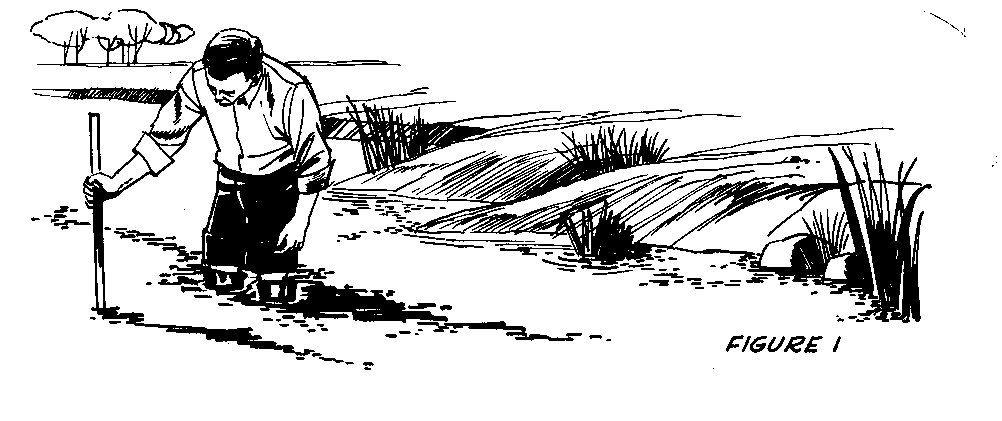
Stick for measuring depth
The following
equation will help you
to measure flow quickly: Q = K x A x V,
where:
Q (Quantity) = flow in liters per minute
A (Area) = cross-section of stream, perpendicular
to flow, in square
meters
V (Velocity) = stream velocity, meters
per minute
K (Constant) = a corrected conversion
factor. This is
used because surface
flow is normally
faster than average
flow. For normal
stages use K = 850;
for flood stages
use K = 900 to 950.
To Find A (Area) of a Cross-Section
The stream will
probably have different
depths along its length so select
a place where the depth of the stream
is average.
1. Take a measuring
stick and place it
upright in the
water about 50cm
from the bank.
2. Note the depth of
water.
3. Move the stick 1
meter from the bank
in a line
directly across the stream.
4. Note the depth.
5. Move the stick
1.5 meters from the
bank, note the
depth, and continue
moving it at 50cm
intervals until
you cross the
stream.
Note the depth each time you place the
stick upright in the stream. Draw a
grid, like the one in Figure 2, and mark
uwr2x66.gif (393x393)
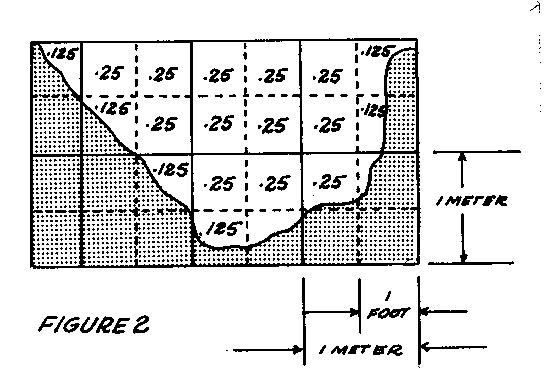
the varying depths on it so that a cross-section
of the stream is shown. A scale
of 1cm to 10cm is often used for such
grids. By counting the grid squares and
fractions of squares, the area of the
water can be estimated. For example,
the grid shown here has a little less
than 4 square meters of water.
To Find V (Velocity)
Put a float in the
stream and measure
the distance of travel in one minute
(or fraction of a minute, if necessary.)
The width of the stream should be as
constant as possible and free of rapids,
where the velocity is being measured.
A light surface
float, such as a chip,
will often change course because of
wind or surface currents. A weighted
float which sits upright in the water
will not change course so easily. A
lightweight tube or tin can, partly
filled with water or gravel so that it
floats upright with only a small part
showing above water, will not change
course so easily and makes a better
float for measuring.
Measuring Wide Streams
For a wide,
irregular stream, it is
better to divide the stream into 2 or
3 meter sections and measure the area
and velocity of each. Q is then calculated
for each section and the Qs
added together to give a total flow.
Example (see Figure 2):
Cross section is 4
square meters
Velocity of float =
6 meters traveled
in 1/2 minute
Stream flow is
normal
Q = 850 x 4 x 6
meters/.5 minutes
Q = 40,800 liters
per minute
or
680 liters per
second
Using English Units
If English units of
measurement are
used, the equation for measuring stream
flow is: Q = K x A x V, where:
Q = flow in U.S. gallons per minute
A = cross-section of stream, perpendicular
to flow, in square
feet
V = stream velocity in feet per minute
K = a corrected conversion factor: 6.4
for normal stages;
6.7 to 7.1 for
flood stages
The grid to be used
would be similar
to the one in Figure 3; a commonly used
uwr3x67.gif (353x353)
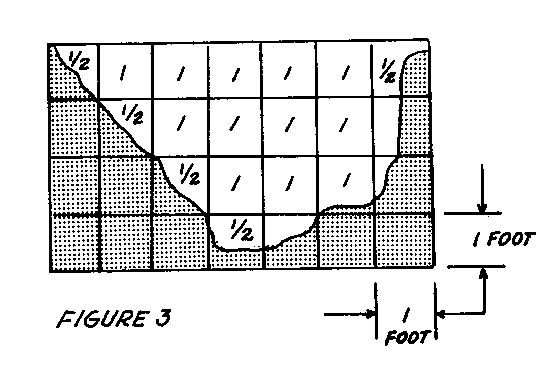
scale is 1" to 12".
Example:
Cross-section is 15
square feet
Velocity of float =
20 feet traveled
in 1/2 minute
Stream flow is
normal
Q = 6.4 x 15 x 20 feet
_______
.5 minute
Q = 3800 gallons per minute
Source:
Design of Fishways and Other Fish Facilities
by C. H. Clay, P. E. Department of
Fisheries of Canada, Ottawa, 1961.
MEASURING THE FLOW OF WATER IN PARTIALLY FILLED PIPES
The flow of water
in partially-filled
horizontal pipes or circular channels
can be determined--if you know the inside
diameter of the pipe and the depth
of the water flowing--by using the
alignment chart (nomograph) in Figure 2.
uwr2x69.gif (486x486)
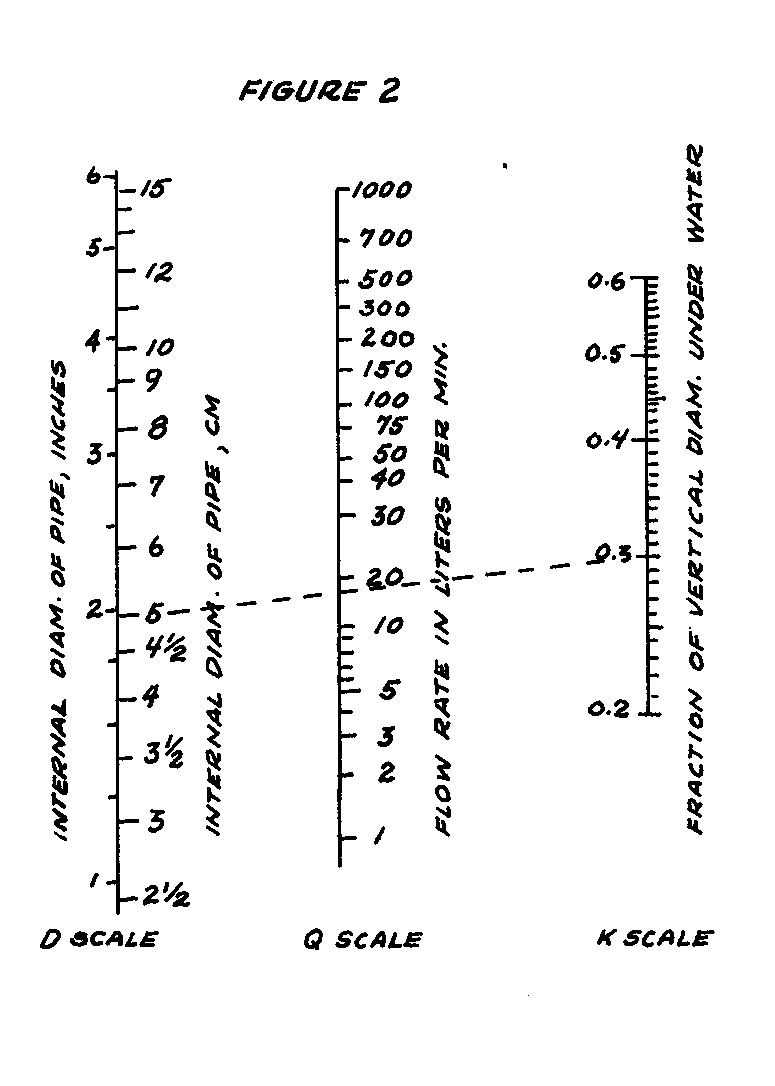
This method can be
checked for low
flow rates and small pipes by measuring
the time required to fill a bucket
or drum with a weighed quantity of water.
A liter of water weighs 1kg (1 U.S.
gallon of water weighs 8.33 pounds).
Tools and Materials
Ruler to measure water depth (if ruler
units are inches
multiply by 2.54 to
convert to
centimeters)
Straight edge, to use with alignment
chart
The alignment chart
applies to pipes
with 2.5cm to 15cm inside diameters, 20
to 60% full of water, and having a reasonably
smooth surface (iron, steel, or
concrete sewer pipe). The pipe or channel
must be reasonably horizontal if
the result is to be accurate. The eye,
aided by a plumb bob line to give a
vertical reference, is a sufficiently
good judge. If the pipe is not horizontal
another method will have to be
used. To use the alignment chart,
simply connect the proper point on the
"K" scale with the proper point of the
"d" scale with the straight edge. The
flow rate can then be read from the
"q" scale.
q = rate of flow of water, liters per
minute 8.33
pounds = 1 gallon.
d = internal diameter of pipe in centimeters.
K = decimal fraction of vertical diameter
under water.
Calculate K by
measuring the
depth of water (h)
in the pipe and
dividing it by the
pipe diameter
(d), or K = h/d (see
Figure 1).
uwr1x68.gif (285x285)
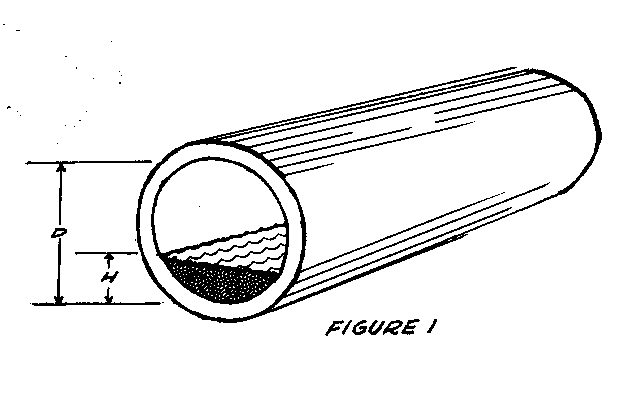
Example:
What is the rate of
flow of water in
a pipe with an internal diameter of 5cm,
running 0.3 full? A straight line connecting
5 on the d-scale with 0.3 on
the K-scale intersects the q-scale at a
flow of 18 liters per minute. <see figure 2>
Source:
Greve Bulletin, Purdue University (12,
No. 5, 1928, Bulletin 32).
DETERMINING PROBABLE WATER FLOW WITH KNOWN
RESERVOIR HEIGHT
AND SIZE AND LENGTH OF PIPE
The alignment chart
in Figure 1 gives
uwr1x71.gif (540x540)
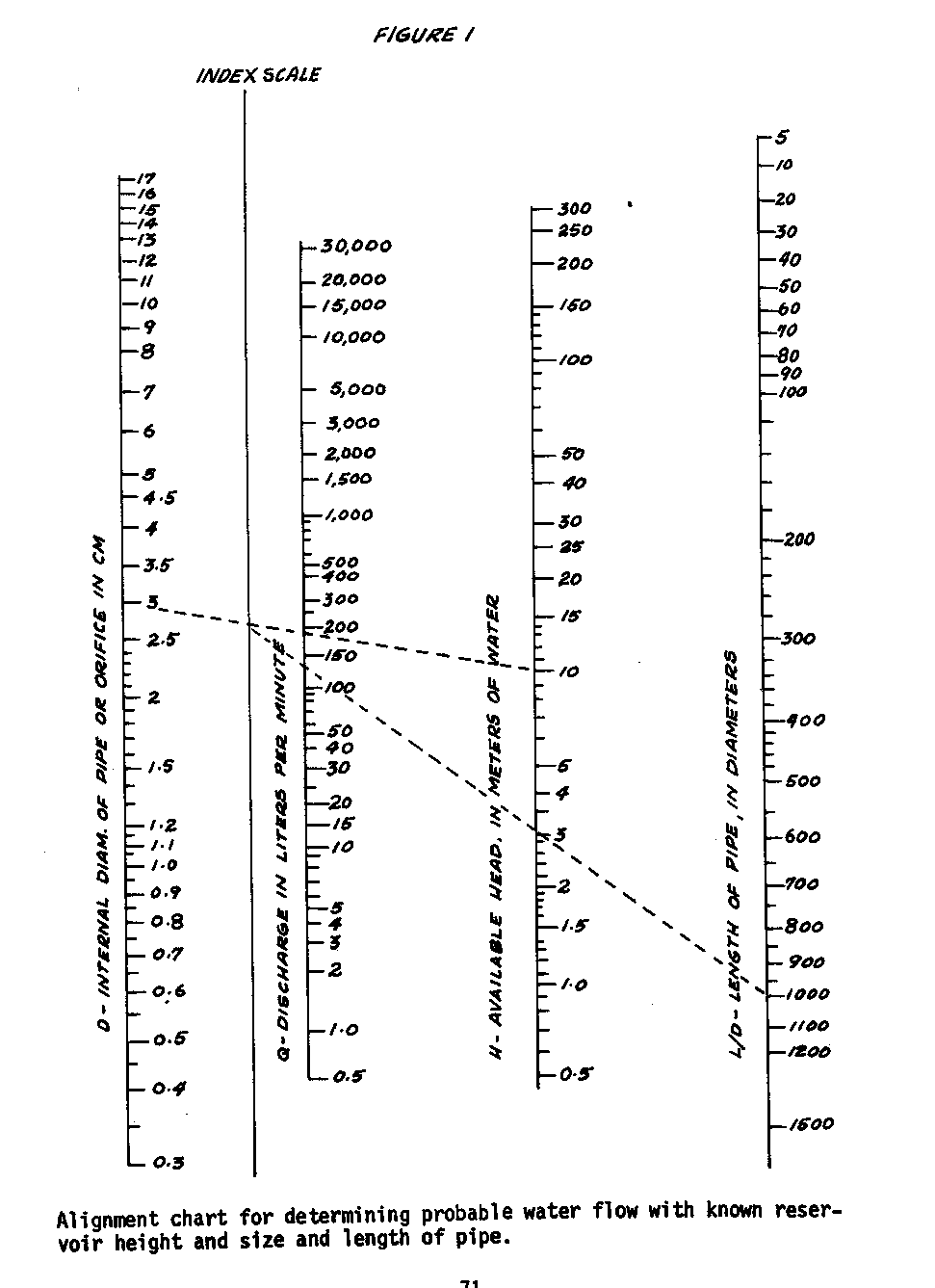
a reasonably accurate determination of
water flow when pipe size, pipe length
and height of the supply reservoir are
known.
The example given
here is for the
analysis of an existing system. To
design a new system, assume a pipe diameter
and solve for flow-rate, repeating
the procedure with new assumed diameters
until one of them provides a suitable
flow rate.
Materials
Straight edge, for use with alignment
chart
Surveying instruments, if available
The alignment chart
was prepared for
clean, new steel pipe. Pipes with
rougher surfaces or steel or cast iron
pipe which has been in service for a
long time may give flows as low as 50
percent of those predicted by this
chart.
The available head
(h) is in meters
and is taken as the difference in
elevation between the supply reservoir
and the point of demand. This may be
crudely estimated by eye, but for
accurate results some sort of surveying
instruments are necessary.
For best results,
the length of pipe
(L) used should include the equivalent
lengths of fittings as described in
handbook entry "Flow Resistance of
Pipe Fittings," p. 80. This length
(L) divided by the pipe internal diameter
(D) gives the necessary "L/D"
ratio. In calculating L/D, note that
the units of measuring both "L" and
"D" must be the same, e.g.: feet
divided by feet; meters divided by
meters; centimeters by centimeters.
Example:
Given Available
Head (h) of 10 meters,
pipe internal diameter (D) of 3cm, and
equivalent pipe length (L) of 30 meters
3000cm.
Calculate L/D =
3000cm = 1000
______
3cm
The alignment chart
solution is in two
steps:
1. Connect Internal
Diameter 3cm to
Available Head
(10 meters), and make
a mark on the
Index Scale. (In this
step, disregard
"Q" scale)
2. Connect mark on
Index Scale with L/D
(1000), and read
flow rate (Q) of
approximately 140
liters per minute.
Source:
Crane Company Technical Paper #407, pages
54-55.
ESTIMATING WATER FLOW FROM HORIZONTAL PIPES
If a horizontal
pipe is discharging a
full stream of water, you can estimate
the rate of flow from the alignment chart
in Figure 2. This is a standard engineering
uwr2x73.gif (600x600)
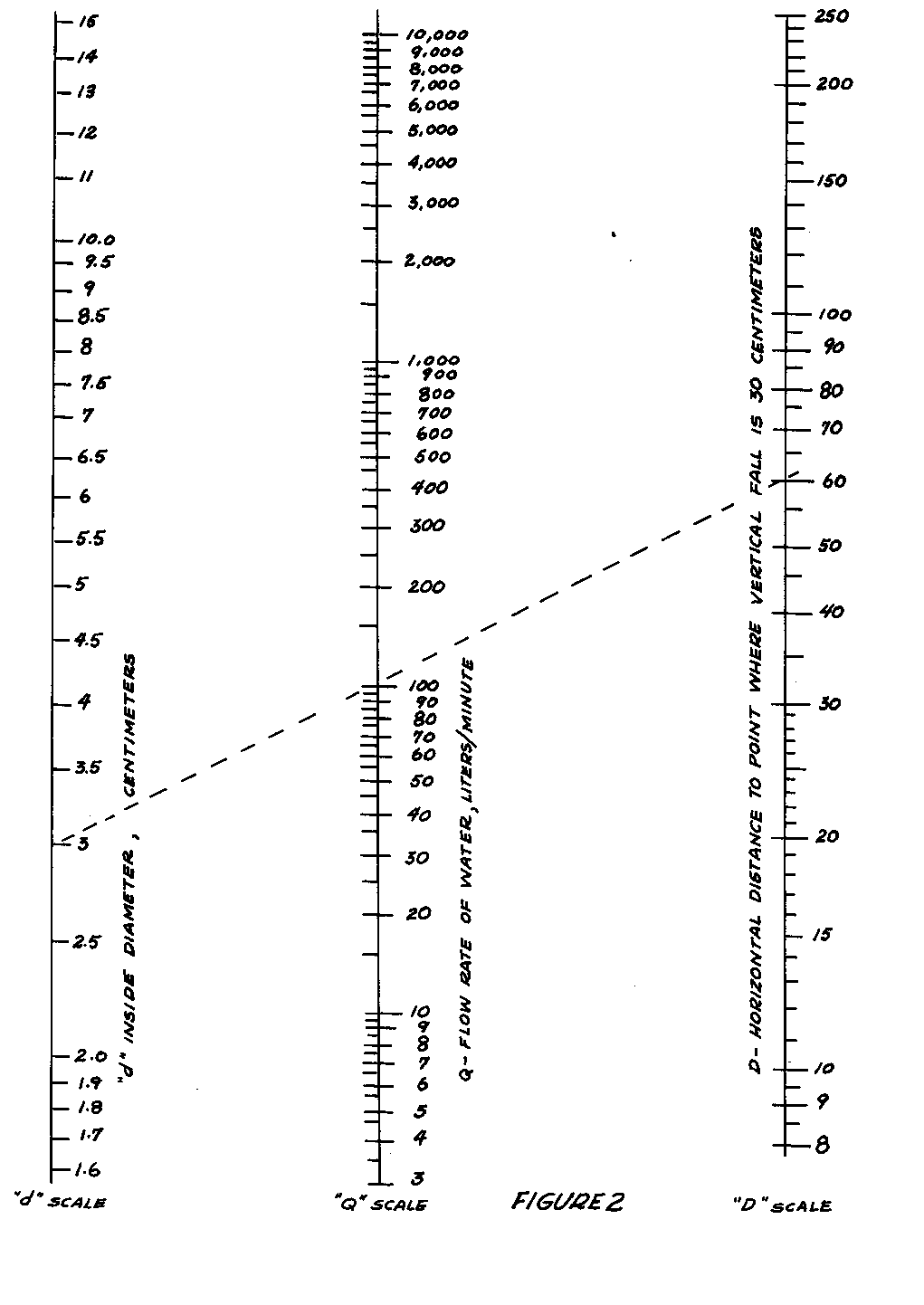
technique for estimating flows;
its results are usually accurate to within
10 percent of the actual flow rate.
Materials
Straightedge and pencil, to use alignment
chart
Tape measure
Level
Plumb bob
The water flowing
from the pipe must
completely fill the pipe opening (see
Figure 1). The results from the chart
uwr1x72.gif (437x437)
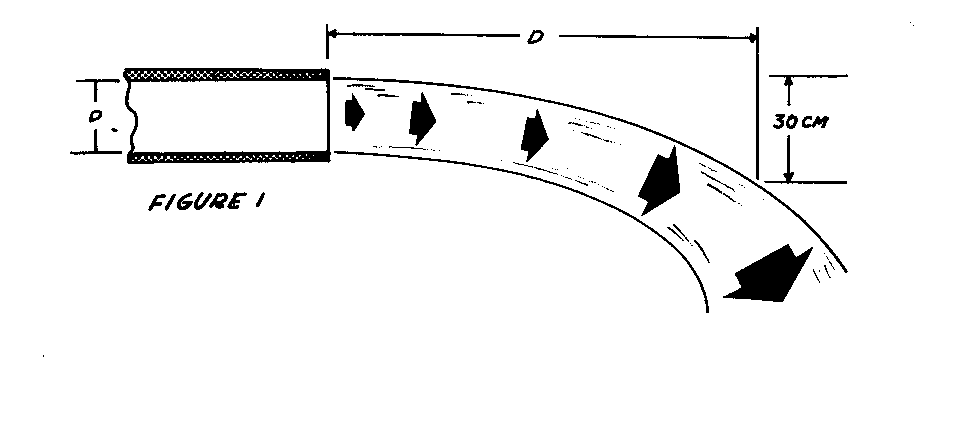
will be most accurate when there is no
constricting or enlarging fitting at the
end of the pipe.
Example:
Water is flowing
out of a pipe with an
inside diameter (d) of 3cm (see Figure 1).
The stream drops 30cm at a point
60cm from the end of the pipe.
Connect the 3cm
inside diameter point
on the "d" scale in Figure 2 with the
60cm point on the "D" scale. This line
intersects the "q" scale at about 100
liters per minute, the rate at which
water is flowing out of the pipe.
Source:
"Flow of Water from Horizontal Open-end
Pipes," by Clifford L. Duckworth, Chemical
Processing, June 1959, p. 73.
PUMP SPECIFICATION: Choosing a Pump for
a Specific Job or Evaluating an Available
Pump
The form given in
Figure 1, the "Pump
Application Fact Sheet," is a check list
uwrx75.gif (600x600)
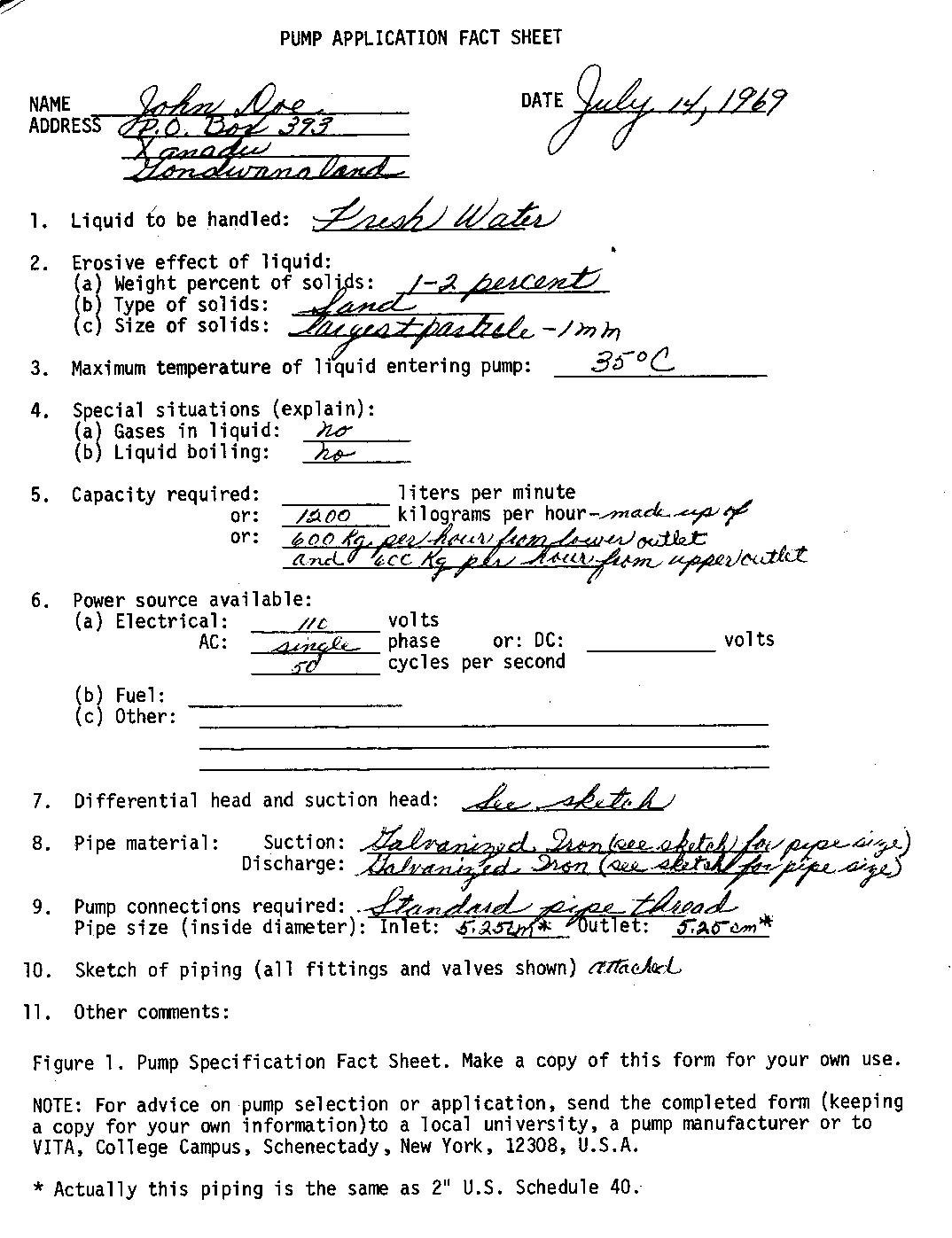
for collecting the information needed to
get help in choosing a pump for a particular
situation. If you have a pump on
hand, you can also use the form to estimate
what its capabilities are. The
form is an adaptation of a standard pump
specification sheet used by engineers.
If you are doubtful
about how much information
to give, it is better to give
too much information rather than risk
not giving enough. When seeking advice
on how to solve a pumping problem or
when asking pump manufacturers to specify
the best pump for your service,
give complete information on what its
use will be and how it will be installed,
If the experts are not given all the
details, the pump chosen may give you
trouble.
To give a better
idea of how to use
the "Pump Application Fact Sheet," it
is shown filled in for a typical situation.
For your own use, make a copy
of the form. The following comments on
each numbered item on the fact sheet
will help you to complete the form adequately.
1. Give the exact
composition of the
liquid to be
pumped: fresh or salt
water, oil,
gasoline, acid, alkali,
etc.
2. Weight percent of
solids can be found
by getting a
representative sample
in a pail. Let
the solids settle
to the bottom and
decant off the
liquid (or filter
the liquid through
a cloth so that
the liquid coming
through is
clear). Weigh the solids
and the liquid,
and give the weight
percent of
solids.
If this is not
possible, measure
the volume of the
sample (in liters,
U.S. gallons,
etc.) and
the volume of
solids (in cubic
centimeters,
teaspoons. etc.) and
send these
figures. Describe the
solid material
completely and send
a small sample if
possible. This
is important
since, if the correct
pump is not
selected, the solids
will erode and
break moving parts.
Weight percent of
solids =
100 x weight of
solids in liquid sample
_______________________________________
weight of
liquid sample
3.
If you do not have a thermometer to
measure
temperature, guess at it,
making sure you
guess on the high
side. Pumping
troubles are often
caused when
liquid temperatures at
the intake are
too high.
4. Gas bubbles or
boiling cause special
problems, and
must always be mentioned.
5. Give the capacity
(the rate at which
you want to move
the liquid) in any
convenient units
(liters per minute,
U.S. gallons per
minute) by giving
the total of the
maximum capacity
needed for each
outlet.
6. Give complete
details on the power
source.
A.
If you are buying an electric
motor for the
pump, be sure to give
your voltage. If
the power is A.C.
(Alternating
Current) give the
frequency (in
cycles per second)
and the number of
phases. Usually
this will be
single phase for most
small motors. Do
you want a pressure
switch or other
special means
to start the
motor automatically?
B. If you want to
buy an engine
driven pump,
describe the type and
cost of fuel, the
altitude, maximum
air temperature,
and say whether the
air is unusually
wet or dusty.
C. If you already
have an electric
motor or engine,
give as much information
about it as you
can. Give
the speed, sketch
the machine, being
especially careful
to show the power
shaft diameter
and where it is with
respect to the
mounting. Describe
the size and type
of pulley if you
intend to use a
belt drive. Finally,
you must estimate
the power. The
best thing is to
copy the nameplate
data completely.
If the following
data is available
for your engine,
give the number
of cylinders, their
size, and the
stroke if possible.
7. The
"head" or pressure to be overcome
by the pump and
the capacity (or required
flow of water)
determine the
pump size and
power. The entry
"Pump Size
and Horsepower Requirement",
page 82, explains
the calculation
of simple head
situations.
The best approach
is to explain the
"heads"
by drawing an accurate piping
sketch (see Item 10 in the "Pump
Application Fact
Sheet"). Be sure
to give the
suction lift and piping
separately from
the discharge lift
and piping. An
accurate description
of the piping is
essential for calculating
the friction head.
See
Figure 2.
uwr2x77.gif (600x600)

8. The piping
material, inside diameter,
and thickness are
necessary
for making the
head calculations
and to check
whether pipes are
strong enough to
withstand the
pressure. See
"Water Lifting and
Transport"
for comments on specifying
pipe diameter.
9. Connections to
commercial pumps are
normally flanged
or standard pipe
thread.
10. In the sketch be
sure to show the
following:
(a) Pipe sizes;
show where sizes
are changed
by indicating reducing
fittings.
(Read "Introduction"
for comments
on
pipe
diameter.)
(b) All pipe
fittings--elbows,
tees, valves
(show valve
type), etc.
(c) Length of
each pipe run in a
given direction. Length of
each size
pipe and vertical
lift are the
most important
dimensions.
11. Give information
on how the pipe will
be used. Comment
on such information
as:
Indoor or
outdoor installation?
Continuous or
intermittent service?
Space or weight
limitations?
NOTE: For advice on pump selection or
application, send a completed "Pump
Application Fact Sheet" to a local university,
a pump manufacturer or to VITA,
College Campus, Schenectady, New York
12308, U.S.A.
Source:
Benjamin P. Coe, P.E./Executive Director,
VITA, Schenectady, New York
DETERMINING PIPE SIZE OR VELOCITY OF WATER IN PIPES
The choice of pipe
size is one of
the first steps in designing a simple
water system.
The alignment chart
in Figure 1 can
uwr1x79.gif (600x600)
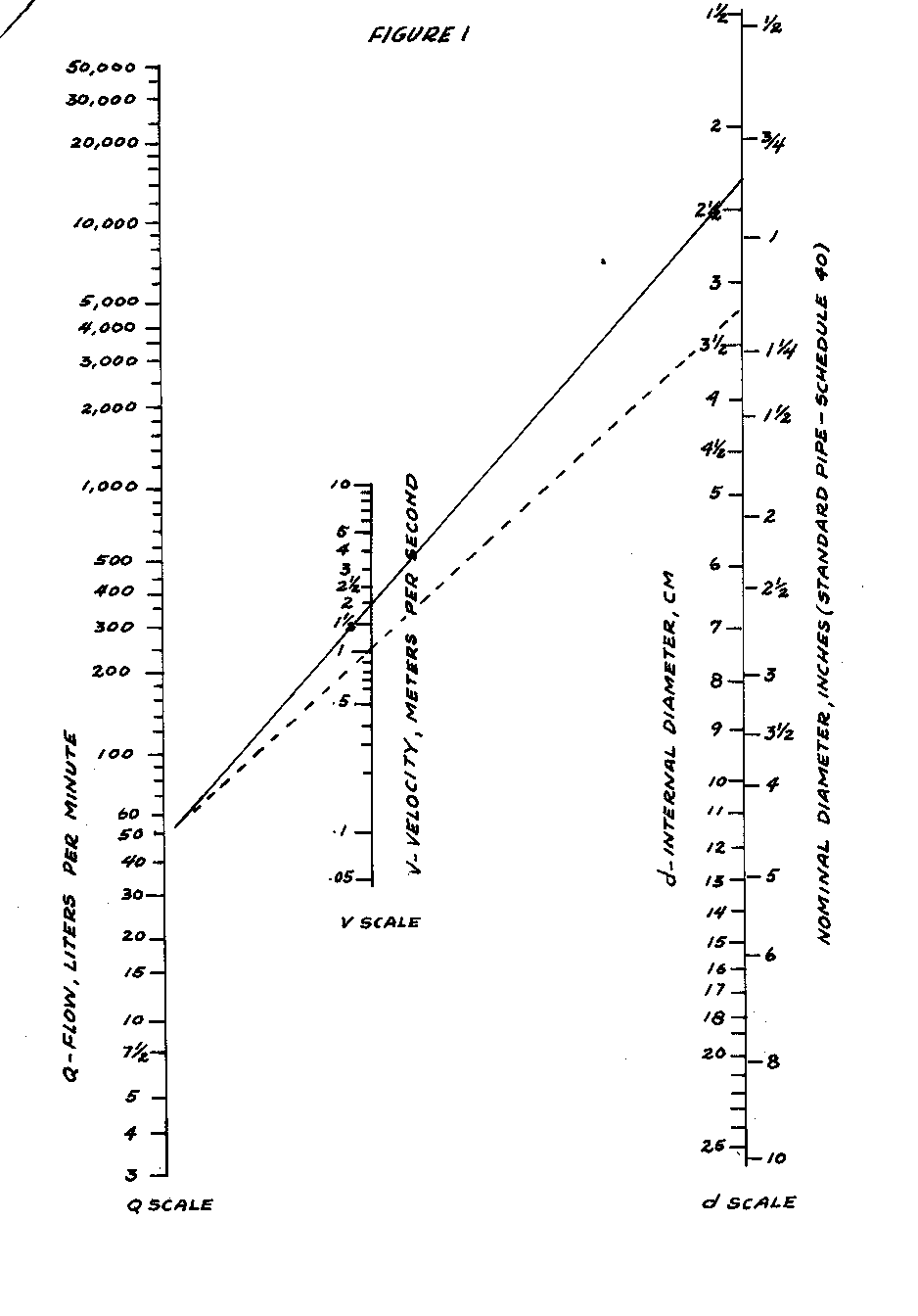
be used to compute the pipe size needed
for a water system when the water
velocity is known.
The chart can also
be used to find out what water velocity
is needed with a given pipe size to
yield the required rate of flow.
Tools and Materials
Straightedge and pencil
Practical water
systems use water
velocities from 1.2 to 1.8 meters per
second. Very fast
velocity requires
high pressure pumps which in turn require
high pressure pumps which in
turn require large motors and use
excessive power.
Velocities which
are too low are expensive because
larger pipe diameters must be used.
It may be advisable
to calculate the
cost of two or more systems based on
different pipe size.
Remember, it is
usually wise to choose a little larger
pipe if higher flows are expected in
the next 5 or 10 years.
In addition,
water pipes often build up rust and
scale reducing the diameter and thereby
increasing the velocity and pump
pressure required to maintain flow at
the original rate.
If extra capacity
is designed into the piping system,
more water can be delivered by adding
to the pump capacity without changing
all the piping.
To use the chart,
locate the flow
(liters per minute) you need on the
Q-scale. Draw a line
from that point,
though 1.8m/sec velocity on the V-scale
to the d-scale.
Choose the nearest
standard size pipe.
Example:
Suppose you need a
flow of 50 liters
per minute at the time of peak demand.
Draw a line from 50 liters per minute
on the Q-scale through 1.8m/sec on
the V-scale. Notice
that this intersects
the d-scale at about 2.25.
The
correct pipe size to choose would be
the next largest standard pipe size:
e.g. 1" nominal diameter, U.S. Schedule
40. If pumping costs
(electricity or
fuel) are high, it would be well to limit
limit velocity to 1.2m/sec and install
a slightly larger pipe size.
Source:
Crane Company Technical Paper #409,
pages 46-47.
ESTIMATING FLOW RESISTANCE OF PIPE
FITTINGS
One of the forces
which a pump must
overcome to deliver water is the
friction/resistance of pipe fittings and
valves to the flow of water.
Any bends,
valves, constrictions or enlargements
(such as passing through a tank) add to
friction.
The alignment chart
in Figure 1 gives
uwr1x81.gif (600x600)
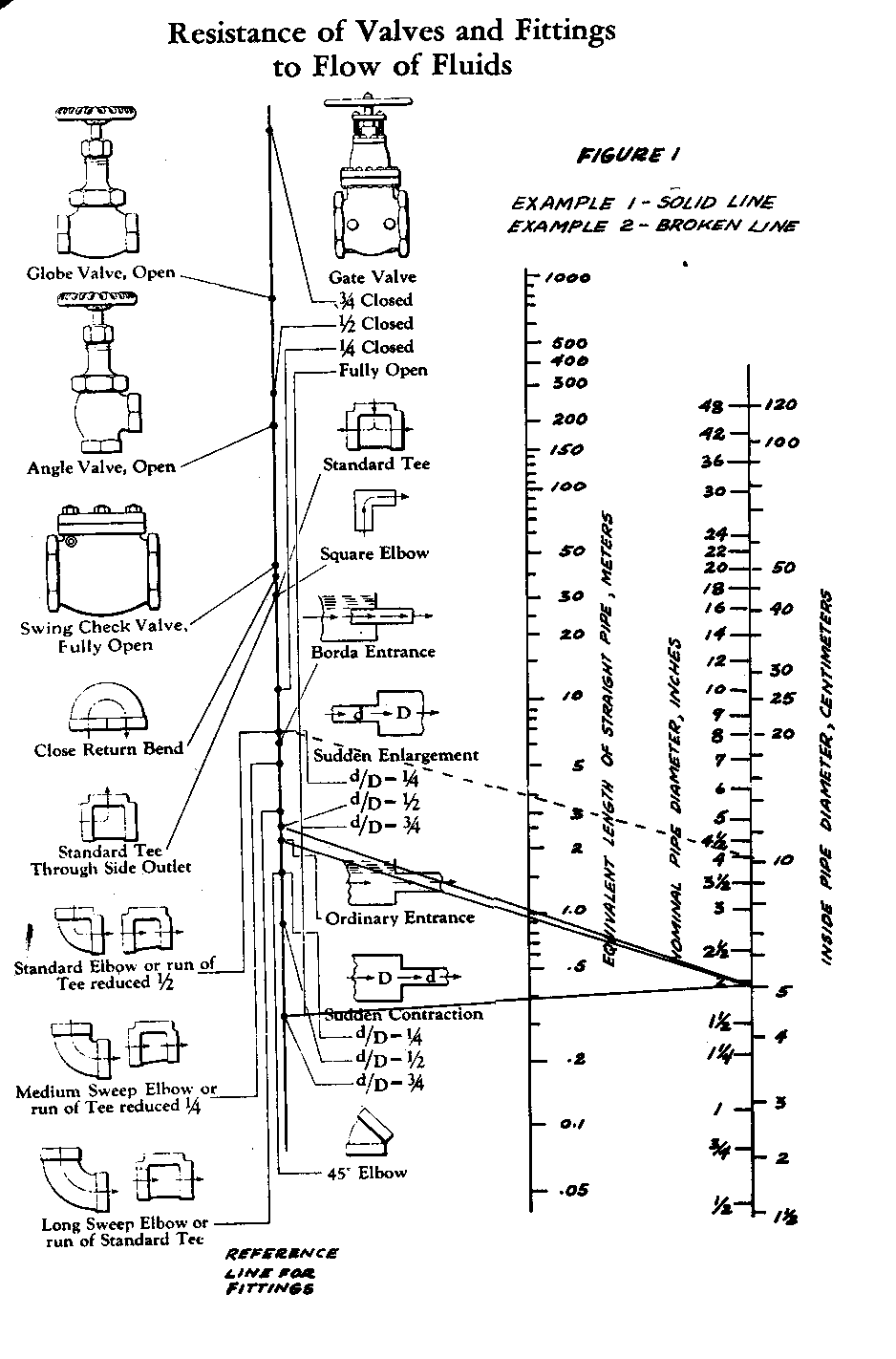
a simple but reliable way to estimate
this resistance: it gives the equivalent
length of straight pipe which would have
the same resistance.
The sum of these
equivalent lengths is then added to the
actual length of pipe: this gives the
total equivalent pipe length, which is
used in the following entry, "Determining
Pump Capacity and Horsepower Requirement,"
to determine total friction
loss.
Rather than
calculate the pressure
drop for each valve or fitting separately,
this chart will give the equivalent
length of straight pipe.
Valves: Note the
difference in equivalent
length depending on how far the
valve is open.
1. Gate Valve - full
opening valve; can
see through it
when open; used for
complete shut off
of flow.
2. Globe Valve -
cannot see through it
when open; used
for regulating flow.
3. Angle Valve -
like the globe, used
for regulating
flow.
4. Swing Check Valve
- a flapper opens
to allow flow in
one direction but
closes when water
tries to flow in
the opposite
direction.
Fittings
Study the variety
of tees and elbows:
note carefully the direction of flow
through the tee. To
determine the equivalent
length of a fitting, (a) pick
proper dot on "fitting" line, (b) connect
with inside diameter of pipe,
using a straight edge; read equivalent
length of straight pipe in meters, (c)
add the fitting equivalent length to
the actual length of pipe being used.
Source:
Crane Company Technical Paper #409,
pages 20-21.
Example 1:
Pipe with 5cm
inside diameter Equivalent Length
in Meters
a. Gate Valve (fully
open)
.4
b. Flow into line -
ordinary entrance
1.0
c. Sudden
enlargement into 10cm pipe
(d/D = 1/2)
1.0
d. Pipe length
10.0
Total Equivalent Pipe Length
12.4
Example 2:
Pipe with 10cm
inside diameter
Equivalent Length in Meters
a. Elbow
(standard)
4.0
b. Pipe length
10.0
Total Equivalent Pipe Length
14.0
DETERMINING PUMP OUTLET SIZE AND HORSEPOWER REQUIREMENT
With the alignment
chart in Figure 2,
uwr2x84.gif (600x600)

you can determine the necessary
pump size (diameter of discharge outlet)
and the amount of horsepower
needed to power the pump.
The power
can be supplied by men or by motors.
A man can generate
about 0.1 horsepower
(HP) for a reasonably long period
and 0.4 HP for short bursts.
Motors are designed for varying amounts
of horsepower.
Tools
Straight edge and pencil for alignment
chart
To get the
approximate pump size
needed for lifting liquid to a known
height through simple piping, follow
these steps:
1. Determine the
quantity of flow desired
in liters per
minute.
2. Measure the
height of the lift required
(from the point
where the
water enters the
pump suction
piping to where
it discharges).
3. Using the entry
"Determining Pipe
Size or Velocity
of Water in
Pipes," page
78, choose a pipe
size which will
give a water velocity
of about 1.8
meters per
second (6' per second).
This
velocity is
chosen because it
will generally
give the most
economical
combination of pump
and piping; Step
5 explains how
to convert for
higher or lower
water velocities.
4. Estimate the pipe
friction-loss
"head"
(a 3-meter "head" represents
the pressure at
the bottom
of a 2-meter-high
column of
water) for the
total equivalent
pipe length,
including suction
and discharge
piping and equivalent
pipe lengths for
valves
and fittings,
using the following
equation:
Friction-loss
head =
F x total
equivalent pipe length/100
where F equals
approximate friction
head (in meters)
per 100
meters of
pipe. To get the value
of F, see the
table in Figure 1.
uwr1x81.gif (600x600)

For an
explanation of total equivalent
pipe length, see
the preceding
entry.
5. To find F
(approximate friction
head in meters
per 100m of pipe)
when water
velocity is higher or
lower than 1.8
meters per second,
use the following
equation: <see equation>
uwrx82.gif (353x353)

6. Obtain
"Total Head" as follows:
Total Head =
Height of Lift +
Friction-loss
Head
Pipe inside diameter: cm
2.5 5.1
7.6
10.2 15.2
20.4
30.6 61.2
inches(*) 1"
2"
3" 4"
6" 8"
12"
24"
F (approximate friction
16 7
5
3 2
1.5
1 0.5
loss in meters per 100
meters of pipe)
Figure 1. Average
friction loss in meters for fresh water flowing through steel
pipe when velocity is 1.8 meters (6 feet) per second.
(*) For the degree of accuracy of this method, either actual
inside diameter in
inches or nominal pipe size, U.S. Schedule 40, can be used.
7. Using a straight
edge, connect the
proper point on
the T-scale with
the proper point
on the Q-scale;
read motor
horsepower and pump
size on the other
two scales.
Example:
Desired flow: 400
liters per minute
Height of lift:
16 meters, No
fittings
Pipe size: 5cm
Friction-loss
head: about 1 meter
Total head: 17
meters
Solution:
Pump size: 5cm
Motor
horsepower: 3HP
Note that water
horsepower is less
than motor horsepower (see HP-scale,
Figure 2). This is
because of friction
uwr2x84.gif (600x600)

losses in the pump and motor.
The
alignment chart should be used for
rough estimate only.
For an exact determination,
give all information on
flow and piping to a pump manufacturer
or an independent expert.
He has the
exact data on pumps for various applications.
Pump specifications can be
tricky especially if suction piping
is long and the suction lift is great.
Conversion to Metric Horsepower
Given the limits of
accuracy of this
method, metric horsepower can be considered
roughly equal to the horsepower
indicated by the alignment chart.
Actual metric horsepower can be obtained
by multiplying horsepower by
1.014.
Source:
Nomographic Charts, by C. A. Kulman,
McGraw-Hill Book Co., New York, 1951,
pages 108-109.
DETERMINING LIFT PUMP CAPABILITY
The height that a
lift pump can raise
water depends on altitude and, to a lesser
extent, on water temperature.
The
graph in Figure 1 will help you to find
uwr1x85.gif (600x600)
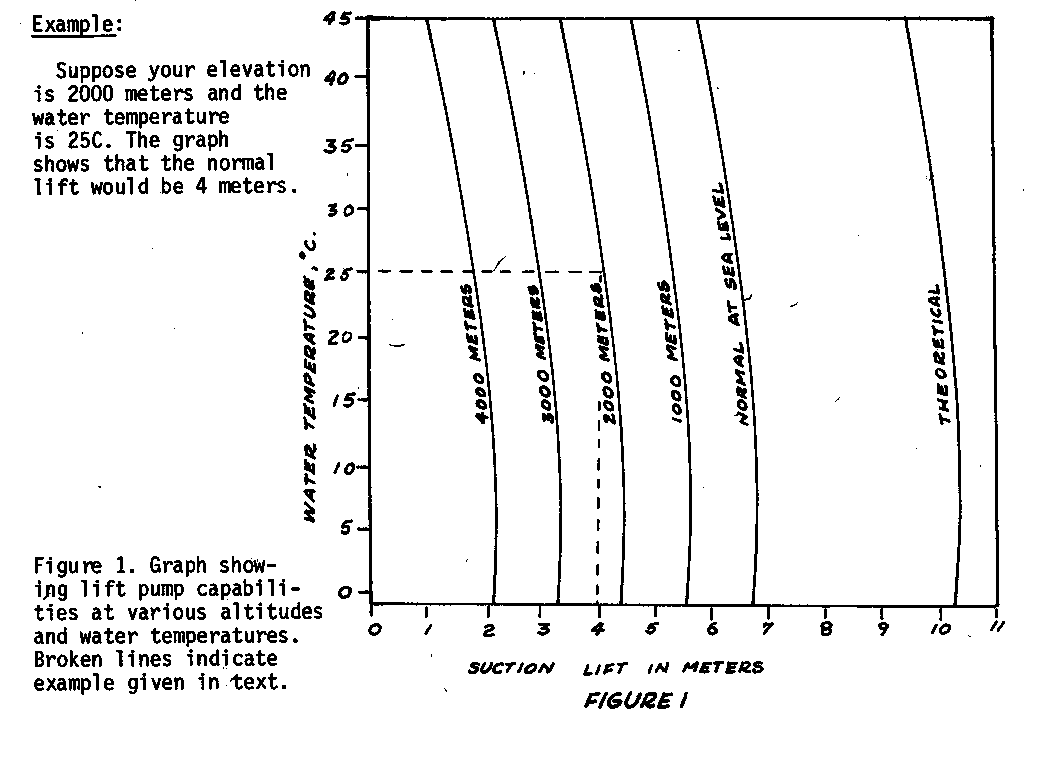
out what a lift pump can do at various
altitudes and water temperatures.
Tools
Measuring tape
Thermometer
If you know your
altitude and the temperature
of your water, Figure 1 will
tell you the maximum allowable distance
between the pump cylinder and the lowest
water level expected.
If the graph
shows that lift pumps are marginal or
will not work, then a force pump should
be used. This
involves putting the
cylinder down in the well, close enough
to the lowest expected water level to
be certain of proper functioning.
The graph shows
normal lifts. Maximum
possible lifts under favorable conditions
would be about 1.2 meters
higher, but this would require slower
pumping and would probably give much
difficulty in "losing the prime."
Check predictions
from the graph by
measuring lifts in nearby wells or by
experimentation.
Source:
Mechanical Engineer's Handbook, by
Theodore Baumeister, 6th edition,
McGraw-Hill Book Co., New York, copyright
1958. Used by
permission.
(Adapted.)
BAMBOO PIPING
Where bamboo is
readily available,
it seems to be a good substitute for
metal pipe. Bamboo
pipe is easy to
make with unskilled labor and local
materials. The
important features of
the design and construction of a bamboo
piping system are given here.
Bamboo pipe is
extensively used in
Indonesia to transport water to villages.
In many rural areas of Taiwan,
bamboo is commonly used in place of
galvanized iron for deep wells up to
a maximum depth of 150 meters (492').
Bamboos of 50mm (2") diameter are
straightened by means of heat, and the
inside nodes knocked out.
The screen
is made by punching holes in the bamboo
and wrapping that section with a
fibrous mat-like material from a palm
tree, Chamaerops humilis.
In fact,
such fibrous screens are also used in
many galvanized iron tube wells.
Tools and Materials
Chisels (see text and Figure 2)
uwr2x87.gif (300x600)
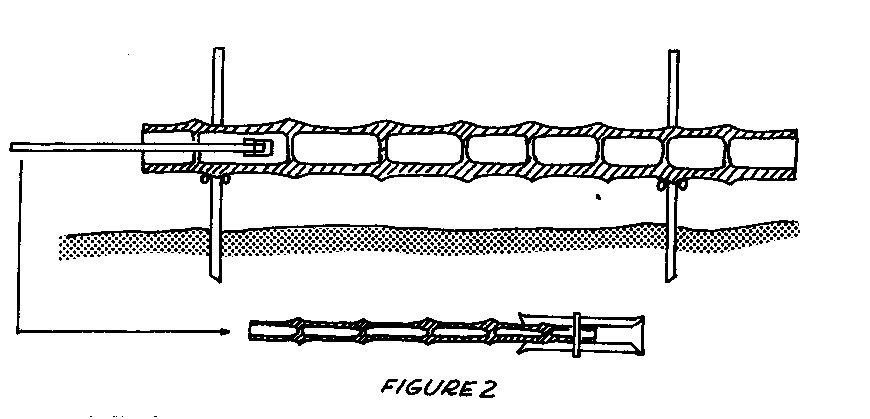
Nail, cotter pin or linchpin
Caulking materials
Tar
Rope
Bamboo piping can
hold pressure up
to two atmospheres (about 2.1kg per
square centimeter or 30 pounds per
square inch). It
cannot, therefore be
used as pressure piping.
It is most
suitable in areas where the source of
supply is higher than the area to be
served and the flow is under gravity.
Health Aspects
If bamboo piping is
to carry water
for drinking purposes, the only preservative
treatment recommended is
boric acid: borax in a 1:1 ratio by
weight. The recommended
treatment is
to immerse green bamboo completely in
a solution of 95 percent water and 5
percent boric acid: borax.
After a bamboo pipe
is put into operation
it gives an undesirable odor to
the water. This,
however, disappears
after about three weeks.
If chlorination
is done before discharge to the
pipe, a reservoir giving sufficient
contact time for effective disinfection
is required since bamboo pipe removes
chlorine compounds and no residual
chlorine will be maintained in the
pipe. To avoid
possible contamination
by ground water, an ever present danger,
it is desirable to maintain the
internal pressure within the pipe at
a higher level than any external water
pressure outside the pipe.
Any leakage
will then be from the pipe, and
contaminated water will not enter
the pipe.
Design and Construction
Bamboo pipe is made
of lengths of
bamboo of the desired diameter by boring
out the dividing membrane at the
joints. A circular
chisel for this
purpose is shown in Figure 2.
One end
of a short length of steel pipe is
belled out to increase the diameter
and the edge sharpened.
A length of
bamboo pipe of sufficiently small diameter
to slide into the pipe is used as
a boring bar and secured to the pipe
by drilling a small hole through the
assembly and driving a nail through the
hole. This nail is
also known as a
cotter pin or linchpin.
Three or more
chisels ranging from smallest to the
maximum desired diameter are required.
At each joint the membrane is removed
by first boring a hole with the smallest
diameter chisel, then, progressively
enlarging the hole with the larger
diameter chisels.
Bamboo pipe lengths
are joined in a
number of ways, as shown in Figure 3.
uwr3x88.gif (600x600)
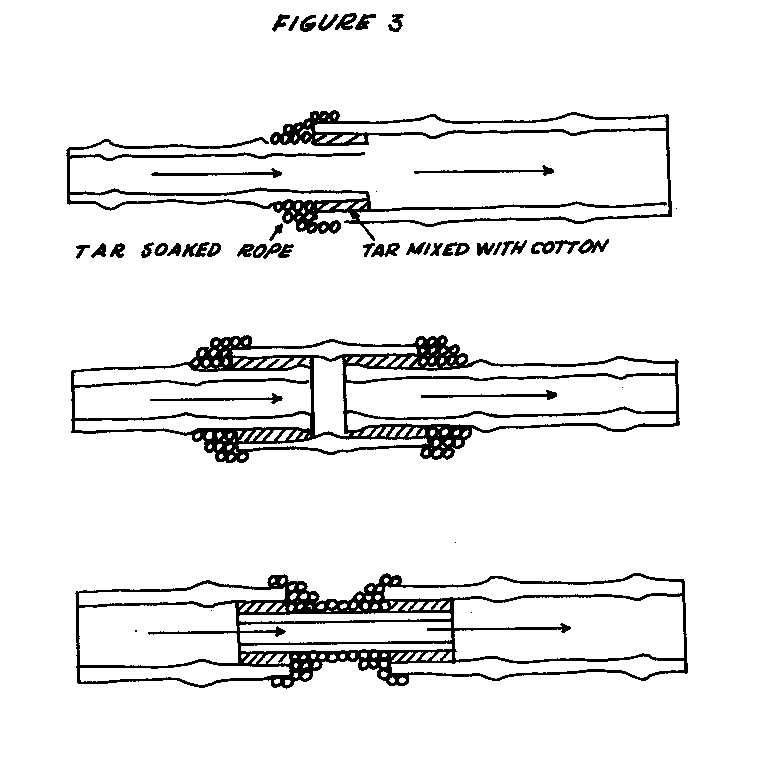
Joints are made watertight by caulking
with cotton wool mixed with tar, then
tightly binding with rope soaked in
hot tar.
Bamboo pipe is
preserved by laying
the pipe below ground level and ensuring
a continuous flow in the pipe.
Where the pipe is laid above ground
level, it is protected by wrapping it
with layers of palm fiber with soil
between the layers.
This treatment
will give a life expectancy of about
3 to 4 years to the pipe; some bamboo
will last up to 5-6 years.
Deterioration
and failure usually occur at the
natural joints, which are the weakest
parts.
Where the depth of
the pipe below
the water source is such that the maximum
pressure will be exceeded, pressure
relief chambers must be installed.
A typical chamber is shown in Figure 4.
uwr4x89.gif (600x600)
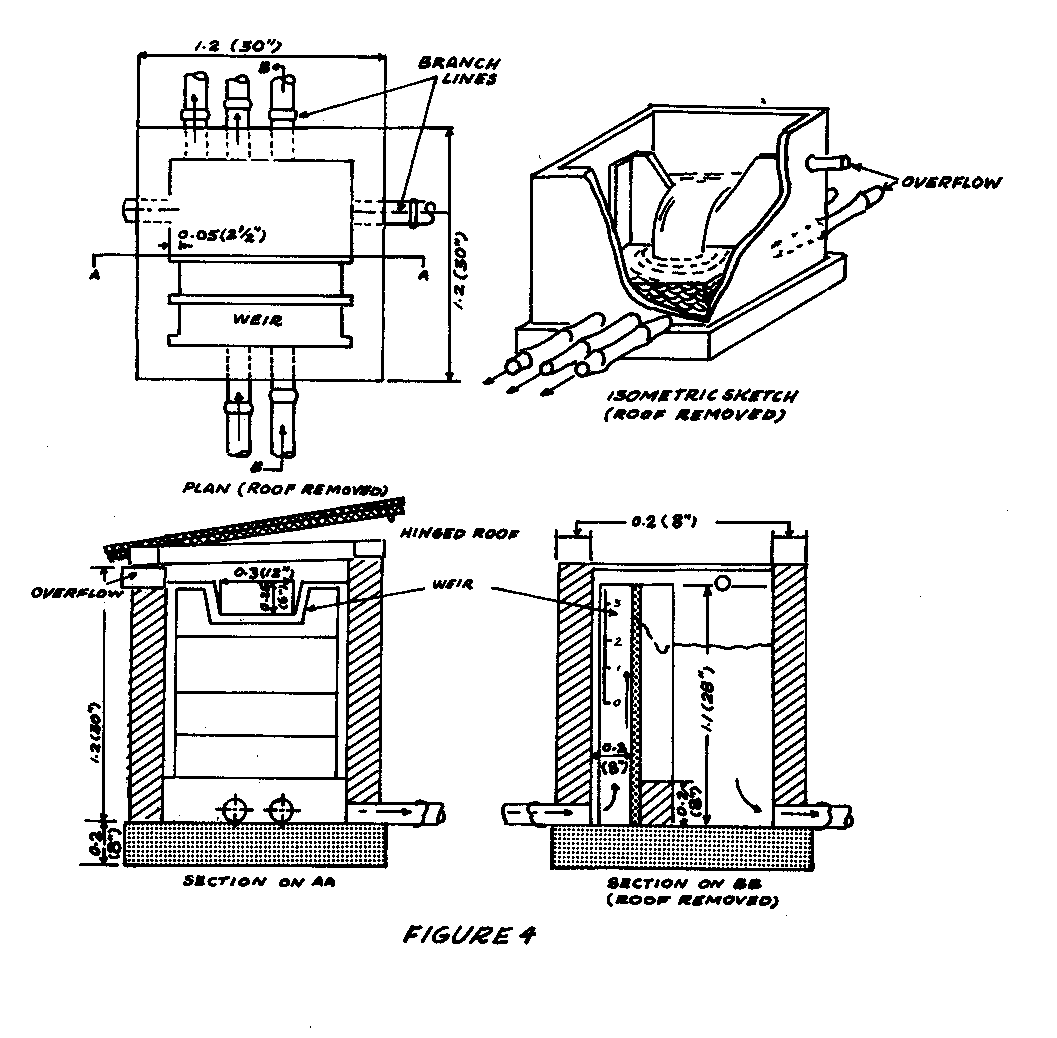
These chambers are also installed
as reservoirs for branch supply lines
to villages en route.
A diagrammatic
sketch of a bamboo
pipe water supply system for a number
of villages is shown in Figure 1.
Size
uwr1x86.gif (600x600)

requirements for bamboo pipe may be
determined by using the pipe-capacity
alignment chart in Figure 5.
A design
uwr5x90.gif (600x600)
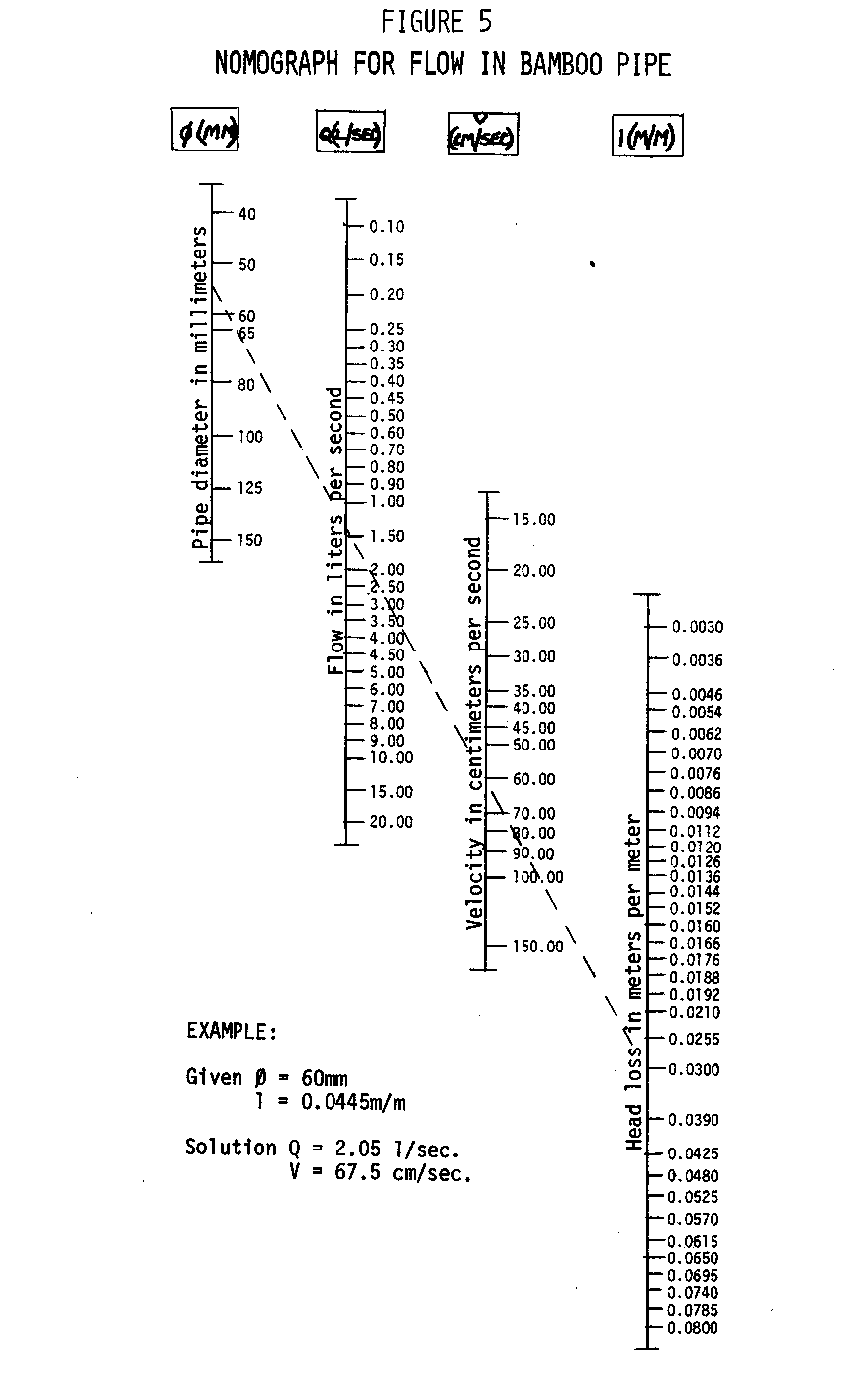
for a public fountain made from bamboo
is shown in Figure 6.
uwr6x91.gif (600x600)
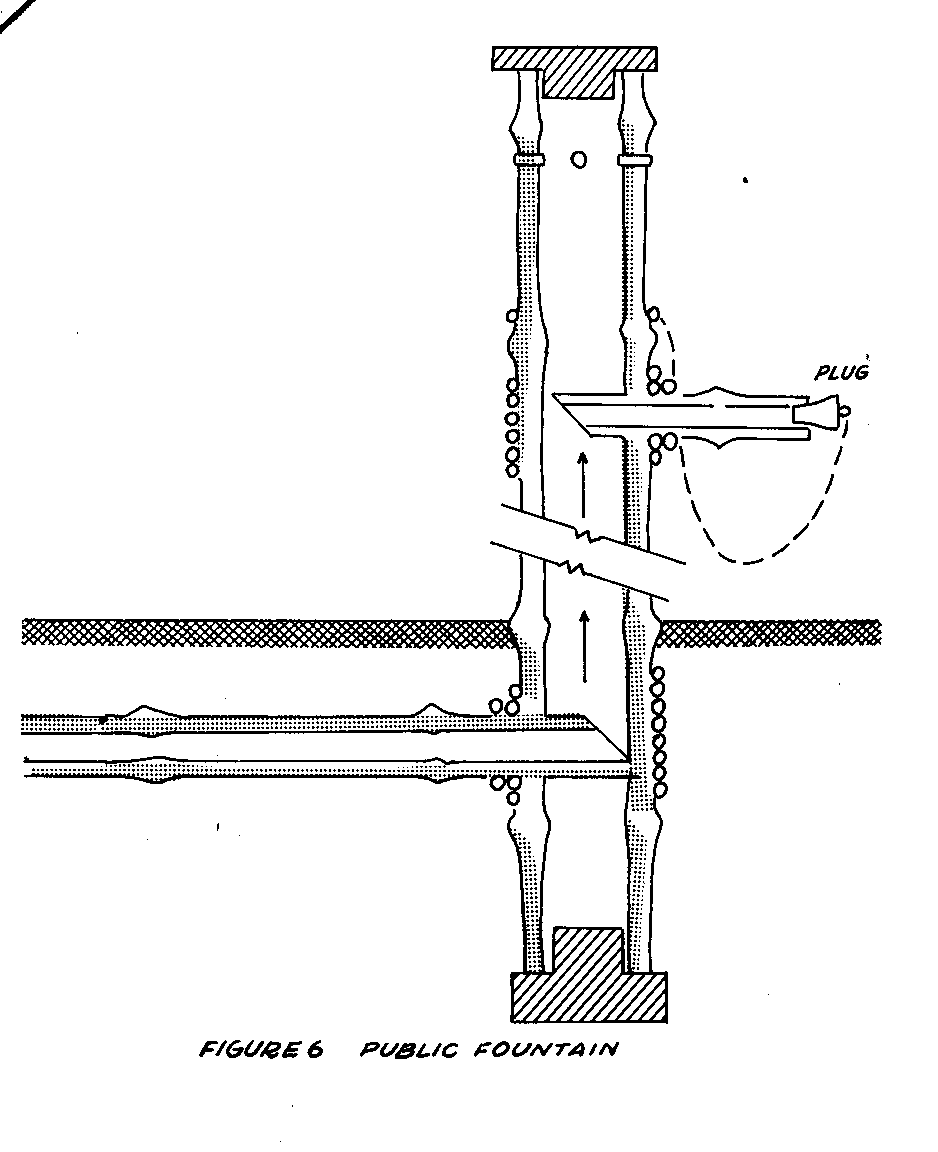
Source:
"Water Supply Using Bamboo Pipe," AID-UNC/IPSED
Series Item No. 3, International
Program in Sanitary Engineering
Design, University of North
Carolina, 1966.
CHAIN PUMP FOR IRRIGATION
The chain pump,
which can be powered
by man or animal, is primarily a shallow-well
pump to lift water for irrigation
(see Figure 1). It
works best
uwr1x92.gif (437x437)
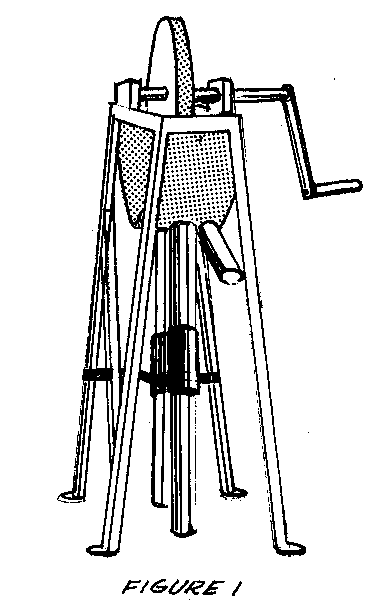
when the lift is less than 6 meters
(20'). The water
source must have a
depth of about 5 chain links.
Both the pump
capacity and the power
requirement for any lift are proportional
to the square of the diameter
of the tube. Figure
2 shows what can
uwr2x93.gif (180x540)

be expected from a 10cm (4") diameter
tube operated by four men working in
two shifts.
The pump is
intended for use as an
irrigation pump because it is difficult
to seal for use as a sanitary pump.
Tools and Materials
Welding or brazing equipment
Metal-cutting equipment
Woodworking tools
Pipe: 10cm (4") outside diameter,
length as
needed
5cm (2")
outside diameter,
length as
needed
Chain with links about 8mm (5/16") in
diameter, length as
needed
Sheet steel, 3mm (1/8") thick
Sheet steel, 6mm (1/4") thick
Steel rod, 8mm (5/16") in diameter
Steel rod, 12.7mm (1/2") in diameter
Leather or rubber for washers
The entire chain
pump is shown in
Figure 3. Details of
this pump can be
uwr3x94.gif (600x600)
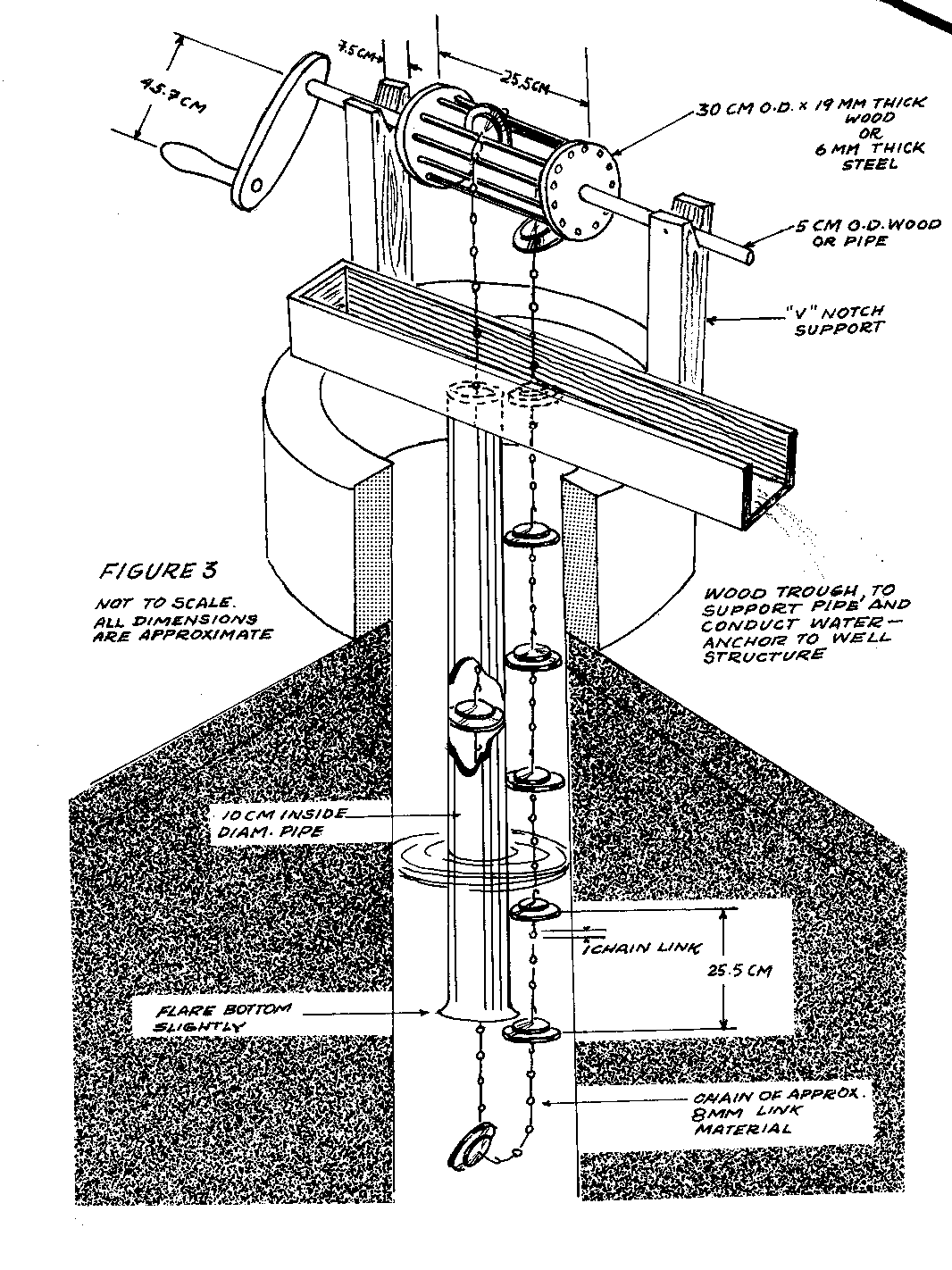
changed to fit materials available and
structure of the well.
The piston links
(see Figures 4, 5, 6 and 7)
uwr4x950.gif (353x353)
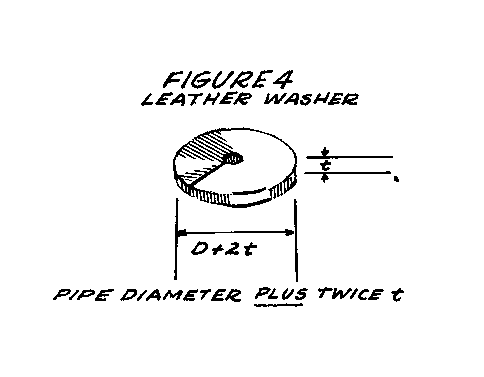
are made from three parts:
1. a leather or rubber washer (see Figure 4)
uwr4x95.gif (353x353)
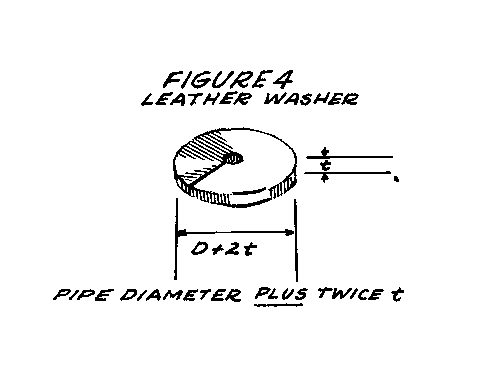
with an outside
diameter
about two
thicknesses of a
washer larger than
the inside diameter
of the pipe.
2. a piston disc (see Figure 5).
uwr5x95.gif (486x486)
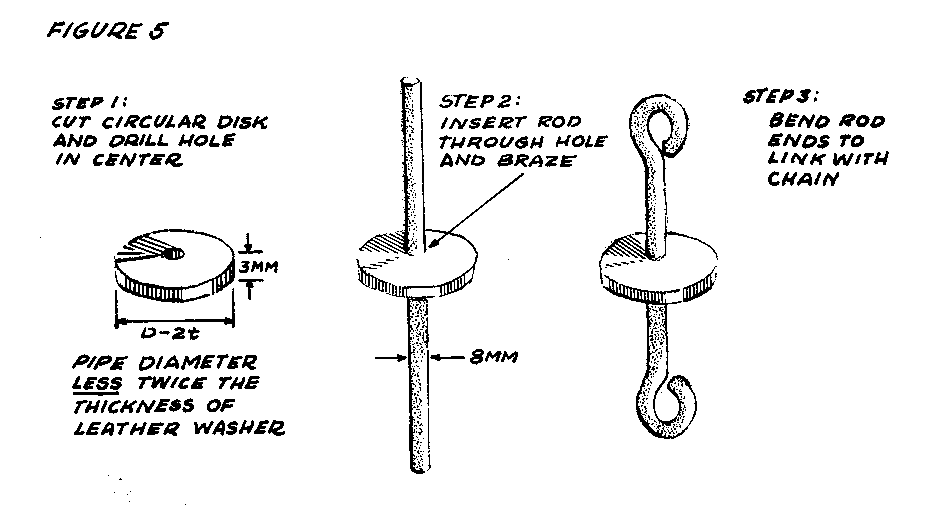
3. a retaining plate (see Figure 6).
uwr6x96.gif (317x317)

The piston link is
made as shown in
Figure 7. Center all
three parts,
uwr7x96.gif (353x353)
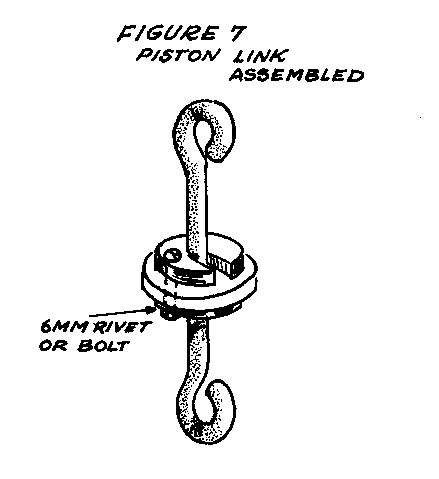
clamp them together temporarily, drill
a hole about 6mm (1/4") in diameter
through all three parts and fasten
them together with a bolt or rivet.
The winch is built
as shown in Figure 3.
uwr3x94.gif (600x600)

Two steel discs 6mm (1/4").
thick are welded to the pipe shaft.
Twelve steel rods, 12.7m (1/2")
thick, are spaced at equal distances,
at or near the outside diameter and
are welded in place.
The rods may be
laid on the outside of the discs, if
desired.
A crank and handle
of wood or metal
is then welded or bolted to the winch
shaft.
The supports for
the winch shaft (see Figure 3)
can be V-notched to hold the
shaft, which will gradually wear its
own groove. A strap
or block can be
added across the top, if necessary, to
hold the shaft in place.
The pipe can be
supported by threading
or welding a flange to its upper
end (see Figure 8).
The flange should
uwr8x96.gif (437x437)
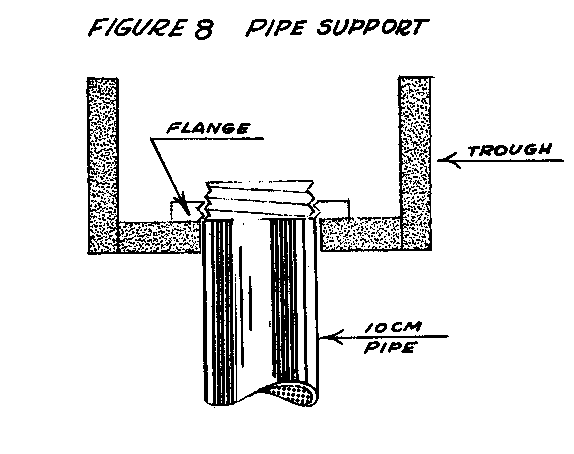
be 8mm to 10mm (5/16" to 3/8") thick.
The pipe passes through a hole in the
bottom of the trough and hangs from
the trough into the well.
Sources:
Robert G. Young, VITA Volunteer, New
Holland, Pennsylvania, Chapter
Water Lifting Devices for Irrigation,
by Aldert Molenaar, Rome: Food and
Agriculture Organization of the United
Nations, 1956.
INERTIA HAND PUMP
uwr1x97.gif (393x393)
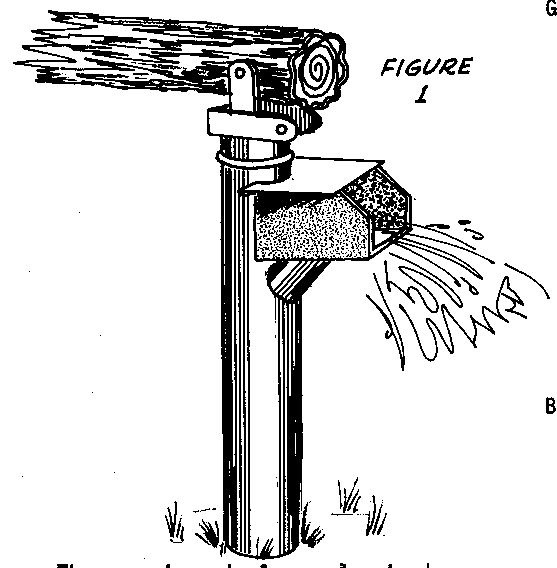
The inertia hand pump described here
is a very efficient pump for lifting
water short distances.
It lifts water
4 meters (13') at the rate of 75 to
114 liters (20 to 30 U.S. gallons) per
minute. It lifts
water 1 meter (3.3')
at the rate of 227 to 284 liters (60
to 75 gallons) per minute.
Delivery
depends on the number of persons pumping
and their strength.
The pump is easily
built by a tinsmith.
Its three moving parts require
almost no maintenance.
The pump has
been built in three different sizes
for different water levels.
The pump is made
from galvanized
sheet metal of the heaviest weight
obtainable which can be easily worked
by a tinsmith (24 to 28-gage sheets
have been used successfully).
The
pipe is formed and made air tight by
soldering all joints and seams.
The
valve is made from the metal of discarded
barrels and a piece of truck
inner tube rubber.
The bracket for
attaching the handle is also made from
barrel metal.
Tools
Soldering equipment
Drill and bits or punch
Hammer
Saws
Tinsnips
Anvil (railroad rail or iron pipe)
Materials for 1-meter (3.3') pump:
Galvanized iron (24 to 28 gage):
Shield: 61cm x
32cm, 1 piece
(2' x 12
5/8")
Shield cover: 21cm
x 22cm, 1 piece
(8 1/4" x 8
5/8")
Pipe: 140cm x 49cm,
1 piece
(55 1/8" x
19 1/4")
Top of pipe: 15cm x
15cm, 1 piece
(6" x
6")
"y" pipe:
49cm x 30cm, 1 piece
(19 1/4" x
12")
Barrel metal:
Bracket: 15cm x
45cm, 1 piece
(6" x 21
1/4")
Valve-bottom: 12cm
(4 3/4") in
diameter, 1 piece
Valve-top: 18cm (7
1/8") in diameter,
1 piece
Wire:
Hinge: 4mm
(5/32") in diameter,
32cm (12
5/8") long
This pump can also
be made from plastic
pipe or bamboo.
There are two
points to be remembered
concerning this pump.
One is that the
distance from the top of the pipe to
the top of the hole where the short
section of pipe is connected must be
20cm (8"). See
Figure 2. The air
uwr2x980.gif (486x486)
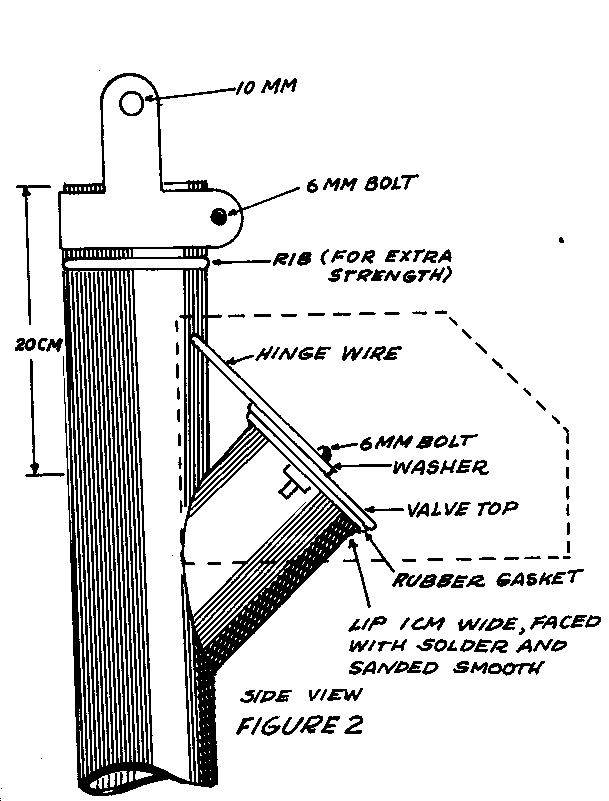
which stays in the pipe above this
junction serves as an air cushion (to
prevent "hammering" and regulates the
number of strokes pumped per minute.
The second point is to remember to
operate the pump with short strokes,
15 to 20cm (6" to 8") and at a rate of
about 80 strokes per minute.
There is
a definite speed at which the pump
works best and the operator will soon
get the "feel" of his particular pump.
In building the two
larger size pumps
it is sometimes necessary to strengthen
the pipe to keep it from collapsing if
it hits the side of the well.
It can
be strengthened by forming "ribs" about
every 30cm (12") below the valve or
banding with bands made from barrel
metal and attached with 6m (1/4")
bolts.
The handle is
attached to the pump
uwr4x99.gif (600x600)

and post with a bolt 10mm (3/8") in
diameter, or a large nail or rod of
similar size.
Figure 5 gives the
dimensions of
uwr5x100.gif (600x600)
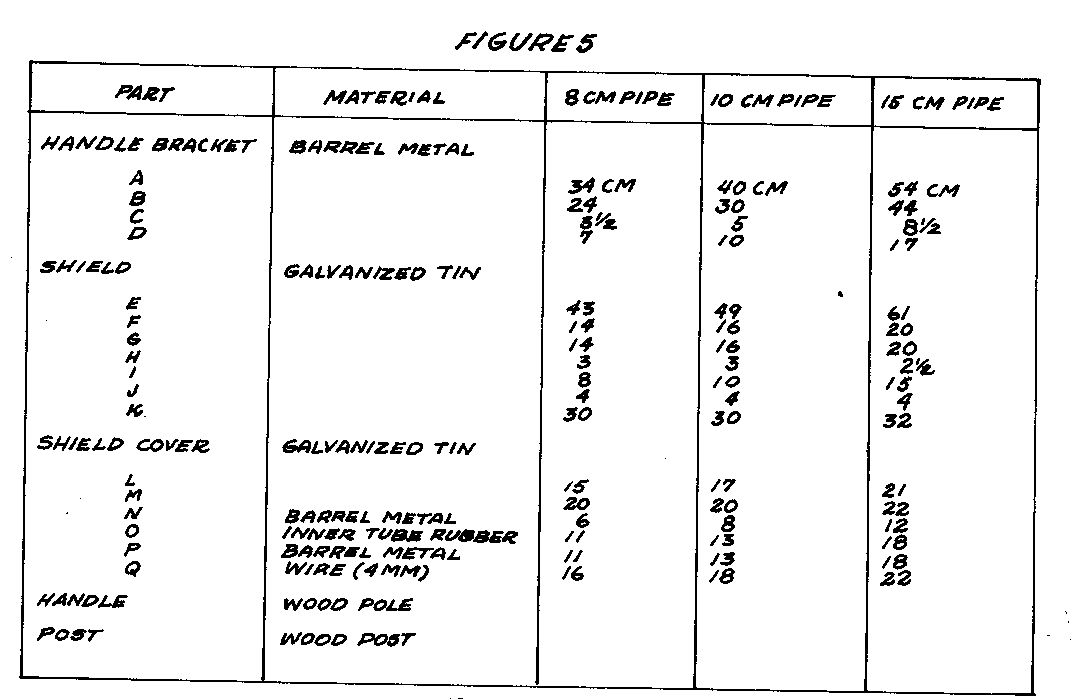
parts for pumps of three different
sizes. Figure 6 shows the pumping
uwr6x100.gif (200x600)

capacity for each size.
Source:
Dale Fritz, VITA Volunteer,
Washington, D.C.
HANDLE MECHANISM FOR HAND PUMPS
The wearing parts
of this durable
hand-pump handle mechanism are wooden
(see Figure 1). They
can be easily
uwr1x101.gif (486x486)
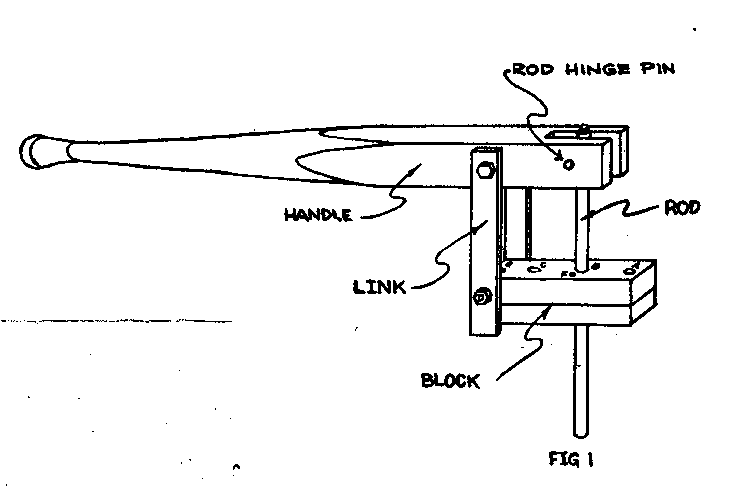
replaced by a village carpenter.
This handle has been designed to replace
pump handle mechanisms which are
difficult to maintain.
Some have been
in use for several years in India with
only simple, infrequent repairs.
Tools and Materials
Saw
Drill
Bits
Tap: 12.5mm (1/2")
Tap: 10mm (3/8")
Chisel
Drawknife, spokeshave or lathe
Hardwood: 86.4cm x 6.4cm x 6.4cm
(34" x 2
1/2" x 2 1/2")
Mild steel rod: 19mm (3/4") in diameter
and 46.5mm (16") long
Strap iron, 2 pieces: 26.7cm x 38mm
x 6mm (10.1/2"
x 1 1/2" x 1/4")
The mechanism shown
in Figure 1 is
bolted to the top flange of your pump.
The mounting holes A and C in the block
should be spaced to fit your pump (see Figure 6).
uwr6x103.gif (540x540)
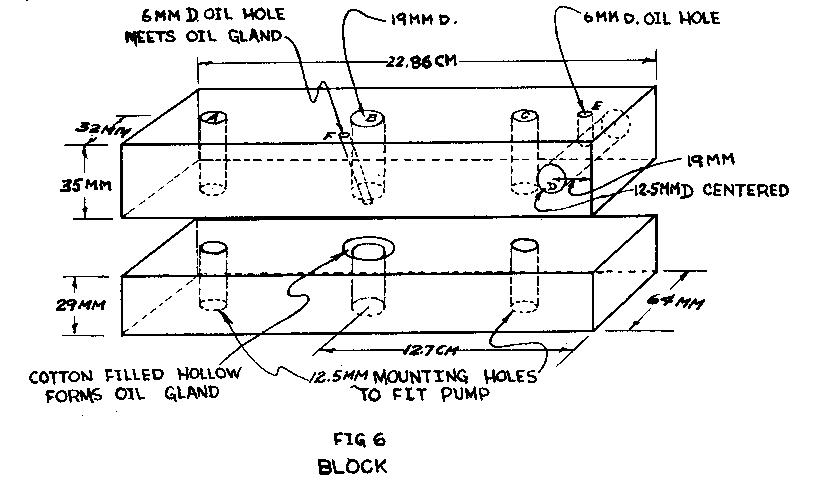
Figure 2 shows a pump with
uwr2x102.gif (486x486)
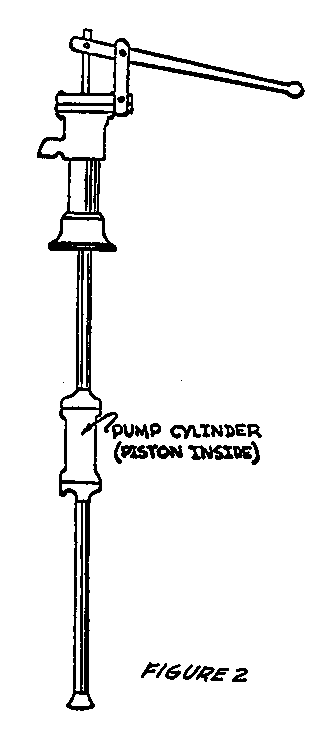
this handle mechanism which is being
manufactured by F. Humain and Bros.,
28 Strand Road, Calcutta, India.
BOLT HARDWARE
Number of
Number of
Number of
Dia. Length
Number of
lock- plain
Purpose -
bolts reqd.
mm mm
nuts reqd.
washers washers
fastens:
1
10
38 0
0
0 76mm
bolt to
rod
1
10
76 0
0
2 Rod to
Handle
2
12.5
89 2
4
4 Link to
Handle
Link to Block
2
12.5
? 2
2
2 Block to
your
pump
1
12.5
? 1
1
0 Rod to
piston
Handle.
Make the handle of tough
hardwood, shaped on a lathe or by hand
shaving. The slot
should be cut wide
enough to accommodate the rod with two
plain washers on either side.
See Figure 3.
uwr3x102.gif (256x486)

Rod.
The rod is made of mild steel
as s own in Figure 4.
A 10mm (3/8")
uwr4x103.gif (437x437)
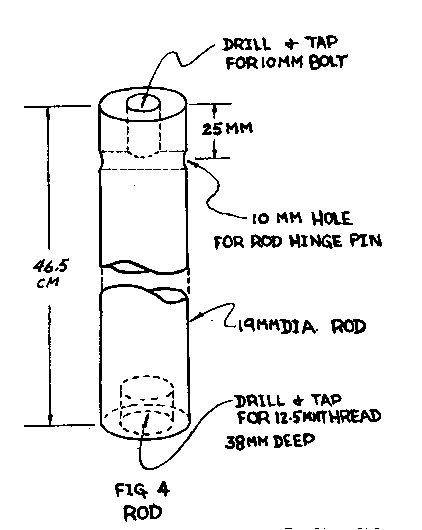
diameter machine bolt 38mm (1 1/2")
long screws into the end of the rod
to lock the rod hinge pin in place.
The rod hinge pin is a 10mm (3/8")
diameter machine bolt which connects
the rod to the handle (see Figure 1).
The end of the rod can be bolted directly
to the pump piston with a
12.5mm bolt. If the
pump cylinder
is too far down for this, a threaded
12.5m (1/2") rod should be used instead.
Links.
The links are two pieces of
flat-steel strap iron.
Clamp them together
for drilling to make the hole
spacing equal. See
Figure 5.
uwr5x103.gif (437x437)
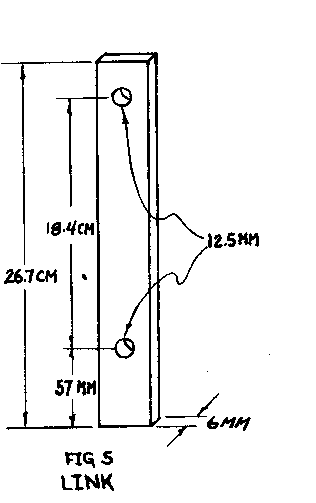
Block.
The block forms the base of
the lever mechanism, serves as a lubricated
guide hole for the rod, and provides
a means for fastening the mechanism
to the pump barrel.
If the block
is accurately made of seasoned tough
hardwood without knots, the mechanism
will function well for many years.
Carefully square the block to 22.9cm x
6.4cm x 6.4cm (9" x 2 1/2" x 2 1/2").
Next holes A, B, C, and D are drilled
perpendicular to the block as shown in
Figure 6. The
spacing of the mounting
uwr6x103.gif (534x534)

holes A and C from hole B is determined
by the spacing of the bolt holes
in the barrel flange of your pump.
Next saw the block in half in a plane
3.5cm (1 3/8") down from the top side.
Enlarge hole B at the top of the lower
section with a chisel to form an oil
well around the rod.
This well is
filled with cotton.
A 6mm (1/4") hole,
F, is drilled at an angle from the oil
well to the surface of the block.
A
second oil duct hole E is drilled in
the upper-section of the block to meet
hole D. Use
lockwashers under the head
and nut of the link bolts to lock the
bolts and links together.
Use plain
washers between the links and the wooden
parts.
Source:
A Pump Designed for Village Use, by
Dr. Edwin Abbott, American Friends
Service Committee, Philadelphia,
Pennsylvania, 1955.
USING A HYDRAULIC RAM
A hydraulic ram is
a self-powered
pump which uses the energy of falling
water to lift some of this water to a
level above the original source.
This
entry explains the use of commercial
hydraulic rams, which are available
in some countries.
Tools and Materials
Commercial hydraulic ram
Steel pipe and fittings
Pipe wrenches
Materials to make a small dam or reservoir
Use of the Hydraulic Ram
A hydraulic ram can
be used wherever
a spring or stream of water flows with
at least a 91.5cm (3') fall in altitude.
The source must be a flow of at least
11.4 liters (3 gallons) a minute.
Water can be lifted about 7.6 meters
(25') for each 30.5cm (12") of fall in
altitude. It can be
lifted as high as
152 meters (500'), but a more common
lift is 45 meters (150').
The pumping cycle
(see Figure 1) is:
uwr1x104.gif (600x600)
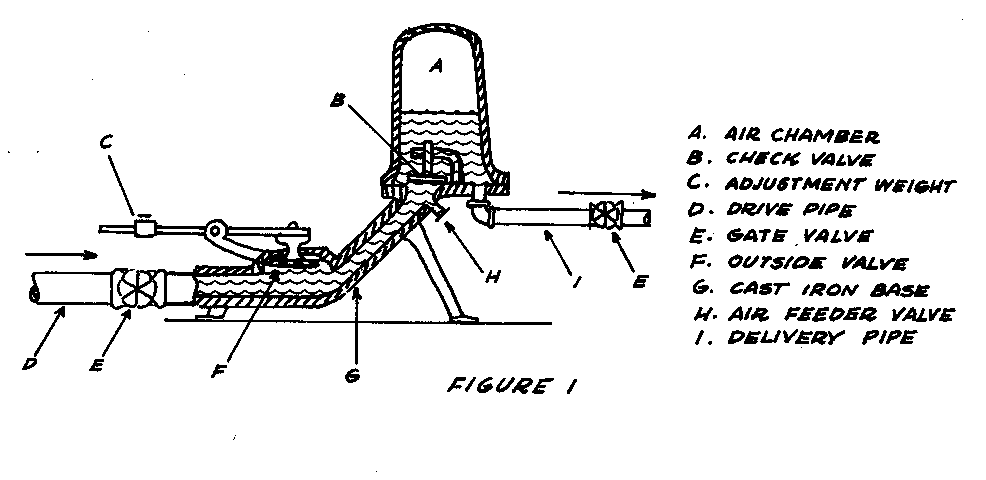
1. Water flows through the drive pipe
(D) and out the
outside valve (F).
2. The drag of the moving water
closes the valve
(F).
3. The momentum of water in the drive
pipe (D) drives
some water into
the air chamber
(A) and out the
delivery pipe (I).
4. The flow stops.
5. The check valve (B) closes.
6. The outside valve (F) opens to
start the next
cycle.
This cycle is
repeated 25 to 100
times a minute; the
frequency is
regulated by moving
the adjustment
weight (C).
The length of the
drive pipe must be
between five and ten times the length
of the fall (see Figure 2).
If the
uwr2x105.gif (600x600)
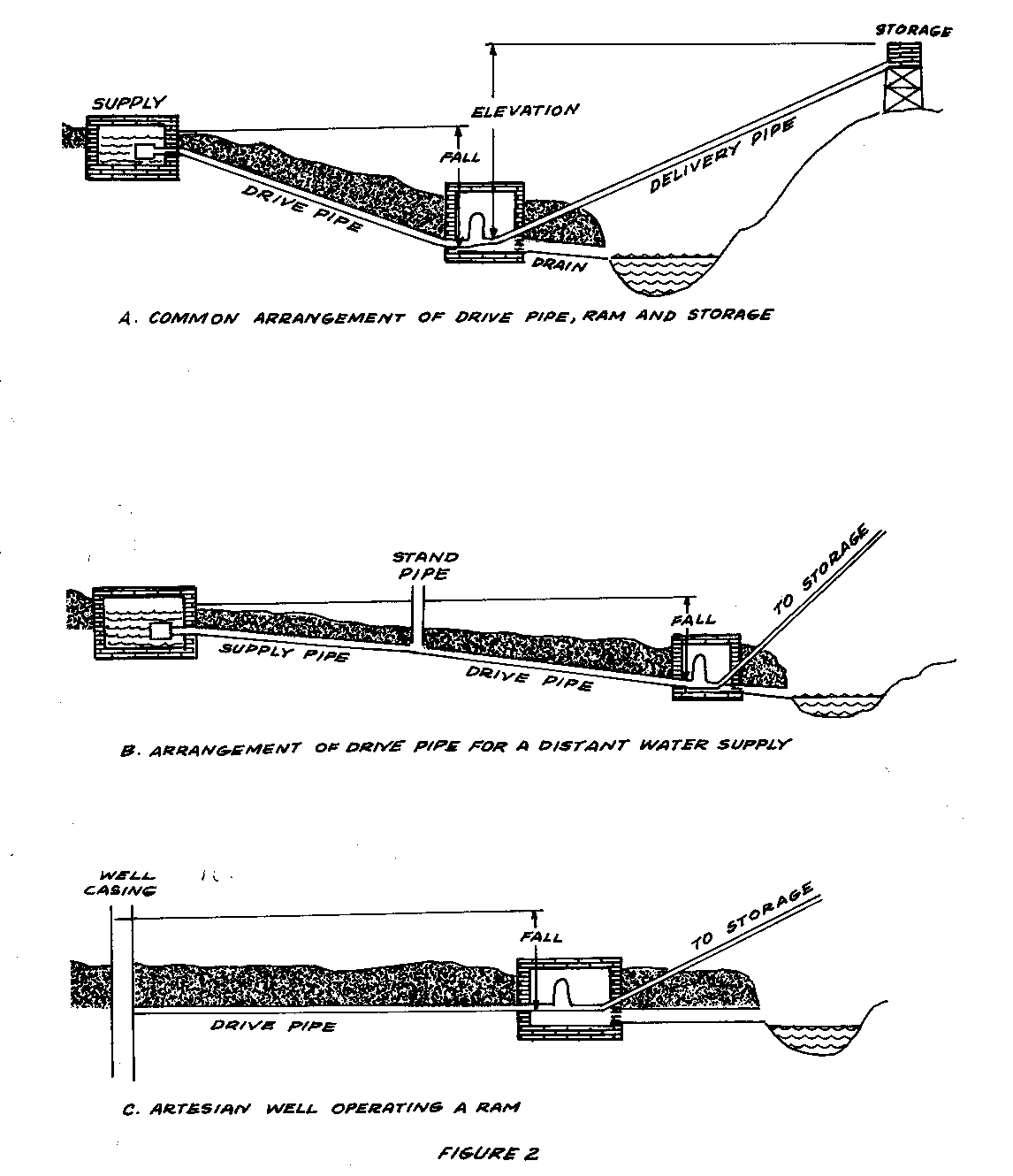
distance from the source to the ram is
greater than ten times the length of
the fall, the length of the drive
pipe can be adjusted by installing a
stand pipe between the source and the
ram (see B in Figure 2).
uwrbx105.gif (540x540)
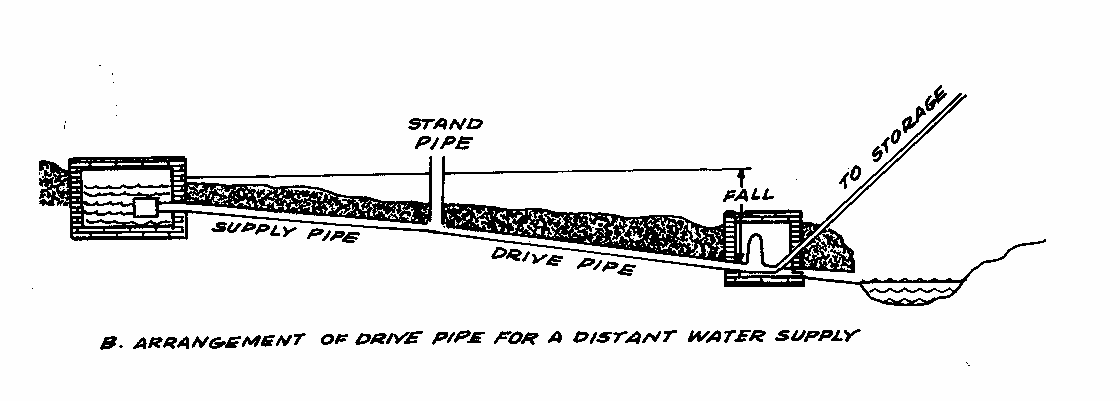
Once the ram is
installed there is
little need for maintenance and no
need for skilled labor.
The cost of
a small ram which will raise water
about 45 meters (150') is about U.S.
$150, not including the cost of the
pipe and installation.
Although the
cost may seem high, it must be remembered
that there is no further power
cost and a ram will last for 30 years
or more. A ram used
in freezing climates
must be insulated.
A double-acting ram
will use an impure
water supply to pump two-thirds
of the pure water from a spring or
similar source. A
third of the pure
water mixes with the impure water.
A
supplier should be consulted for this
special application.
To calculate the
approximate pumping
rate, use the following equation:
Capacity (gallons per hour) = Vx F x 40
_________
E
V = gallons per minute from source
F = fall in feet
E = height the water is to be raised
in feet
Data Needed for Ordering a Hydraulic
Ram
1. Quantity of water available at the
source of supply
in liters (or
gallons) per
minute ______________
2. Vertical fall in meters (or feet)
from supply to
ram ______________
3. Height to which the water must be
raised above the
ram _____________
4. Quantity of water required per day
______________
5. Distance from the source of supply
to the ram
______________
6. Distance from the ram to the storage
tank
______________
Sources:
Loren G. Sadler, New Holland, Pennsylvania,
VITA Chapter
Rife Hydraulic Engine Manufacturing
Company, Box 367, Millburn, New Jersey,
U.S.A.
The Hydraulic Ram, by W. H. Sheldon,
Extension Bulletin 171, July 1943,
Michigan State College of Agriculture
and Applied Science.
"Country Workshop," Australian Country,
September 1961, pages 32-33.
"Hydraulic Ram Forces Water to Pump
Itself," Popular Science, October 1948,
pages 231-233.
"Hydraulic Ram," The Home Craftsman,
March-April 1963, pages 20-22.
Water Storage and Water Power
SPRING DEVELOPMENT
Springs,
particularly in sandy soil,
often make an excellent water source,
but they should be dug deeper, sealed,
protected by a fence and piped to the
home. If fissured
rock or limestone
are present, get expert advice.
Tools and Materials
Hand tools for digging
Reinforced concrete
Screens
Pipes
Proper development
of a spring will
increase the flow of ground water and
lower the chances of contamination
from surface water.
Springs are usually
either:
1. Gravity Seepage,
where the water-bearing
soil reaches the
surface
over an
impermeable layer, or
2. Pressure or
artesian, where the
water, under
pressure and trapped
by a hard layer
of soil, finds an
opening and rises
to the surface.
(In some parts of
the world, all
springs are called
artesian.)
Dig a small hole
near the spring to
learn the depth to the hard layer of
soil and to find out whether the spring
is gravity-seepage or pressure.
Check
uphill and nearby for sources of contamination.
Test the water to see if
it must be purified before being used
for drinking. A
final point: Find
out if the spring runs during long dry
spells.
Usually the soil is
dug to the hard,
underlying part and a tank is made
with watertight concrete walls on all
but the uphill side (see Figures 1 and 2).
uwr11100.gif (600x600)
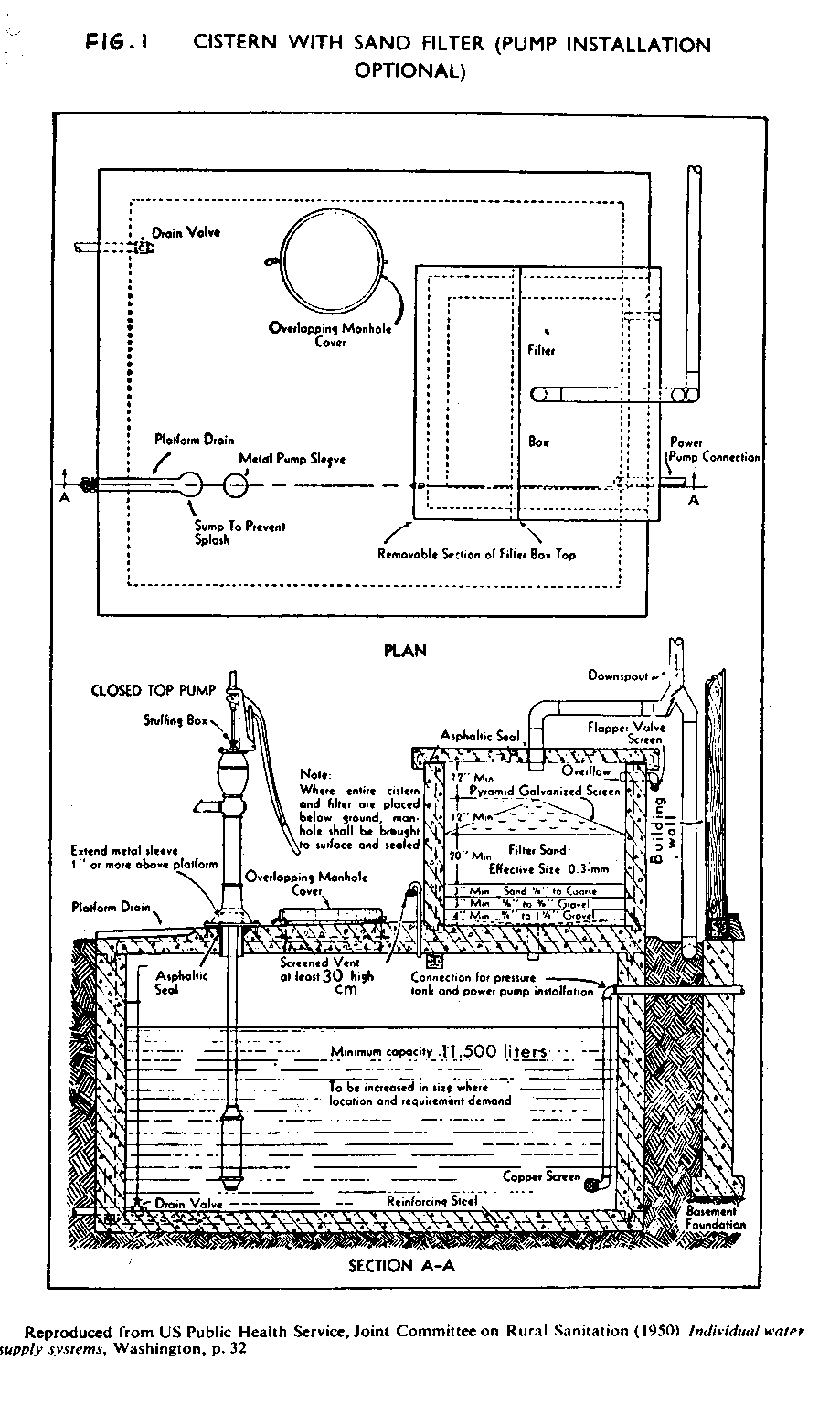
should be lined with porous concrete
or stone without mortar, so that it
will admit the gravity seepage water.
It can be backfilled with gravel and
sand, which helps to keep fine materials
in the water-bearing soil from
entering the spring.
If the hard soil
cannot be reached easily, a concrete
cistern is built which can be fed by
a perforated pipe which is placed in
the water-bearing layer of earth.
With a pressure spring, all sides of
the tank are made of watertight reinforced
concrete, but the bottom is
left open. The water
enters through
the bottom.
Read the section in
this handbook
on cisterns before developing your
spring.
No matter how the
water enters your
tank, you must make sure the water is
pure by:
building a
complete cover to stop
surface pollution
and keep out
sunlight, which
causes algae to
grow.
installing a
locked manhole with
at least a 5cm
(2") overlap to
prevent entrance
of polluted ground
water.
installing a
screened overflow
which discharges
at least 15cm
(6") above
the ground. The water
must land on a
cement pad or rock
surface to stop
the water from
making a hole in
the ground and to
insure proper
drainage away from
the spring.
arranging the
spring so that surface
water must filter
through at
least 3 meters
(10') of soil before
reaching the
ground water.
Do this by making
a diversion
ditch for surface
water about
15 meters (50')
or more from the
spring.
Also, if necessary, cover
the surface of
the ground near
the spring with a
heavy layer of
soil or clay to
increase the distances
that rainwater
must travel,
thus insuring
that it has to filter
through 3 meters
(10') of soil.
* making a fence to
keep people and
animals away from
the spring's
immediate
surroundings. The suggested
radius is 7.6
meters (25').
* installing a
pipeline from the
overflow to the
place where the
water is to be
used.
Before using the
spring, disinfect
it thoroughly by adding chlorine or
chlorine compounds.
Shut off the overflow
to hold the chlorine solution in
the well for 24 hours.
If the spring
overflows even though the water is
shut off, arrange to add chlorine so
that it remains strong for at least
30 minutes, although 12 hours would
be much safer. After
the chlorine is
flushed from the system have the water
tested. (See section
on "Chlorination
and Superchlorination.")
Source:
Manual of Individual Water Supply
Systems, U.S. Department of Health,
Education and Welfare, Public Health
Service Publication No. 24.
Water Supply for Rural Areas and Small
Communities, E. G. Wagner and J. N.
Lanoix, Water Health Organization,
Geneva, 1959.
Acknowledgements
John M. Jenkins, III, VITA Volunteer,
Marrero, Louisiana
Ramesh Patel, VITA Volunteer, Albany,
New York
William P. White, VITA Volunteer,
Brooklyn, Connecticut
CISTERNS
Cisterns for family
use are most practical
in areas of adequate rainfall
and where ground water is difficult to
obtain or where it contains too many
minerals. A sealed
well usually requires
no filtration, no chemical disinfection
and little upkeep, while a
cistern needs all of these.
Cisterns
cost more to build than wells.
Cistern
water has few minerals, however, and is
ideal for washing clothes.
A cistern water
supply has four
basic parts: tank, catchment area,
filter and a pump.
(Pumps are discussed
in the section on "Water Lifting.")
Cistern Tank
The tank described
here can be used
for sanitary storage of rainwater for
family use.
Tools and Materials
Tools and materials for reinforced concrete
Asphalt sealing compound
Screening
Pipe
The cistern tank
must be watertight
to prevent surface contamination from
polluting the supply.
Reinforced concrete
is the best material because it
is strong, it has a long life and it
can be made watertight.
A manhole and drain
must be provided
so the tank can be cleaned.
(See Figure 1.)
uwr1x110.gif (600x600)

A vent and a place through
which chlorine can be added easily for
disinfection are also necessary.
The size of the
cistern depends on
the family's daily needs and the
length of time between rainy periods.
If a family needs 94.6 liters (25 U.S.
gallons) of water a day and there are
125 days between rainy periods, then
the cistern must hold:
94.6 liters x 125
days = 11,835
liters
or
25 U.S. gallons x
125 days = 3,125
U.S. gallons
A cistern with an
inside size of 2
meters x 2 meters x 2 meters (7 1/2'
x 7 1/2' x 7 1/2') holds 11,355
liters (3,000 U.S. gallons).
To be sure that the
cistern is watertight,
use about 28 liters of water per
50kg sack of cement (5 1/2 U.S. gallons
per 94 pound or one cubic foot sack
when mixing the concrete.
(See section
on "Concrete Construction.")
Tamp the
concrete thoroughly and keep the surface
damp for at least 10 days.
If
possible, pour the walls and floor at
the same time. The
manhole entrance
must be 10cm (4") above the cistern
surface and the cover should overlap
by 5cm (2").
Slope the bottom of the
cistern, making one part lower than
the rest, so that water can be more
easily siphoned or bailed out when the
cistern is being cleaned.
You can do
this by scraping the bottom to the
proper contour. Do
not use fill dirt
under the cistern because this may
cause the cistern to settle unevenly
and crack. A
screened drain pipe and
valve will make cleaning easier.
An overflow pipe is
not needed if a
roof-cleaning butterfly valve is properly
used. If the overflow is installed,
be sure to cover the outlet
carefully with copper window screen.
A screened vent is necessary if there
is no overflow, to allow displaced
air to leave the cistern.
The hand
pump must be securely mounted to bolts
cast into the concrete cistern cover.
The flanged base of the pump should be
solid, with no holes for contamination
to enter, and sealed to the pump cover,
or the drop pipe must be sealed in
with concrete and asphalt sealing compound.
A small pipe with a
screwed-on cap
is needed through which to measure the
water in the cistern and to add chlorine
solution after each rainfall.
The
amount of water in the cistern is measured
with a stick marked in thousands
of liters (or thousands of gallons).
To disinfect after each rainfall, add
a 5 parts per million dosage of chlorine
(see section on "Chlorination").
A newly built or
repaired cistern
should always be disinfected with a
50 parts per million chlorine solution.
The cistern walls and the filter
should be thoroughly washed with
this strong solution and then rinsed.
A small-pressure system can be disinfected
readily by pumping this strong
solution throughout the system and
letting it stand overnight.
Catchment Area
A catchment area of
the proper size
is a necessary part of a cistern water
supply. Rainwater
for a cistern can
be collected from the roof of a house.
The method given here for estimating
catchment size should be checked
against the actual size of nearby catchment
installations.
Tools and Materials
Galvanized iron roof or equivalent
Trough collectors
Downspout
The catchment or
collecting area
should be a smooth, watertight material,
like a galvanized sheet-metal
roof. Wood or thatch
roofs may taint
the water and retain dust, dirt and
leaves; water from these roofs contains
more organic matter and bacteria
than water from smooth surfaces.
Stone, concrete and plastic film
catchments are sometimes built on the
ground. For family
use, roofs are
usually best because humans and
animals cannot contaminate them.
To estimate your
required catchment
area, estimate the minimum yearly rainfall
and the amount of water required
by the family during one year.
Sometimes,
the government meteorological
section can give you the minimum rainfall
expected. If they
cannot, estimate
the minimum rainfall at two-thirds
of the yearly average.
Take the average
amount of water needed by the family
for one day and multiply it by
365 to learn how much is needed for
one year. Then use
the chart to find
how much roofspace is needed (Figure 2).
uwr2x112.gif (600x600)
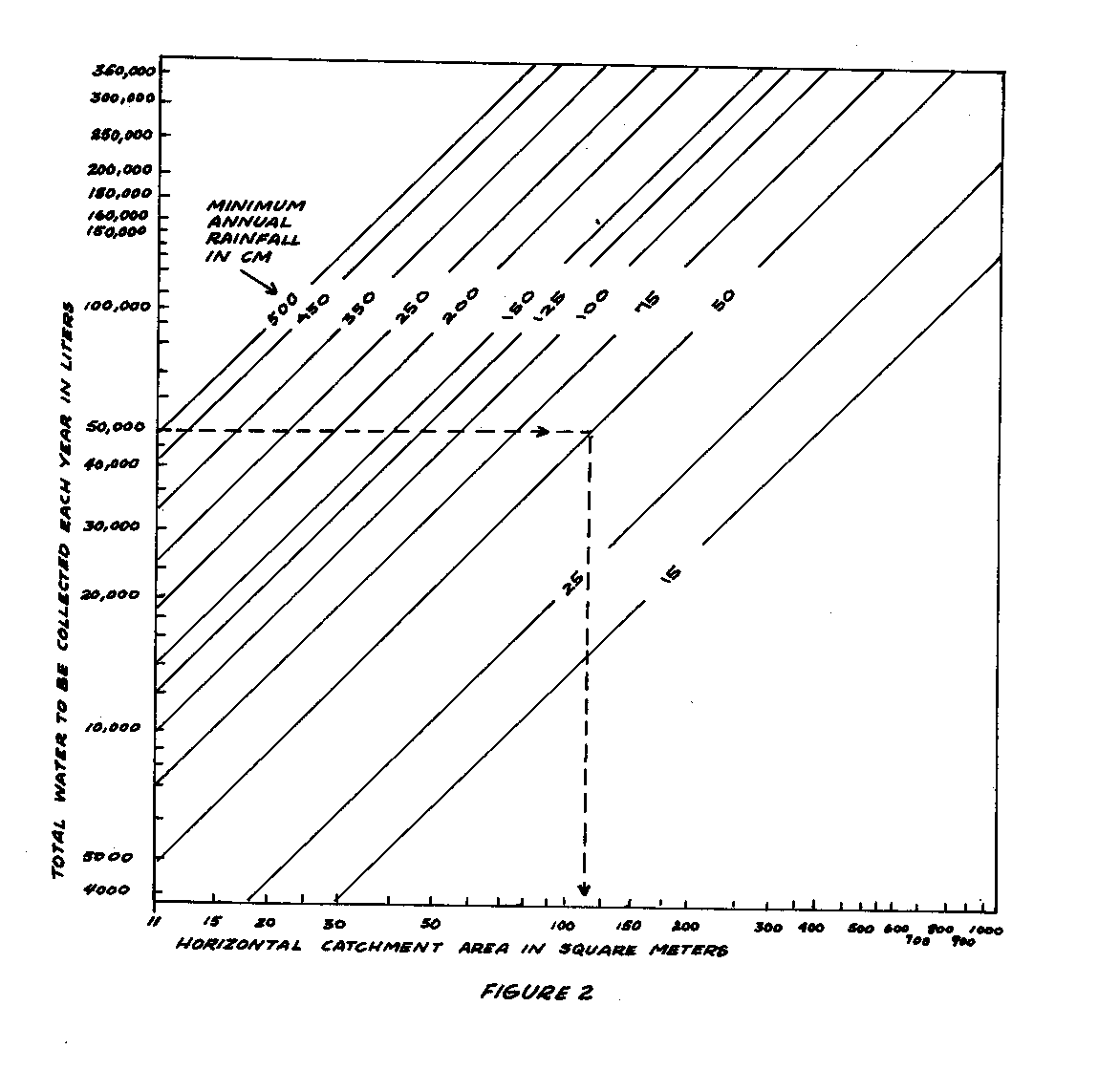
Add 10 percent to the area given
by the chart to allow for water lost
by evaporation and by discarding
water at the beginning of each rain fall.
Example:
Suppose you have an
average rainfall
of 75cm a year and a family needs 135
liters a day, then:
2/3 x 75 = minimum
annual rainfall
of 50cm
365 x 135
liters/day = 49,275 liters
a year.
Round this figure
off to 50,000 liters
a year. The example
worked out on the
chart shows that a catchment area of
about 115 square meters is needed.
Add
10 percent to this area to allow for
water loss, giving a total required
catchment area of about 126.5 square
meters.
A collecting trough
and downspout are
needed. Be sure
there is a good
pitch to the trough so that the water
flows freely and does not hold small
puddles that can breed yellow-fever
mosquitos and other insects.
Troughs
and downspouts need periodic inspection
and cleaning. If you
extend the trough,
it increases the catchment area.
Cistern Filter
The sand filter
described here will
remove most organic matter from water
but it will not produce safe drinking
water by removing all harmful bacteria.
Water collected in the cistern tank
should be chlorinated after each rainfall.
Tools and Materials
Tools and materials for making reinforced
concrete
Screen
Fine, clean sand
Graded gravel
Asphalt sealing compound
A catchment area
always collects
leaves, bird droppings, road dust and
insects. A cistern
filter removes as
much of this material as possible before
the water enters the cistern.
The sand filter is
usually built at
ground level and the filtered water
runs into the cistern, which is mostly
underground. The
largest pieces, such
as leaves, are caught in the splash
plate. The splash
plate also distributes
the water over the surface of
the filter, so that the water does not
make holes in the sand.
A piece of
window screen forms the splash plate.
If a filter is made
too small to
handle the normal rush of water from
rainstorms, the water will overflow
the filter or dig a channel in the
sand, ruining the filter.
The filter
area should not be less than one-tenth
of the catchment area.
A typical
filter would be 122cm x 122cm (4' x
4') for a family-sized unit where
rainfall intensity is average.
About every 6
months, remove the
manhole cover and clean the filter.
Remove all matter from the splash
plate and scrape off and remove the
top 1.25cm (1/2") of sand.
When the
sand is down to 30cm (12") in depth,
rebuild it with clean sand to the
original depth of 46cm (18").
The first runoff
from the roof,
which usually contains a great deal
of leaves and dirt, should be discarded.
The simplest way to do this
is to have a butterfly valve (like a
damper in a stovepipe) in the downspout
(see Figure 3). After
the rain
uwr3x113.gif (486x486)
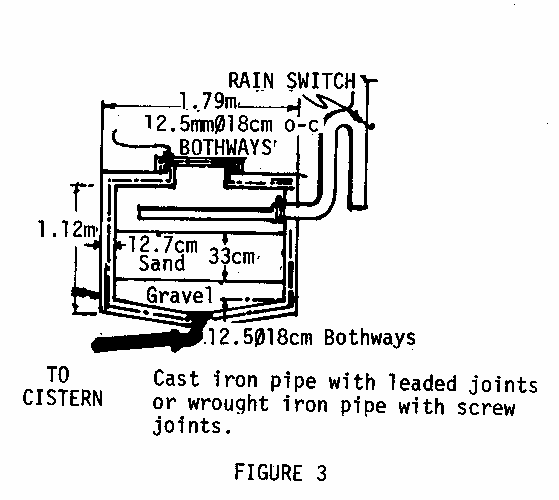
has washed the roof, the valve is
turned to let the runoff water enter
the filter. A
semi-automatic filter
is shown in Figure 4.
uwr4x113.gif (600x600)
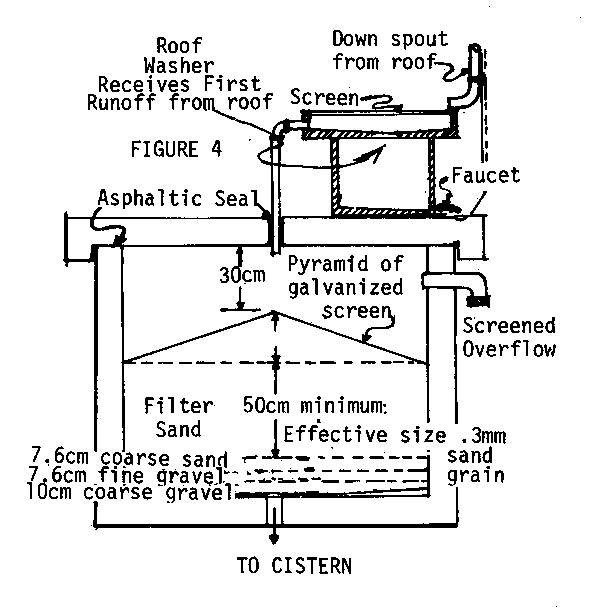
In building the
filter, it is important
to use properly-sized sand
and gravel and to make sure the filter
can be cleaned easily.
The filter
must have a screened overflow.
Sources:
Cisterns, State of Illinois, Department
of Public Health, Circular No. 833.
Manual of Individual Water Supply
Systems, U.S. Department of Health,
Education and Welfare, Public Health
Service Publication No. 24.
Water Supply for Rural Areas and Small
Communities, by Edmund G. Wagner and
J. N. Lanoix, World Health Organization,
Geneva, 1959.
SELECTING A DAM SITE
A water reservoir
can be formed by
building a dam across a ravine.
The
preliminary evaluation described here
will help to determine whether or not
a particular site will be good for
building a dam. If
the information
collected in this investigation shows
that the site has good possibilities,
consult an expert before starting to
build.
Materials
Maps
Rainfall data
Building a dam
takes time, labor,
materials and money.
Furthermore, if
a dam which holds more than a few acre-feet
of water breaks, a great deal of
damage could be caused.
Therefore it
is important to choose a dam site carefully,
to guard against dam collapse,
and to avoid excessive silting, porous
soil, polluted water and lack of water
because of a small catchment area.
One acre-foot of
water equals 1 foot
of water covering an acre of land (30cm
of water covering 0.4 hectares).
One
acre-foot equals 1233.49 cubic meters.
Six factors are
important in site
selection:
1. Enough water to
fill the reservoir.
2. Maximum water
storage with the
smallest dam.
3. A sound,
leakproof foundation for
the reservoir.
4. Reasonable
freedom from pollution.
5. A storage site
close to users.
6. Available
materials for construction.
The annual rainfall
and type of
catchment (or natural drainage) area
will determine the amount of water
which the reservoir will collect.
Catchment Area
A catchment area
with steep slopes
and rocky surfaces is very good.
If
the catchment area has porous soil on
a leak-proof rock base, springs will
develop and will carry water to the
reservoir, but more slowly than rocky
slopes. Trees with
small leaves, such
as conifers, will act as windbreakers
and reduce loss of water from evaporation.
Swamps, heavy
vegetation, permeable
ground and slight slopes will decrease
the yield of water from a catchment
area.
Rainfall
The average
catchment area will, in
a year, drain 5 acre-feet (6167.45 cubic
meters) into a reservoir for every
inch (2.5cm) of annual rainfall falling
on a square mile (2.59 square kilometers);
that is, about 10 percent of
the rainfall.
Location
The best location
for building a dam
is where a broad valley narrows with
steep sides and a firm base on which
to build the dam (see Figure 1).
uwr1x116.gif (600x600)
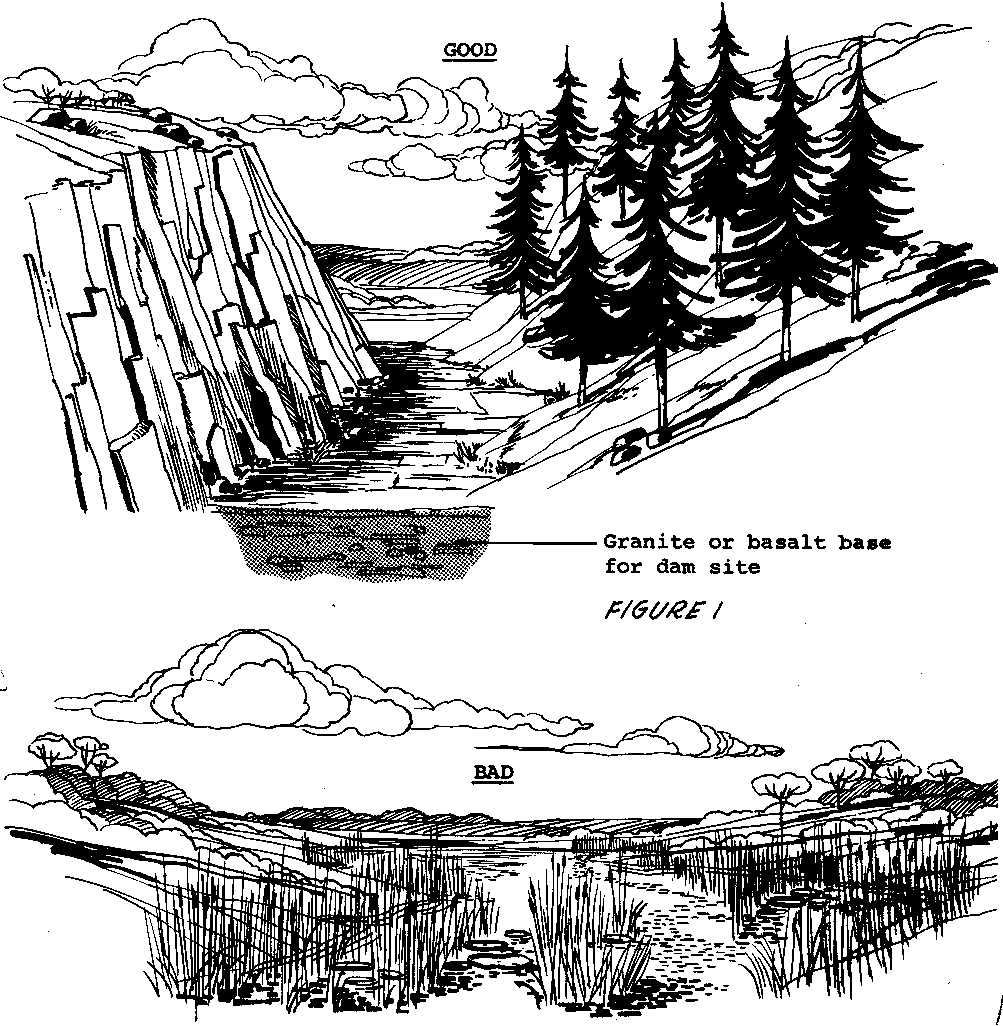
Ground which contains large boulders,
weathered or fissured bedrock, alluvial
sands or porous rock is not good.
The best bases for building a dam are
granite or basalt layers at or near
the surface or a considerable depth
of silty or sandy clay.
Location of a dam
upstream from its
point of use can lower pollution and
may allow for gravity feed of the
water to its point of use.
It is best if stone
is nearby when
building a masonry dam.
When building
an earthen dam, rock will still be required
for the spillway.
The best
soils to use for earth dams contain
clay with some silt or sand.
There
should be enough of this soil close
to the dam site for building the
entire dam of reasonably uniform material.
Careful selection
of the dam site
will save labor and material costs
and help insure a strong dam.
Source:
Water Supply for Rural Areas and Small
Communities, by E. G. Wagner and J. N.
Lanoix, World Health Organization,
Geneva, 1959.
RECIPROCATING WIRE POWER TRANSMISSION
FOR SMALL WATER WHEELS
A reciprocating
wire can transmit
power from a water wheel to a point
up to 0.8km (1/2 mile) away where it
is usually used to pump well water.
These devices have been used for many
years by the Amish people of Pennsylvania.
If they are properly installed,
they give long, trouble-free
service. <see image>
uwr1x117.gif (486x486)
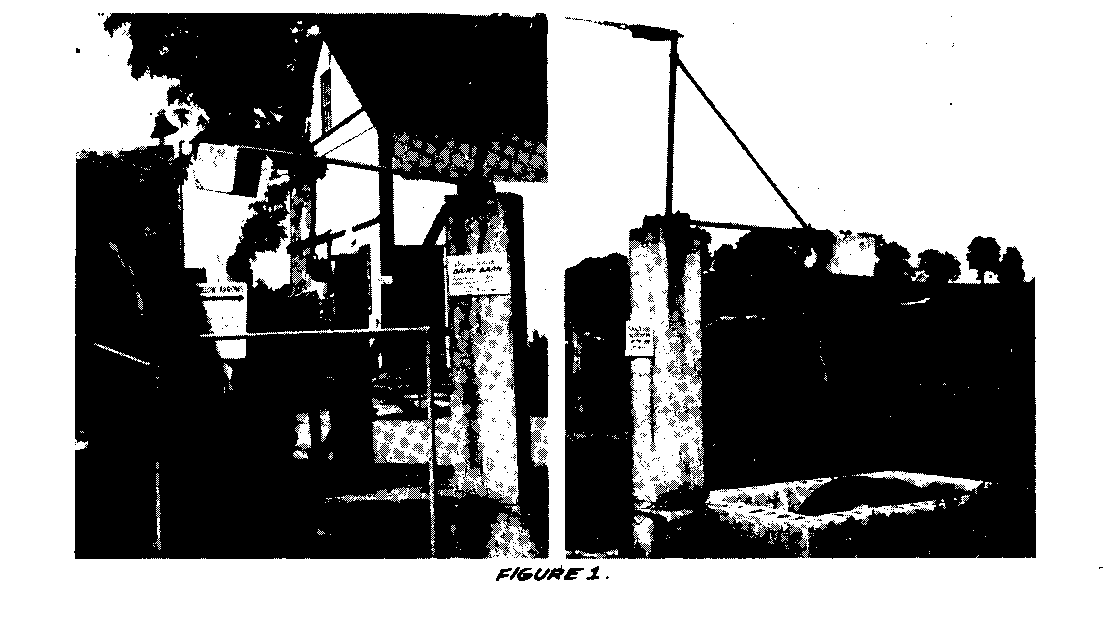
The Amish people
use this method to
transmit mechanical power from small
water wheels to the barnyard, where the
reciprocating motion is used to pump
well water for home and farm use.
The water wheel is typically a small
undershot wheel (with the water flowing
under the wheel) one or two feet
in diameter. The
wheel shaft is
fitted with a crank, which is attached
to a triangular frame which pivots on
a pole (see Figure 2).
A wire is
uwr2x118.gif (600x600)
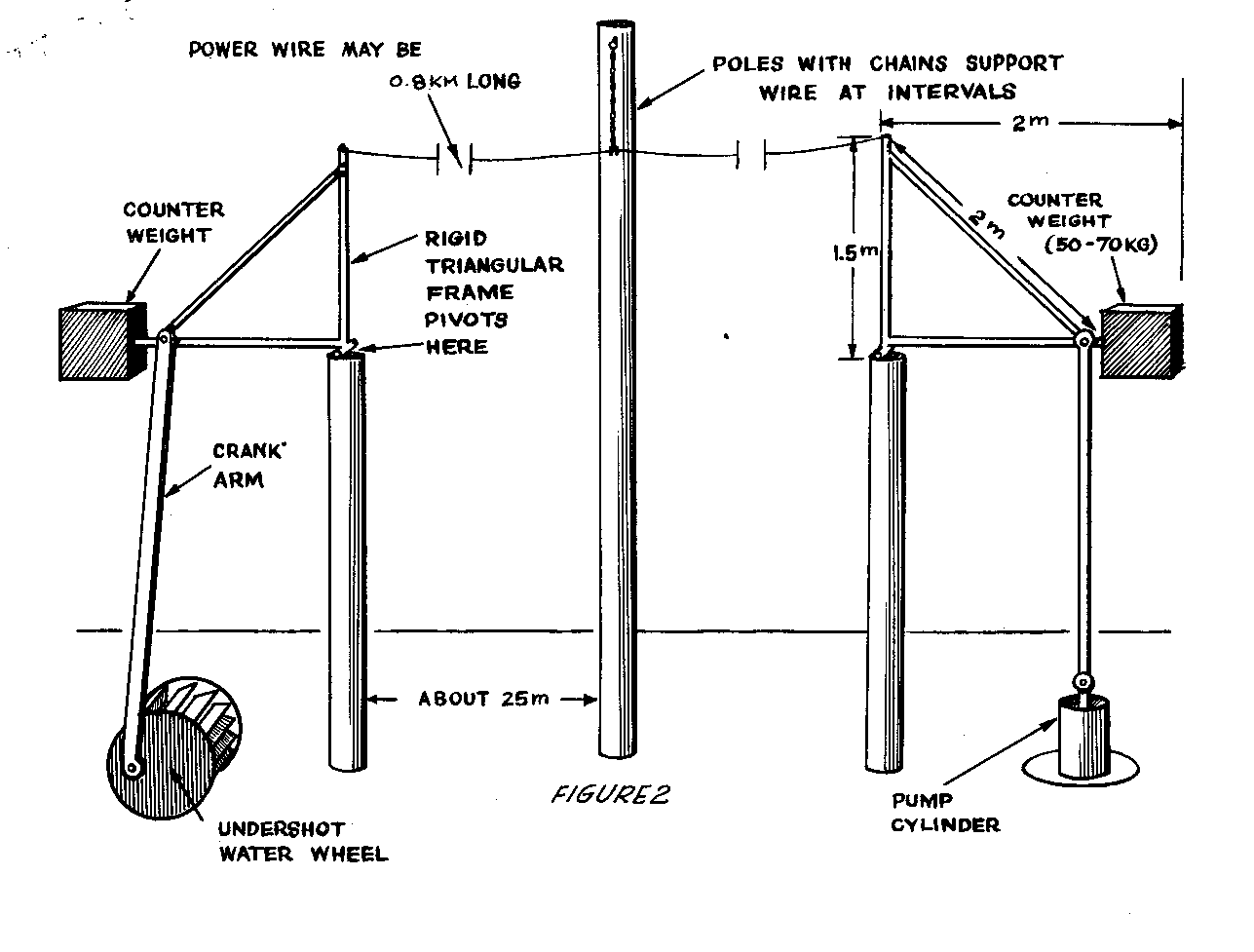
used to connect this frame to another
identical unit located over the well.
Counterweights keep the wire tight.
Tools and Materials
Wire - galvanized smooth fence wire
Water wheel with eccentric crank to
give a motion
slightly less than
largest stroke of
farmyard pump
Galvanized pipe for triangle frames:
2cm (3/4") by 10
meters long (32.8')
Welding or brazing equipment to make
frames
Concrete for counterweight
2 Poles: 12 to 25cm
(6" to 10") in
diameter
As the water wheel turns, the crank
tips the triangular frame back and
forth. This action
pulls the wire back
and forth. One
typical complete back
and forth cycle, takes 3 to 5 seconds.
Sometimes power for several transmission
wires comes from one larger water wheel. <see image>
The wire is mounted
up on poles to
keep it overhead and out of the way.
If the distance from stream to courtyard
is far, extra poles will be
needed to help support the wire.
Amish folks use a loop of wire covered
with a small piece of garden hose
attached to the top of the pole.
The
reciprocating wire slides back and
forth through this loop.
If this is
not possible, try making the pole 1-2
meters higher than the power wire.
Drive a heavy nail near the pole top
and attach a chain or wire from it to
the power wire as shown in Figure 3.
uwr3x119.gif (437x437)
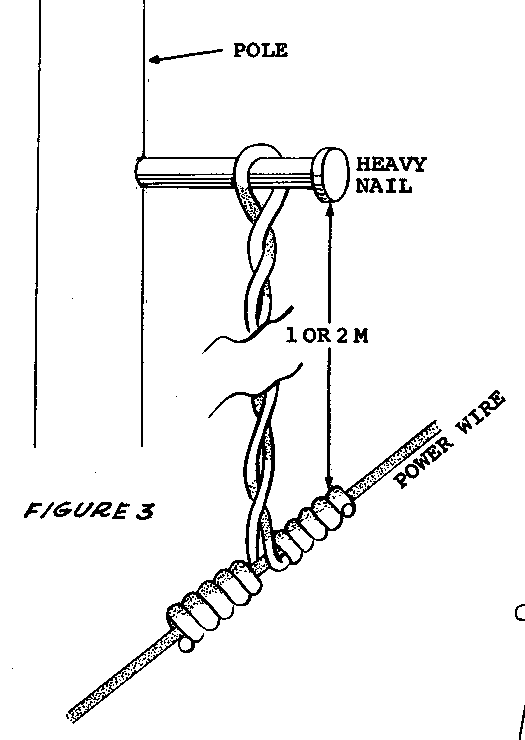
Turns can be made
in order to follow
hedgerows by mounting a small triangular
frame horizontally at the top of
a pole as shown in Figure 4.
uwr4x119.gif (486x486)
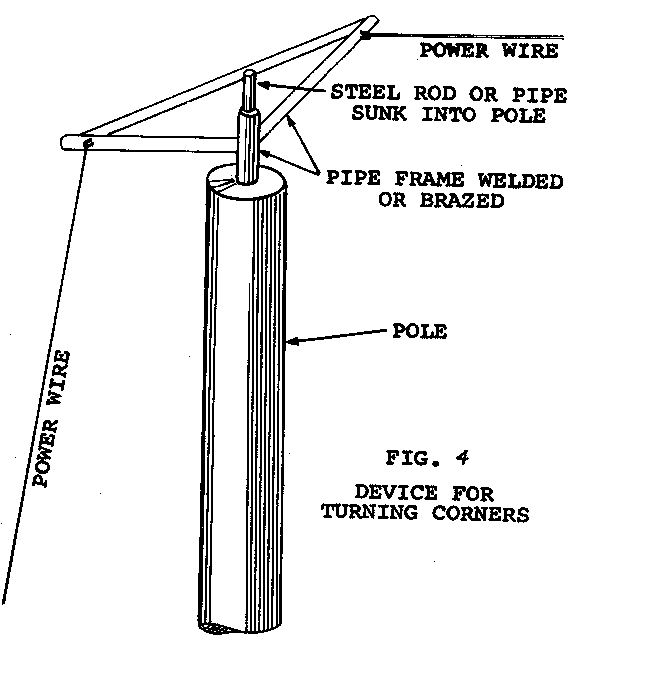
Water Wheel
Figures 5, 6 and 7
show how to build
uwr51200.gif (600x600)
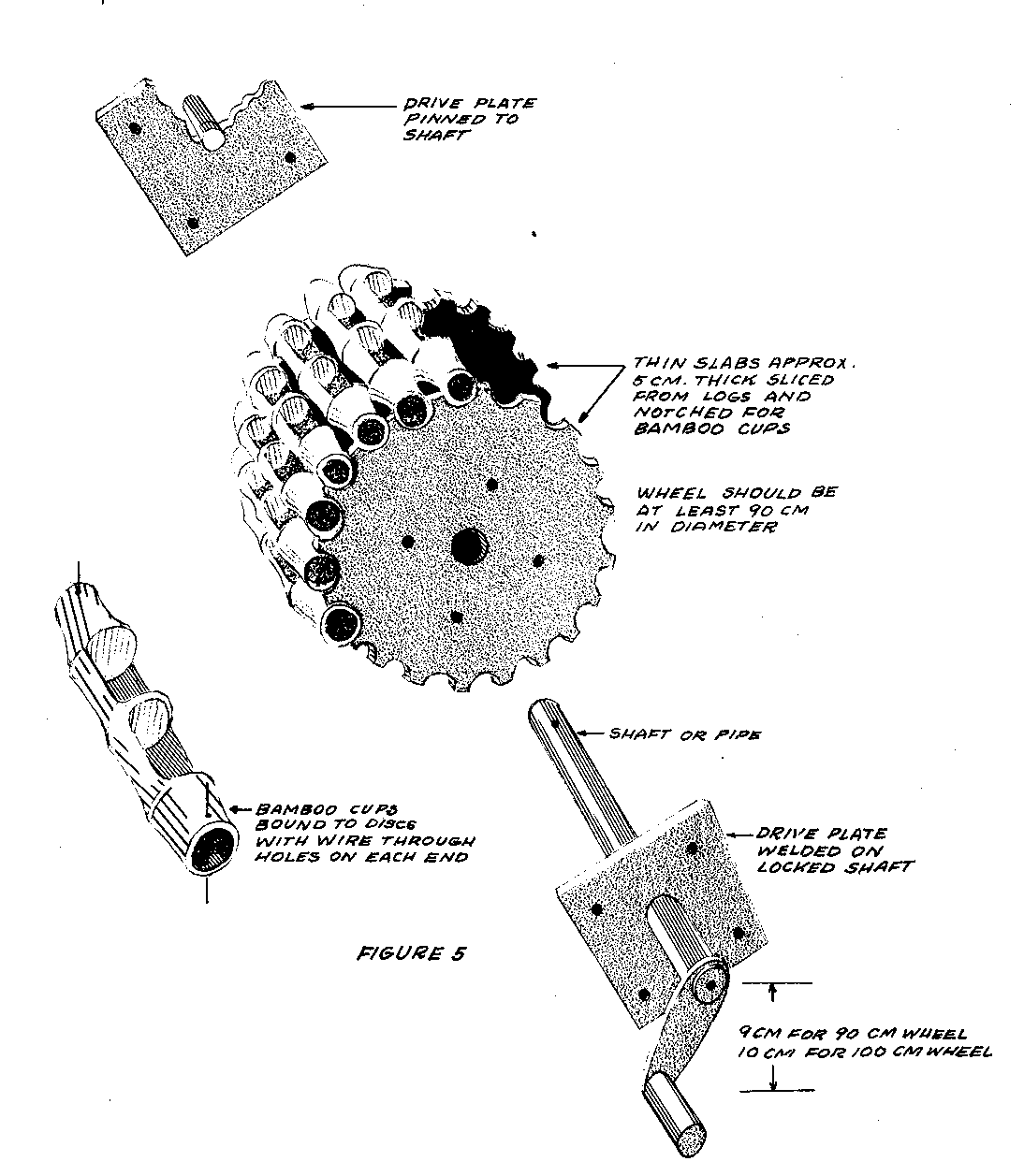
from wood and bamboo.
Source:
New Holland, Pennsylvania VITA Chapter.
Water Purification
The purification of
unsafe water requires
some trained supervision if it
is to be done effectively.
Such supervision
is rarely available in the villages
and the procedure tends to be
neglected sooner or later.
Under
these circumstances every effort must
be made to obtain a source that provides
a naturally wholesome water and
then to collect that water and protect
it against pollution by the methods
already described.
Thus, the necessity
for treatment of the water may
be avoided, and the practical importance
of managing this can hardly be
over-emphasized.
Water treatment
under rural conditions
should be restricted by the responsible
control agency to cases where
such treatment is necessary and where
proper plant operation and maintenance
is assured.
If the water needs
treatment, this
should, if at all possible, be done
for the whole community and certainly
before, or on entry to the dwelling
so that the water from all the taps
in the house is safe.
The practice,
common in the Tropics, of sterilizing
(by filtration and boiling) only the
water to be used for drinking, teeth-cleaning,
etc., though efficient in
itself (when carefully done) is
frequently nullified by carelessness.
Furthermore, children are likely to
use water from any tap.
Contrary
to an all too common opinion, ordinary
freezing of water, though it may
retard the multiplication of bacteria,
does not kill them, and ice from a
household refrigerator is no safer
than the water from which it was made.
The principal
methods of purifying
water on a small scale are, boiling,
chemical disinfection and filtration.
These methods may be used singly or
in combination, but if more than
filtration is needed the boiling or
chemical disinfection should be done
last.
The entries which
follow this general
introduction are:
Boiler for Drinking
Water, Chlorination
of Polluted Water, Water Purification
Plant and Sand Filter.
Boiling is the most
satisfactory way
of destroying disease-producing organisms
in water. It is
equally effective
whether the water is clear or cloudy,
whether it is relatively pure or heavily
contaminated with organic matter.
Boiling destroys all forms of disease-producing
organisms usually encountered
in water, whether they be bacteria,
viruses, spores, cysts or ova.
To be
safe the water must be brought to a
good "rolling" boil (not just simmering)
and kept there for some minutes.
Boiling drives out the gases dissolved
in the water and gives it a
flat taste, but if the water is left
for a few hours in a partly filled
container, even though the mouth of
the container is covered, it will absorb
air and lose its flat, boiled
taste. It is wise to
store the water
in the vessel in which it was boiled.
Avoid pouring the water from one
receptacle to another with the object
of aerating or cooling it as that introduces
a risk of re-contamination.
Chlorine is a good
disinfectant for
drinking water as it is effective
against the bacteria associated with
water-borne disease.
In its usual
doses, however, it is ineffective
against the cysts of amoebic dysentery,
ova of worms, cercariae which cause
schistosomiasis and organisms embedded
in solid particles.
Chlorine is easiest
to apply in the
form of a solution and a useful solution
is one which contains 1 percent
available chlorine, for example,
Milton Antiseptic.
Dakin's solution
contains 0.5 percent available chlorine,
and bleaching powder holds 25 percent to
30 percent available chlorine.
About
37cc (2 1/2 tablespoons) of bleaching
powder dissolved in 0.95 liter (1
quart) of water will give a 1 percent
chlorine solution.
To chlorinate the
water, add 3 drops of 1 percent solution
to each 0.95 liter (1 quart) of
water to be treated (2 tablespoonfuls
to 32 Imperial gallons), mix thoroughly
and allow it to stand for 20 minutes or
longer before using the water.
Chlorine may be
obtained in tablet
form as "Sterotabs" (formerly known
as "Halazone"), "Chlor-dechlor" and
"Hydrochlorazone," which are obtainable
on the market.
Directions for
use are on the packages.
Iodine is a good
disinfecting agent.
Two drops of the ordinary tincture of
iodine are sufficient to treat 0.95
liter (1 quart) of water.
Water that
is cloudy or muddy, or water that has
a noticeable color even when clear,
is not suitable for disinfection by
iodine. Filtering
may render the water
fit for treatment with iodine.
If the
water is heavily polluted, the dose
should be doubled.
Though the higher
dosage is harmless it will give the
water a medicinal taste.
To remove
any medicinal taste add 7 percent
solution of sodium thiosulphate in a
quantity equal to the amount of iodine
added.
Iodine compounds
for the disinfection
of water have been put into tablet form,
for example, "Potable Aqua Tablets,"
"Globaline" and "Individual Water
Purification
Tablets"; full directions for
use are given on the packages.
These
tablets are among the most useful disinfection
devices developed to date
and they are effective against amoeba
cysts, cercariae, leptospira and some
of the viruses.
Source:
Small Water Supplies, Bulletin No. 10,
The Ross Institute, London, 1967.
Other Useful References:
Manual of Individual Water Supply
Systems, Public Health Service Publication
No. 24, U.S. Department of
Health, Education and Welfare,
Washington, D.C. Revised 1962.
Water Supply for Rural Areas and
Small Communities, by Edmund G.
Wagner and J. Lanoix, World
Health Organizations, Geneva, 1959.
BOILER FOR DRINKING WATER
The boiler
described here will provide
safe preparation and storage of
drinking water in areas where pure
water is not available and boiling is
practical. When the
unit has been
used in work camps in Mexico, a 208-liter
(55-gallon) drum has supplied
20 persons with water for a week.
Tools and Materials
208-liter (55-gallon) drum
19mm (3/4") pipe nipple, 5cm (2") long
Bricks for two 30cm (1') layers to
support drum
Sand and 1 sack of cement for mortar
and base of
fireplace
Large funnel and filter medium for
filling drum
Metal plate to control draft in front
of fireplace
19mm (3/4") valve, preferably all metal,
such as a gate
valve, which can withstand
heat
The fireplace for
this unit (see Figure 2)
uwr2x126.gif (600x600)
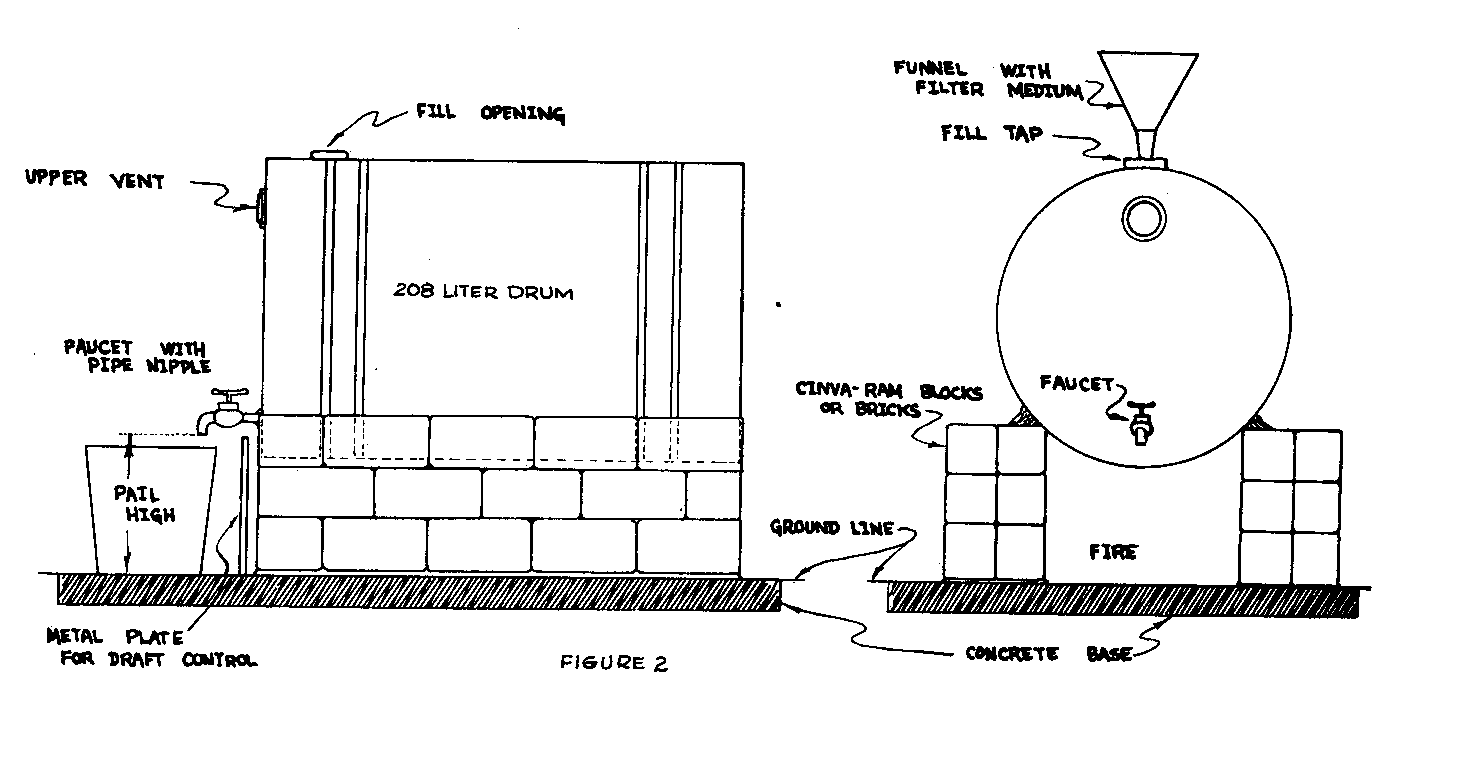
is simple. It should
be oriented
so that the prevailing wind or
draft goes between the bricks from the
front to the back of the drum.
A
chimney can be provided, but it is not
necessary.
When filling the
drum, do not fill
it completely, but leave an air space
at the top as shown in Figure 1.
Replace
uwr1x125.gif (600x600)
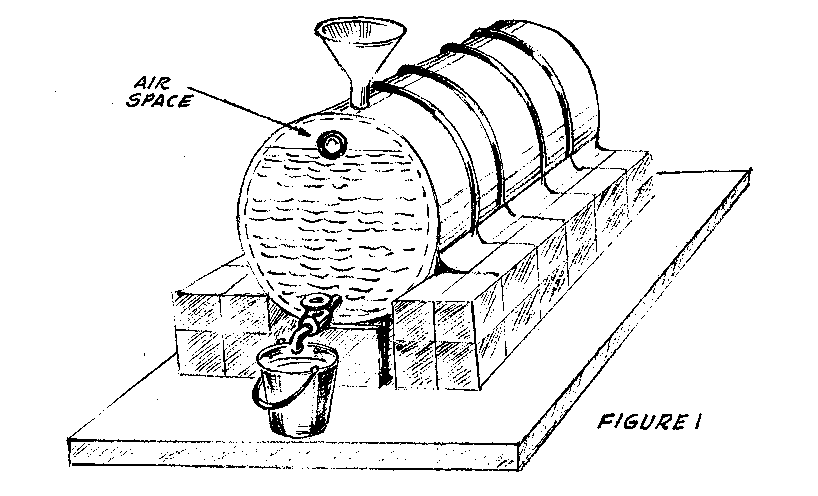
the funnel with a filler plug,
but leave the plug completely loose.
Water must boil at
least 15 minutes
with steam escaping around the loose
filler plug. Make
sure that the
water in the pipe nipple and valve
reach boiling temperature by letting
about 2 liters (2 quarts) of water out
through the valve while the drum is
at full boil.
Source:
Chris Ahrens, VITA Volunteer, Housing
Specialist, Eastern Kentucky Housing
Development Corporation, Inc.
CHLORINATION FOR POLLUTED WATER AND SUPER-CHLORINATION
OF
WELLS, SPRING ENCASEMENTS AND CISTERNS
Chlorination, when
properly applied,
is a simple way to insure and protect
the purity of water.
Guidelines given
here include tables to give a rough
indication of the amounts of chlorine-bearing
chemical needed.
Instructions
are also given for super-chlorination
for disinfecting newly built or repaired
wells, spring encasements or
cisterns.
Chlorine-bearing compounds
are used because pure chlorine is
difficult and dangerous to use.
The amounts of
chlorine suggested
here will normally make water reasonably
safe. A
water-treatment system
should be checked by an expert.
In
fact, the water should be tested periodically
to make sure that it remains
safe. Otherwise, the
system itself
could become a source of disease.
Tools and Materials
Container to mix chlorine
Chlorine in some form
Scale to weigh additive
The safest way to
treat water for
drinking is to boil it (see "Boiler
for Drinking Water").
However, under
controlled conditions, chlorination
is a safe method; it is often more
convenient and practical than boiling.
Proper treatment of water with chlorine
requires some knowledge of the process
and its effects.
When chlorine is
added to water, it
attacks and combines with any suspended
organic matter as well as some minerals
such as iron. There
is always a certain
amount of dead organic matter in water,
as well as live bacteria, virus and
perhaps other types of life.
Enough
chlorine must be added to oxidize all
of the organic matter, dead or alive,
and to leave some excess uncombined/
or "free" chlorine.
This residual free
chlorine prevents recontamination.
Residual chlorine in water is not harmful,
because water which contains a
harmful amount of chlorine is extremely
distasteful.
Some organisms are
more resistant to
chlorine than others.
Two particularly
resistant varieties are amoebic cysts
(which cause amoebic dysentery) and the
cercariae of schistosomes (which cause
bilharziasis or schistosomiasis).
These,
among others, require much higher levels
of residual free chlorine and longer
contact periods than usual to be safe.
Often special techniques are used to
combat these and other specific diseases.
It always takes
time for chlorine to
work. Be sure that
water is thoroughly
mixed with an adequate dose of the
dissolved chemical, and that it stands
for at least 30 minutes before consumption.
Polluted water
which contains large
quantities of organic matter, or cloudy
water, is not suitable for chlorination,
It is best, and safest, to choose the
clearest water available.
A settling
tank, and simple filtration can help
reduce the amount of suspended matter,
especially particles large enough to
see. Filtration that
can be depended
upon to remove all of the amoebic cysts,
schistosomes, and other pathogens
normally requires professionals to set
up and operate.
NEVER depend on
home-made filters
alone to provide drinking water.
However,
a home-made slow sand filter is
an excellent way to prepare water for
chlorination.
Depending on the
water to be treated,
varying amounts of chlorine are needed
for adequate protection.
The best way
to control the process is to measure
the amount of free chlorine in the
water after the 30 minute holding period.
A simple chemical test which uses
a special organic indicator called
orthotolidine can be used.
Orthotolidine
testing kits available on the
market come with instructions on their
use.
When these kits are
not available,
the chart in Figure 3 can be used as
uwr3x128.gif (600x600)
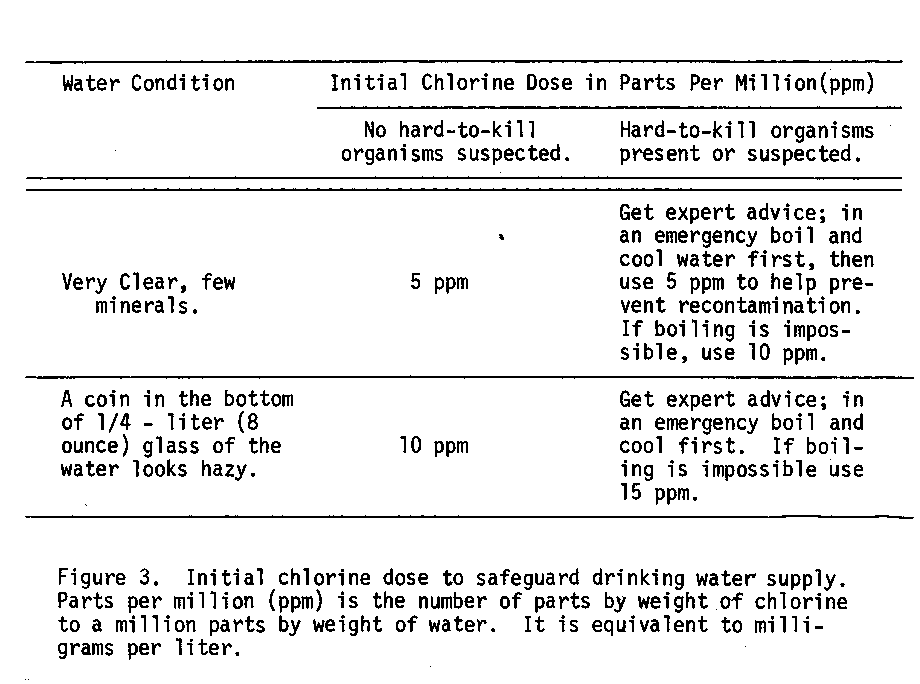
a rough guide to how strong a chlorine
solution is necessary.
The strength
of the solution is measured in parts
by weight of active chlorine per million
parts by weight of water, or "parts per
million" (ppm).
The chart in Figure
4 gives the
uwr4x128.gif (600x600)
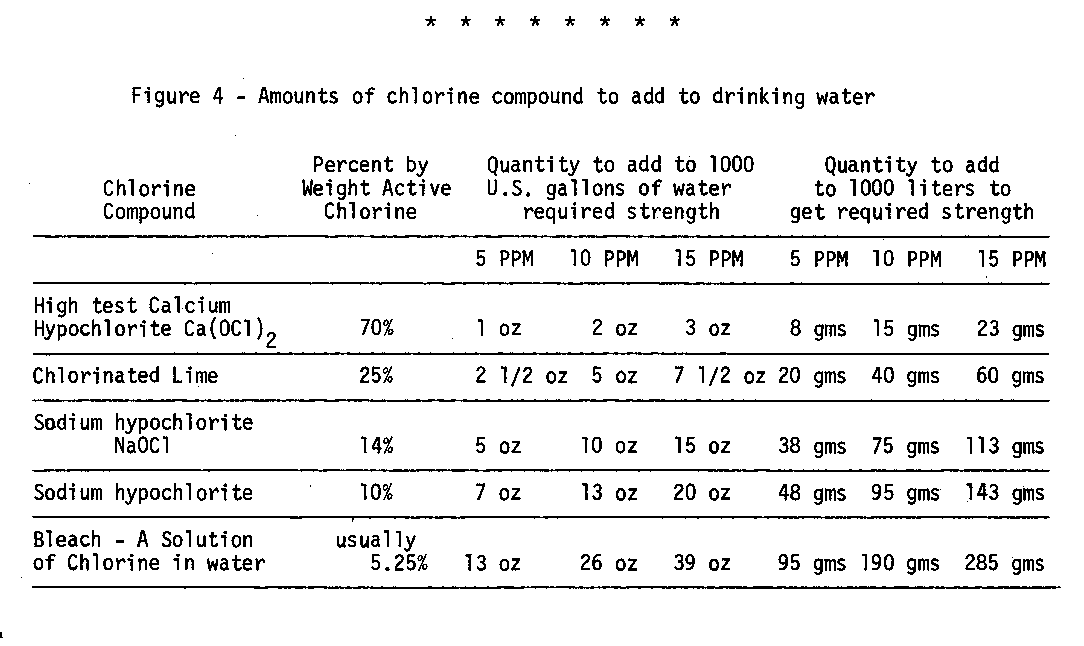
amount of chlorine-compound to add
to 1000 liters or to 1000 gallons of
water to get the solutions recommended
in Figure 3.
Usually it is
convenient to make up a
solution of 500 ppm strength which
can then be further diluted to give
the chlorine concentration needed.
The 500 ppm solution must be stored
in a sealed container in a cool dark
place, and should be used as quickly
as possible since it does lose strength.
Modern chlorination plants used bottled
chlorine gas, but this can only be used
with expensive machinery by trained
experts.
Super-chlorination
Super-chlorination means applying a
dose of chlorine which is much stronger
than the dosage needed to disinfect
water. It is used to
disinfect new
or repaired wells, spring encasements
and cisterns. The
chart in Figure 5
uwr5x129.gif (600x600)
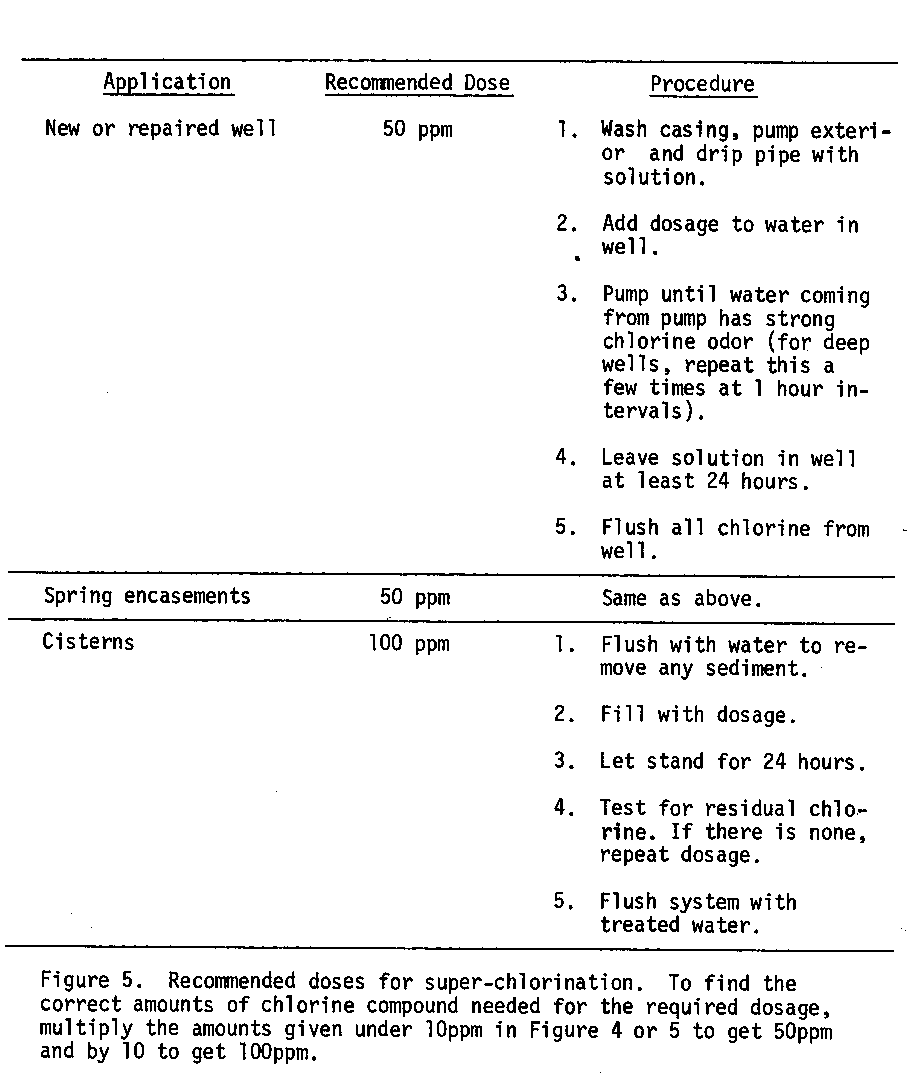
gives recommended doses.
Example 1:
A water-holding
tank contains 8000
U.S. gallons. The
water comes from
a rapidly moving mountain stream and
is passed through a sand filter before
storage. How much
bleach should be
added to make this water drinkable?
How long should the water be mixed
after adding?
Solution:
In this case 5 ppm
are probably sufficient
to safeguard the water (from
Figure 3.) To do
this with bleach
requires 13 ounces per 1000 gallons.
Therefore the weight of bleach to be
added is 13 x 8 or 104 ounces.
Always mix
thoroughly, for at least
a half hour. A good
rule of thumb is
to mix until you are certain that the
chemical is completely dissolved and
distributed and then ten minutes longer.
In this case, with an 8000-gallon
tank, try to add the bleach to several
different locations in the tank
to make the mixing easier.
After
mixing, test the water by sampling
different locations, if possible.
Check the corners of tank especially.
Example 2:
A new cistern has
been built to
hold water between rainstorms.
On its
initial filling it is to be super-chlorinated.
How much chlorinated
lime should be added? The cistern is
2 meters in diameter and 3 meters high.
Solution:
First calculate the
volume of water.
For a cylinder, Volume is [pi][D.sup.2] H (D
-------------
4
is diameter, H is height and [pi] is 3.14.)
Here D = 2 meters H = 3 meters.
V = 3.14 x (2
meters) x (2 meters)
------
4
x (3 meters)
V = 9.42 cubic
meters = 9,420 liters.
(Each cubic meter contains 1000 liters.)
From Figure 5 we learn that a cistern
should be super-chlorinated with 100
ppm of chlorine.
From Figure 4, we
learn that it takes 40 grams of
chlorinated lime to bring 1000 liters
of water to 10 ppm Cl.
To bring it to
100 ppm, then, will require ten times
this amount, or 400 grams.
400 grams
x 9.42 thousand liters =
---------------
thousand liters
3768 grams.
Source:
Environmental Sanitation, by J. S.
Salvato, John Wiley & Sons, Inc.,
New York, 1958.
Field Water Supply, TM 5-700.
WATER PURIFICATION PLANT
The water
purification plant described
here uses laundry bleach as a source of
chlorine. Although
this manually-operated
plant is not as reliable as a
modern water system, it will provide
safe drinking water if it is operated
according to instructions.
Many factors in
this system require
operating experience.
When starting
to use the system, it is safest to have
the assistance of an engineer experienced
in water supplies.
Tools and Materials
3 Barrels, concrete tanks or 208 liter
(55-gallon drums)
20cm (8") funnel, or sheet metal to
make a funnel
2 Tanks, about 20 liters (5 gallons)
in size
4 Shut-off valves
Throttle or needle valve (clamps can be
used instead of valves
if hose is
used)
Pipe or hose with fittings
Hypochlorite of lime or sodium hypochlorite
(laundry bleach)
The water
purification plant is made
as in Figure 6. The
two at the top of
uwr6x132.gif (600x600)
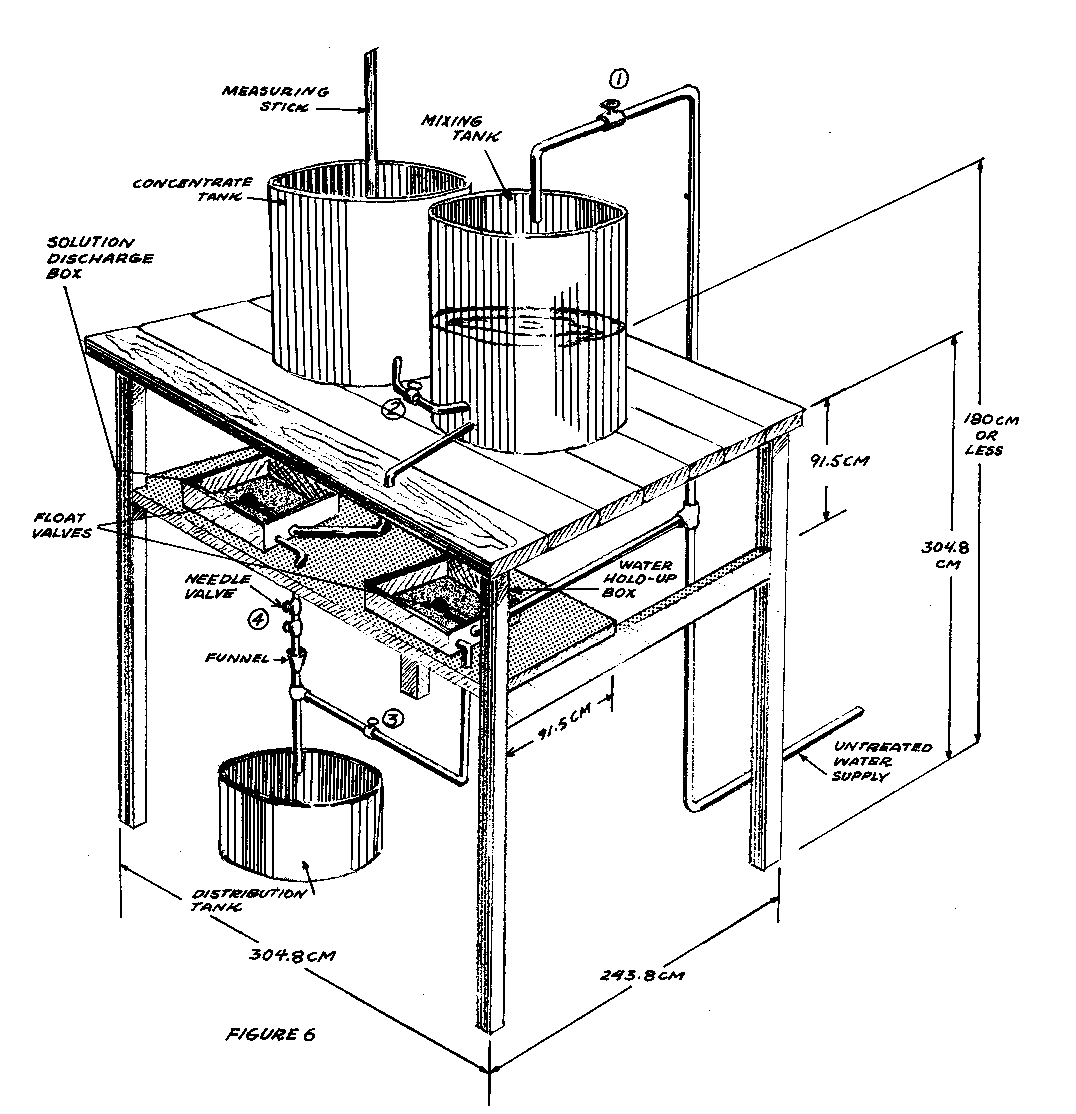
the structure are for diluting the
bleach. (The system can
be simplified
by eliminating the concentrate tank;
the bleach is then added directly to
the mixing tank.
The two smaller
tanks on the shelf
below are for holding equal amounts
of diluted bleach solution and water
at a constant pressure; this makes the
solution and the water flow at the
same speed into the hoses which lead
to the mixing point.
The mix, which
can be seen through the open funnel, is
further controlled by the valves.
If a
needle or throttle valve is not available
a throttle action can be obtained
by installing another shut-off valve in
series with Valve #4.
Placing the two
barrels at a height
of less than 1.8 meters (6') above the
float valve causes a pressure of less
than 0.35kg per square centimeter (5
pounds per square inch).
Thus, the
plumbing does not have to be of high
quality except for Valve #1 and the
float valve of the water hold-up tank,
if the water supply is under higher
pressure.
Operation
A trial and error
process is necessary
to learn how much concentrate should be
put in the concentrate tank, how much
concentrate should flow into the mixing
tank and how much solution should be
allowed past the funnel.
A suggested
starting mixture is 1/4 liter (1/2 pint)
of concentrated bleach for a mix tank
capacity of 190 liters (50 gallons) to
treat 1900 liters (500 gallons) of
water.
The water in the
distribution tank
should have a noticeable chlorine taste.
The amount of bleach solution required
depends on how dirty the water is.
1. Mix concentrated
bleach with water
in the
concentrate tank with all
valves
closed. The mixing tank
should be empty.
2. Fill the pipe
from the mixing tank
to the solution
tank with water
after having
propped the float valve
in a closed
position.
3. Let a trial
amount of concentrate
flow into the
mixing tank by opening
Valve #2.
4. Use a measuring
stick to see how
much concentrate
was used.
5. Close Valve #2
and open Valve #1 so
that untreated
water enters the mixing
tank.
6. Close Valve #1
and mix solution in
the mixing tank
with a stick.
7. Remove the prop
from the float valve
of the solution
tank so that it will
operate properly.
8. Open wide the
needle valve and Valve
#4 to clean the
system. Let 4
liters (1 gallon)
drain through the
system.
(Steps 2, 7 and 8 can be
omitted after the
first charging of
the system, if
the pipe mentioned
in the second
step is not permitted
to empty before
recharging the mixing
tank.)
9. Close down the
needle valve until
only a stream of
drops enters the
funnel.
10. Open Valve #3.
The flow into the
funnel and the taste
of the water in the distribution tank
should be checked regularly to insure
proper treatment.
Source:
Chris Ahrens, VITA Volunteer, Eastern
Kentucky Housing Development Corporation.
Inc.
SAND FILTER
Surface water from
streams, ponds or
open wells is very likely to be contaminated
with leaves and other organic
matter. A gravity
sand filter can remove
most of this suspended organic
material, but it will always let virus
and some bacteria pass through.
For
this reason, it is necessary to boil or
chlorinate water after it has been
filtered.
Although sand
filtration does not make
polluted water safe for drinking, a
sand filter which is properly built and
maintained will prepare water for boiling
or chlorination.
Sand filters must
be cleaned periodically.
The household sand
filter described
here should deliver 1 liter (1 quart)
per minute of clear water, ready for
boiling or chlorinating.
Tools and Materials
Steel drum: at least 60cm wide by 75cm
(2' x 29 1/2")
Sheet metal, for cover: 75cm (29 1/2")
square
Wood: 5cm x 10cm (2" x 4"), 3 meters
(9.8') long
Sand: 0.2 cubic meter (7 cubic feet)
Gravel
Blocks and nails
Pipe, to attach to water supply
Optional: valve and asphalt roofing
compound to treat
drum
The gravity sand
filter is the easiest
type of sand filter to understand
and set up. The
gravity filter uses
sand to strain suspended matter from
the water, although this does not always
stop small particles or bacteria.
Over a period of
time, a biological
growth forms in the top 7.5cm (3")
of sand. This film
increases the
filtering action. It
slows the flow
of water through the sand, but it
traps more particles and up to 95
percent of the bacteria.
The water
level must always be kept above the
sand to protect this film.
Sand filters can
get partially
clogged with organic matter; under
some conditions this can cause bacterial
growth in the filter.
If the
sand filter is not operated and maintained
correctly, it can actually add
bacteria to the water.
By removing most of
the organic
matter, the filter:
1. Removes larger
worm eggs, cysts,
and cercariae,
which are difficult
to kill with
chlorine.
2. Allows the use of
smaller and
fixed doses of
chlorine for disinfection,
which results in
drinkable
water with less
taste of chlorine.
3. Makes the water
look cleaner.
4. Reduces the
amount of organic
matter, including
living organisms
and their food,
and the possibility
of
recontamination of the water.
The drum for the
sand filter shown
in Figure 7 should be of heavy steel.
uwr7x135.gif (600x600)
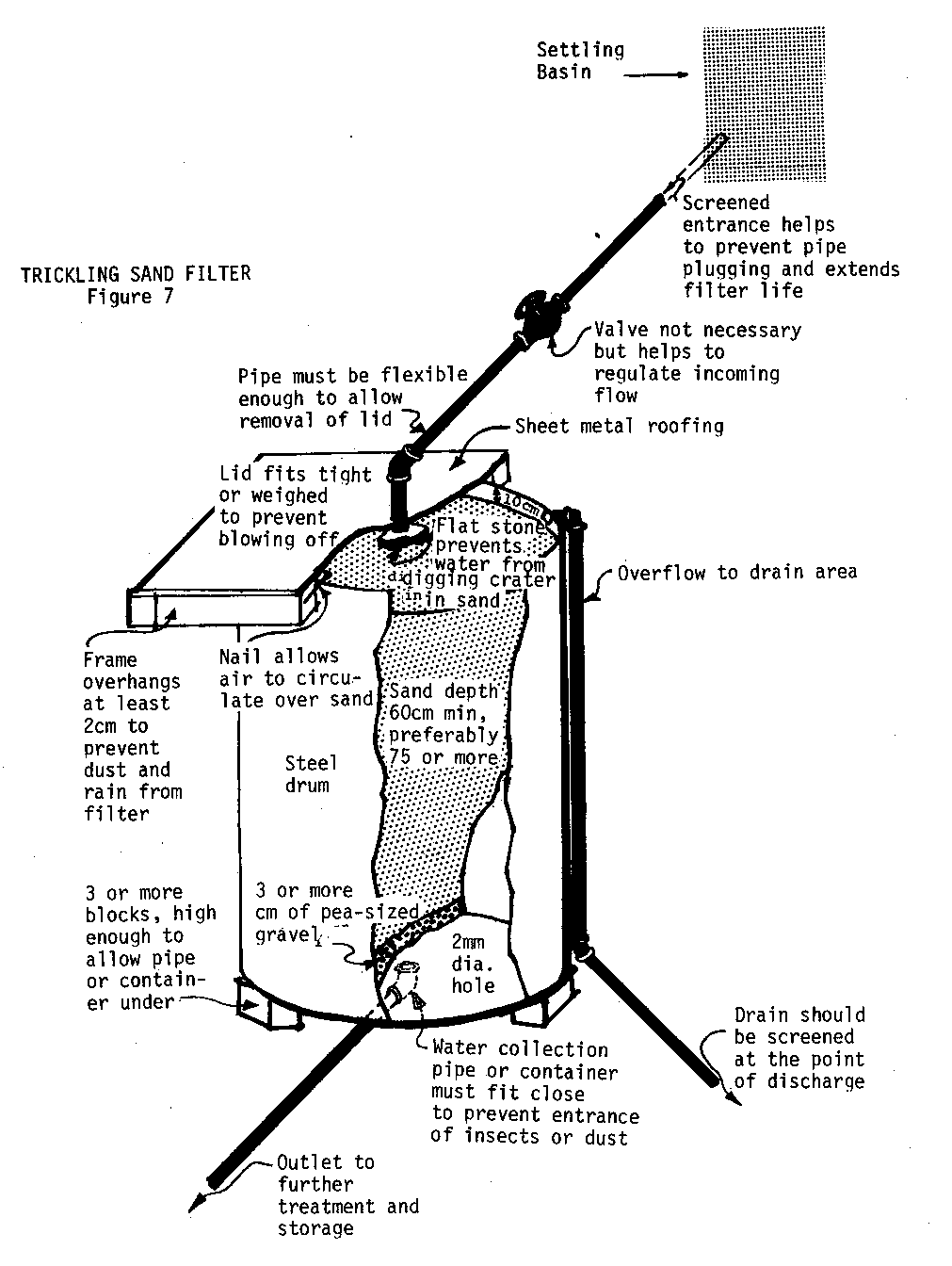
It can be coated with asphalt material
to make it last longer.
The 2mm
(3/32") hole at the bottom regulates
the flow: it must not be made larger.
The sand used
should be fine enough
to pass through a window screen.
It
should also be clean; it is best to
wash it.
The following
points are very important
in making sure that a sand filter
operates properly:
1. Keep a continuous
flow of water
passing through
the filter. Do
not let the sand
dry out, because
this will destroy
the microorganisms
which form a film
on the surface
layer of sand.
The best way to insure
a continuing flow
is to set
the intake so
that there is always
a small overflow.
2. Screen the intake
and provide a
settling basin to
remove as many
particles as
possible before the
water goes into
the filter. This
will keep the
pipes from becoming
plugged and
stopping the flow of
water.
It will also help the
filter to operate
for longer periods
between
cleanings.
3. Never let the
filter run faster than
3.6 liters per
square meter per minute
(4 gallons per
square foot per
hour) because a
faster flow will
make the filter
less efficient by
keeping the
biological film from
building up at
the top of the sand.
4. Keep the filter
covered so that it
is perfectly dark
to prevent the
growth of green
algae on the surface
of the sand.
But let air
circulate above
the sand to help
the growth of the
biological film.
5. When the flow
becomes too slow to
fill daily needs,
clean the filter:
Scrape off and discard the top
1/2cm (1/4")
of sand and rake or
scratch the
surface lightly.
After several
cleanings, the sand
should be raised to its original height
by adding clean sand.
Before doing
this, scrape the sand in the filter
down to a clean level.
The filter
should not be cleaned more often than
once every several weeks or even months,
because the biological growth at the
top of the sand makes the filter more
efficient.
Source:
Water Supply for Rural Areas and Small
Communities, by Edmund G. Wagner and
J. N. Lanoix, World Health Organization,
Geneva, 1959.
The plane table
described here can
be used for mapping villages, roads,
trenches and fields.
This type of
plane table has been widely used by
professional surveyors.
Tools and Materials
Some boards of soft wood, about
1858 square
centimeters (2 square feet)
approximately 2.5cm
(1") thick
Some boards of a fairly strong wood,
19mm (3/4") to
2.5cm (1") thick, and
at least 1m (3')
long
7 bolts, 6mm (1/4") in diameter and
5cm (2") long
Nuts for each of the bolts, preferably
wing nuts, and
washers
Saw
Drill and 6mm (1/4") bit
Drawing Surface
From the soft wood,
make a flat drawing
surface. The one
shown in Figure 1
uwr1x137.gif (486x486)
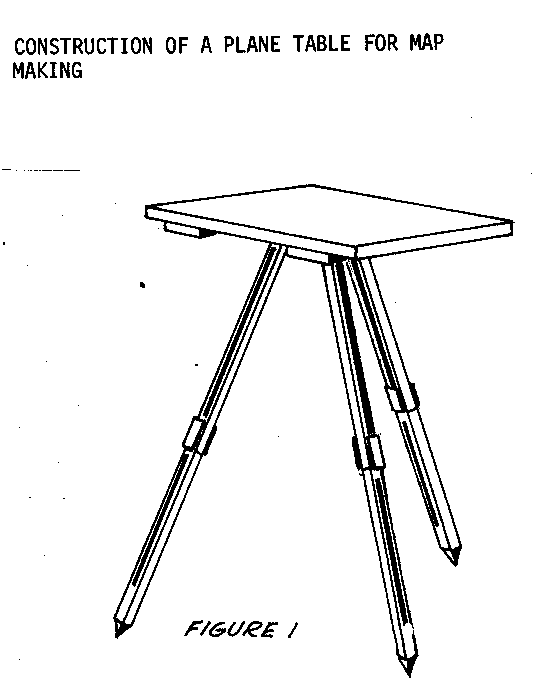
is 40.5cm x 53.5cm (16" x 21") but any
dimension of this general size-range
is satisfactory. The
surface should
be sanded smooth and should be soft
enough to permit easy use of thumb
tacks and pins.
Pivot
To allow the table
to be rotated
on the tripod, a pivot is required.
In the illustration, two 15cm (6")
circles of 2.5cm (1") wood were cut.
A 6mm (1/4") hole was drilled in the
center of each circular block and one
of the 6mm (1/4") bolts used as an
axis. The head of
the bolt was counter
sunk so that a flush surface was available
for nailing or screwing the upper
block to the under side of the drawing
board. This block
should be centered.
Tripod Legs
The tripod legs are
extendable, As
Figures 2 and 3 show, each leg has two
uwr21380.gif (437x437)
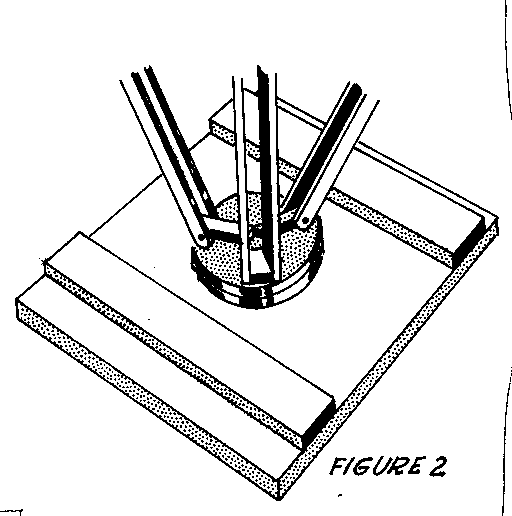
(3/8" x 3/4" x 32"), and a slotted
center piece, 2.5cm x 16mm x 71.1cm
(1" x 5/8" x 28"), which has been pointed
at one end.
The legs are now
assembled as follows:
One end of two side rails is rounded
in the 19mm (3/4") direction and a 6mm
(1/4") hole is drilled 13m (1/2") in
from that end. A 6mm
(1/4") hole is
also drilled 15cm (6") from the other
end.
Two wooden plates,
10mm x 4.5cm x
12.7cm (3/8" x 1 3/4" x 5") are nailed
one on each side of the pair of side
rails at the unrounded end.
See Figure 3.
uwr3x138.gif (393x393)
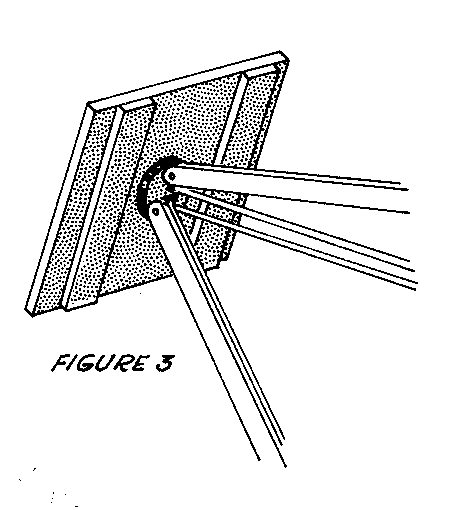
This plate should space the
side rails, such that the center piece
may move reasonably freely but not be
loose. The 6mm
(1/4") wide slot in
the 16mm (5/8") dimension (which extends
most of the length of the center
piece) will permit a 6mm (1/4") bolt
to pass through. The
blunt end of
the center piece has been inserted
up through the opening formed by the
two plates and the two side rails:
a 6mm (1/4") bolt may be passed through
the hole in one side rail, through the
slot in the center piece and then
through the 6mm (1/4") hole in the
other side rail; the wing nut is then
put on. See Figure
4.
uwr4x138.gif (587x587)
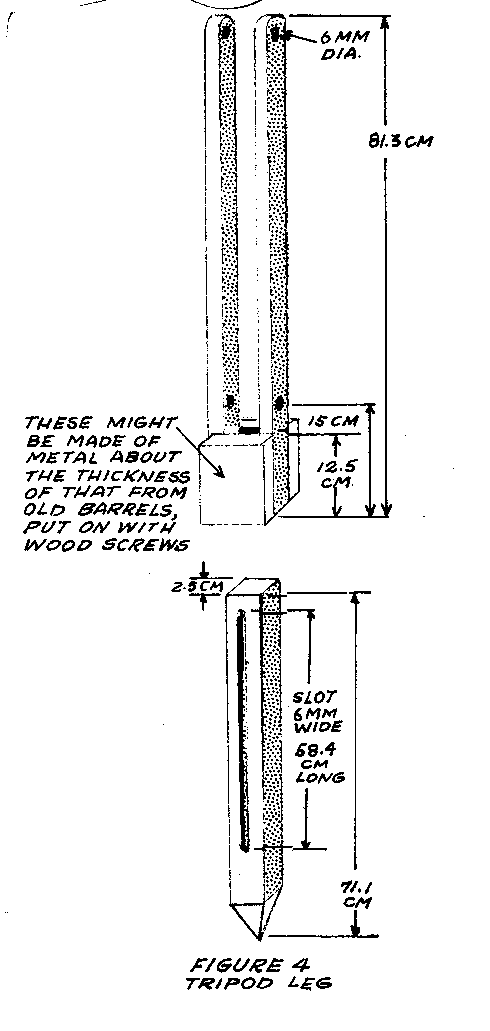
In order to affix
the two side
rails to the lower block, the latter
must be cut away in a fashion to space
the side rails 2.5cm (1") apart.
It
must be cut back somewhat more than
the width, 22mm (7/8"), of the side
rail. This lower
block is cut away
in this manner in three equally spaced'
locations, so that the legs will be
equally spaced. A
6mm (1/4") hole
is then drilled in line with the previously
drilled holes in the rounded
ends of the side rails.
A 6mm (1/4")
bolt may then be inserted through the
three holes and a nut placed on the
other end. See
Figure 5.
uwr5x139.gif (353x353)

An alternate method
of making the
lower block, which will make the block
stronger and should be used when it is
made from soft wood, is shown in Figure 6.
uwr6x139.gif (540x540)
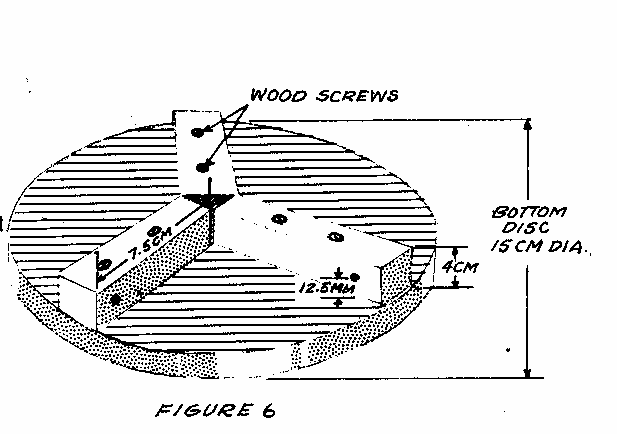
Three blocks of wood, 2.5mm x
3.8cm x 7.6cm (1" x 1 1/2" x 3"), are
screwed to the 15cm (6") diameter
lower block. A 6mm
(1/4") diameter
hole is drilled 13mm (1/2") from the
end of each block, in the direction
of the 2.5cm (1") thickness, to allow
for attaching the leg.
The advantage of
this method is the
strength obtained by having the grain
of the wood always at right angles to
the bolt holding the leg in place.
In the first method the grain will be
parallel to one of the bolts and it
will break if it is handled roughly,
as it probably will be.
It is now possible
to (1) change the
length of the legs so that the table
can be accommodated to sloping ground;
(2) to change the spread of the legs
to better accommodate setting up the
table on rough grounds and; (3) rotate
the drawing board in relation
to the tripod.
The blown-up
drawing in Figure 7
uwr7x140.gif (600x600)
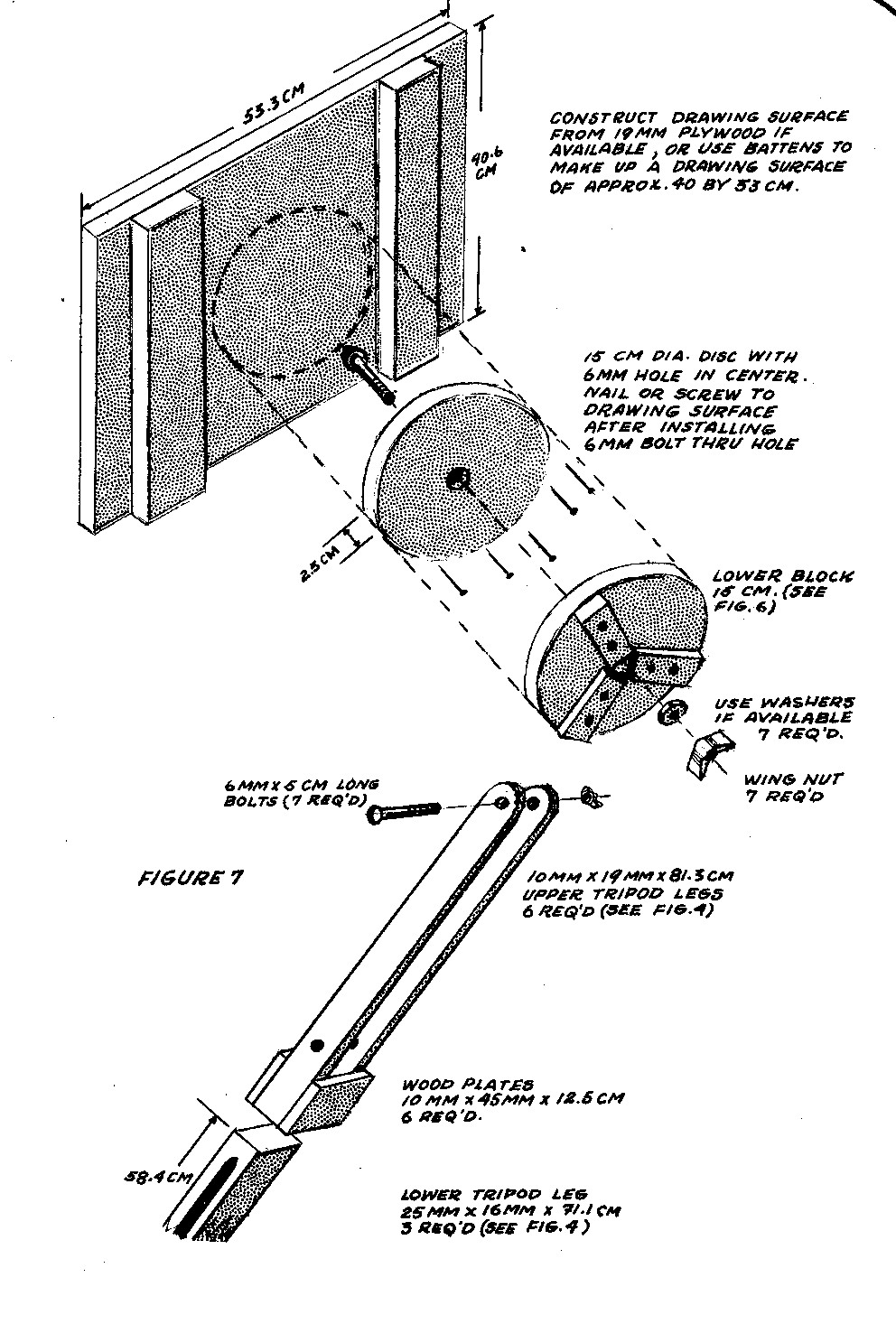
will be helpful in assembling the
plane table. A table
whose legs cannot
be extended would still be useful.
In this case, use single pieces, 22mm
x 45mm x 142cm (7/8" x 1 3/4" x 56"),
which are pointed on one end and cut
away at the other end to allow for the
same sort of connection to the lower
end.
Source:
Dr. Robert G. Luce, VITA Volunteer,
Schenectady, New York
Dale B. Fritz, Village Technology
Director, VITA.
Ray Gomez, VITA Volunteer, Arcadia,
California
MAP-MAKING USING A PLANE TABLE
Instructions are
given here for making
serviceable maps using a plane table.
Such maps are valuable for irrigation,
drainage and village layout plans.
Before aerial
photography, most topographical
maps were made by the use of
plane tables.
Tools and Materials
Plane table (see preceding entry)
Paper
Pencil
Ruler
Pins
Tape measure (optional)
Spirit level (optional)
Measuring Pace
If no long tape
measure is available,
the first step for a map maker
is to measure his pace: A 30-meter
(100-foot) distance should be measured
out on level ground.
If only a 30cm
(12") ruler is available, this can
be used to mark out a meter (3' or 4')
on a stick; this stick in turn can
be used to measure the 30m (100').
Being careful to walk normally, the
map maker then counts the number of
paces he takes in walking the 30m
(100') interval.
Simple division
will then give the average length of
a pace.
Map Scale
The next step is to
decide on a
scale for the map.
This is determined
by judging the longest distance
to be mapped and the size of the map
desired. The map
does not have to be
made on a single sheet of paper; it
can be pieced together from several
sheets when it is completed.
For
example: if you want a map 80cm
(2 1/2') long of an area whose longest
dimension is 800 meters (1/2 mile
or 2540 feet), then a scale of 1 meter
to 1cm (100 feet to the inch) would
be convenient.
Map Making
1. Place paper on
the plane table and
orient the plane table on or near some
principal feature of the area; for
example, a path, road, creek or tree.
2. Place a pin
vertically in the spot
on the map to locate this feature.
3. Make the plane
table level; for
example, by using a spirit level.
If
a spirit level is not available, you
can level the table by using anything
which rolls easily.
4. Rotate the table
to a proper
orientation, so that the map will be
made in the desired direction.
5. Sight along the
first pin to another
principal feature which is visible from
the table location (a bend in a road,
a hill or any feature which will tie
the map together, moving the second pin
into the line of sight (see Figure 1).
uwr1x141.gif (393x393)
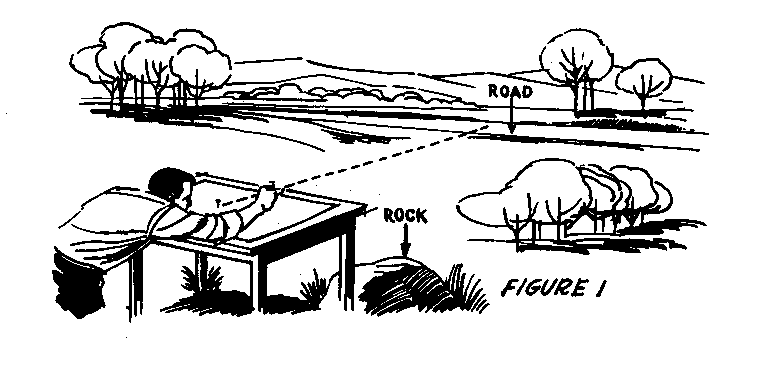
A ruler can be used for this purpose
if it has a sighting edge; a sighting
edge can be made by sticking a couple
of pins into the ruler.
6. Draw a line in
the direction defined
by the two pins.
7. Measure the
distance to the feature
observed either by pacing or with a
tape measure.
8. Scale this
distance along the line
drawn on the map, starting at the first
pin.
9. Repeat this
process for other
principal features which can be seen
from this location (see Figure 2).
uwr2x142.gif (437x437)
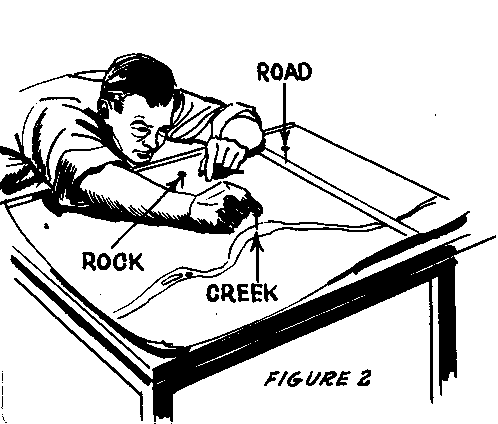
10. When this has
been done, move
the table to one of the points just
plotted, selecting one which will
enable you to move over the area
conveniently. For
example, follow
a lane or creek or some feature
which ties things together.
11. Set the plane
table over this
point and re-orient the table by
putting pins in the map at the present
and previous locations.
This procedure
locates the line joining the two locations
on the map in the same direction
as the line exists in nature, making it
possible to go on to the next step with
the map oriented properly.
12. From this new
location, map in the
principal features which can be conveniently
sighted.
In this way the
entire region to be
mapped may be covered in a systematic
way. If gaps appear
or if more detail
is needed, go back and set up over
some mapped feature, reorient the map
by sighting on a second feature, and
proceed to map in the detail.
To map features
which are not going
to be used as plane table locations in
the mapping process, draw a line in
the direction of each feature from two
plane-table locations.
The intersection
of these two lines corresponding
to a single feature locates the
feature on the map.
This avoids the
need for measuring distances.
Note,
however, that the distances between
plane-table locations must be measured.
Relative Elevations
If a spirit level
is available, it
is possible to level the plane table
accurately and, using a ruler or
other sighting device, plot relative
elevations on the map.
A stick about 2 or
3 meters (6' or
8') long should be marked off in
centimeters (inches).
A person holding
the stick vertically can, by moving his
finger up or down, identify to the
person sighting the distance up from
the ground through which the line of
sight passes.
Source:
Dr. Robert G. Luce, VITA Volunteer,
Schenectady, New York
========================================
========================================

